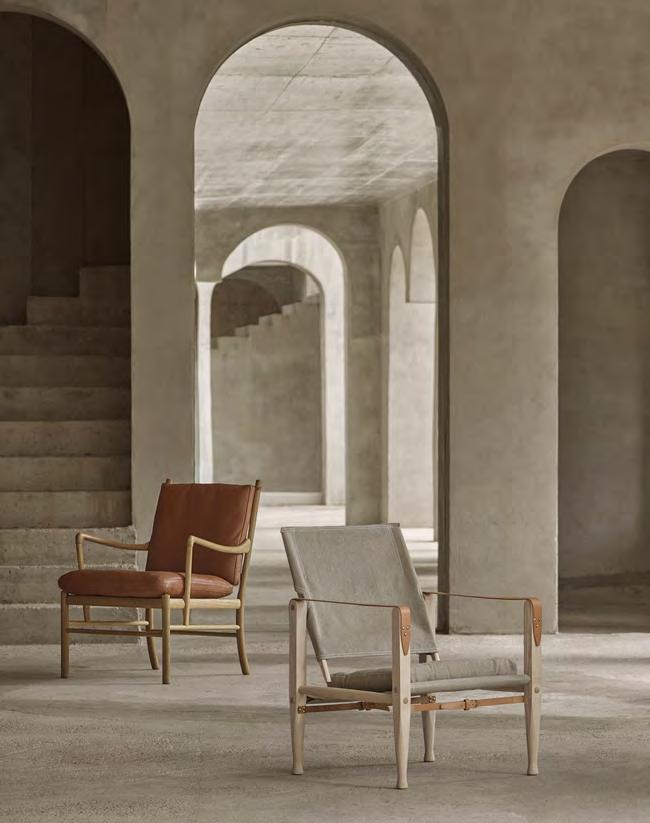

COLLECTION
1
1
“Timeless beauty, comfort, craftsmanship, and sustainability are so deeply ingrained in all our furniture that only sight and touch are required to understand and fall in love with them.”
Knud Erik Hansen, CEO and Third Generation Owner


For more than 100 years, Carl Hansen & Søn has specialized in providing the outstanding furniture craftsmanship that brings visionary design concepts to life

4
A LEGACY OF PASSIONATE
A MORE SUSTAINABLE APPROACH TO DESIGN
OUR EXTENDED FAMILY OF DESIGNERS
5
CRAFTSMANSHIP
CHAIRS LOUNGE CHAIRS & FOOTSTOOLS TABLES SOFAS DAYBEDS, BEDS & BENCHES COFFEE TABLES STORAGE CHILDREN´S FURNITURE LIGHTING OUTDOOR FRAMES ILLUSTRATED GUIDE CARL HANSEN & SØN FLAGSHIP STORES AND SHOWROOMS 7 9 10 13 33 59 73 87 97 107 113 117 123 131 135 172
TABLE OF CONTENTS Carl Hansen & Søn Collection



6
UPPER LEFT: A craftsman in the Carl Hansen & Søn workshop, at work on the CH25 Lounge Chair, which still takes about 10 hours the weave.
UPPER RIGHT: Original sketches of the BM1106 Huntsman Chair designed by Børge Mogensen.
BOTTOM RIGHT: Today Hans J. Wegner’s CH24 is still produced at the Carl Hansen & Søn factory in Gelsted, Denmark
A LEGACY OF PASSIONATE CRAFTSMANSHIP
Our story began in 1908, when Danish cabinetmaker Carl Hansen opened a small furniture workshop on the Danish island of Funen. Over the years, the success of our family business has depended on two core ideas: an uncompromising commitment to the nest craftsmanship, and alliances with exceptional designers who continually reinvent and re ne the concept of modern design.
For over 100 years, we have specialized in providing the outstanding furniture craftsmanship that brings visionary design concepts to life. And, although much has changed at Carl Hansen & Søn over the years, the fundamentals are the same. Our long-standing goal remains to gather the best modern furniture designs under one roof and to share these icons with the world.
Everything we do is driven by our commitment to honest, sustainable practices. These traditional techniques – which have been passed down through multiple generations of the Hansen family – sit alongside our desire to always improve and evolve. Since Knud Erik Hansen took the lead as CEO in 2002, he has expanded and modernized production, established new relationships with the families of designers from the 20th century, incorporated the work of new talent, and, through it all, continually emphasized the importance of balancing classic craftsmanship and modern technology.
Our furniture can now be found all over the world, in a growing number of Carl Hansen & Søn Flagship Stores located in New York, San Francisco, Tokyo, Osaka, and throughout Europe. At Carl Hansen & Søn, we are proud that the things we make have found homes in some of the world’s most beautiful modern spaces. These meticulously designed, carefully-crafted objects – chairs, tables, sofas, and lamps – set the tone in some of the world’s best restaurants. They serve in meeting spaces where world leaders make history. They enhance millions of people’s travel experiences in hotels and airports. They bring a new dimension to healthcare and well-being facilities, elevating the human experience. And, they regularly appear on the pages of top architecture and design publications showcasing the work of the best architects and interior designers working today.
7
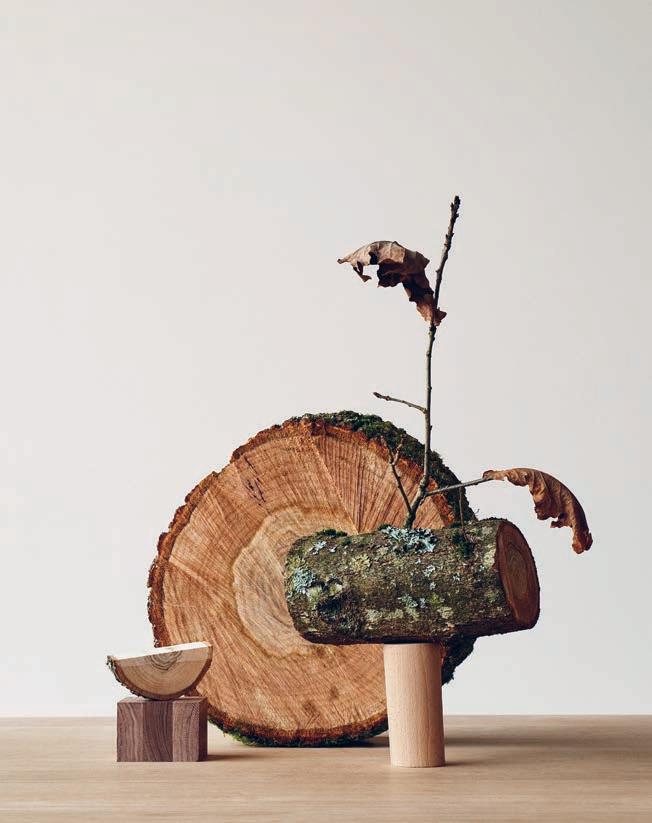
8
A MORE SUSTAINABLE APPROACH TO DESIGN
At Carl Hansen & Søn, we believe that one of the best strategies for sustainable living is to make and buy things that endure. We use our craftsmanship expertise and the nest materials to create pieces that last a lifetime. Our hope is that they will not only be enjoyed by their owner, but they will be passed down and cherished by future generations, too.
The heart and soul of the business is the factory in Gelsted, on the Danish island of Funen. Inside the Carl Hansen & Søn production facility, you can witness craftsmen and women using age-old techniques alongside machines that utilize the most advanced available technology. While our new machines add valuable precision to the process, our production remains heavily centered around traditional methods, with skilled carpenters assembling and polishing each piece by hand. We currently use nearly every bit of wood we source – and the remaining scraps are repurposed as fuel in a district heating plant that provides warmth to more than 400 local homes in Gelsted, Denmark.
Following the UN’s Sustainable Development Goals, we have set a number of ambitious targets to ensure that we care better for our people and for the planet. By 2025, we have vowed to use only environmentally-certi ed wood, which would see the manufacture of 350 of our designs in FSC™-certi ed (FSC C135991) wood. In addition, all of our furniture textiles will be environmentally certi ed, our leather supplied by fully transparent and sustainable tanneries, and our packaging 100% sustainable.
Our commitment extends to education, with an apprenticeship program that trains 15 talented young people on in-house repair and refurbishment services. This ensures that even the most well-loved furniture can be restored and made ready for many more years of enjoyment. We also help to support the lifespan of our pieces with detailed maintenance guides that o er advice on general care and treatment.
Ultimately, we are striving to leave nothing behind. Nothing, that is, but our beautiful furniture and the rich legacy of craftsmanship that created it.
9
OUR EXTENDED FAMILY OF DESIGNERS
For more than a century, we have worked closely with the most in uential gures of Danish Modern Design to translate their exacting visions into beautiful pieces of furniture. All of the designers in our extended family share a set of core values: an appreciation for natural materials, a strong understanding of function, and the ability to create timeless pieces.
Since becoming CEO in 2002, Knud Erik Hansen – like his father and grandfather before him – has continued to expand the company’s portfolio of works by the most in uential and inspiring designers from the Golden Age of Danish Design. Today, our network of visionary designers includes Børge Mogensen, Ole Wanscher, Kaare Klint, Poul Kjærholm, Bodil Kjær, and Arne Jacobsen, among others. We work closely with the families of each of these in uential creators to ensure that their creative vision and their valuable legacies will live on in the products we make.
Our longest-standing partnership has been with Hans J. Wegner, who began collaborating on exclusive designs with Carl Hansen & Søn in 1949. So entwined are our histories that the Carl Hansen & Søn logo was actually designed by Wegner in 1950. To celebrate the 100th anniversary of Wegner’s birth, the logo – which features the company initials in soft, organic shapes – was reinstated by Carl Hansen & Søn in 2014.
In addition, Carl Hansen & Søn partners with many of the best contemporary designers at work today. These innovative men and women from around the world are seeking to preserve Danish Modernism’s fundamental principles of simplicity, functionality, and craftsmanship.
10



11
UPPER LEFT: Hans J. Wegner - Architect and legendary chair designer Hans J. Wegner
UPPER RIGHT: Børge Mogensen - The architect Børge Mogensen at work at his drafting table
BOTTOM LEFT: Kaare Klint - A professor established the Department of Furniture Design at the Royal Danish Academy of Fine Arts, and is recognized as the father of modern Danish design
Every piece of our furniture has a story that begins with the materials it is crafted from. Our paper cord is made from FSCTM-certified* sustainable paper and is as durable and natural as the wood it is woven around.
12
*FSC C135991
COLLECTION 13
CHAIRS
CH20 ELBOW CHAIR
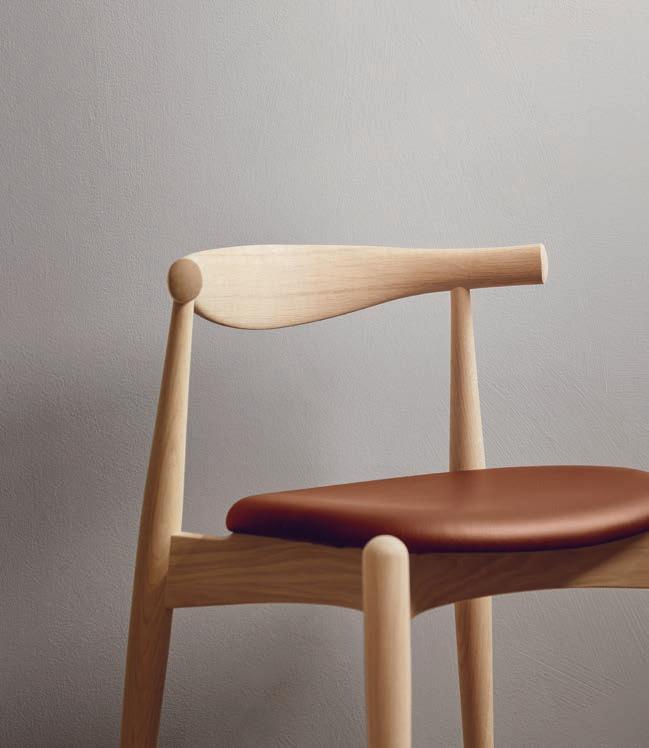
Hans J. Wegner designed the stackable Elbow Chair in 1956. After crafting two prototypes, he set the production-intensive chair design aside in his archives, where it remained for nearly half a century. When Carl Hansen & Søn put the Elbow Chair into production for the rst time in 2005, the design quickly established its position as a modern classic, winning the ICFF Editors’ Award in New York the same year.
The CH20 Chair’s characteristic steam-bent backrest, crafted from a single piece of solid wood, provides arm and lower back support and enables a variety of sitting positions. The chair’s unique rail construction under the seat in form-pressed veneer adds optimal stability in combination with a light and oating expression above the legs.

14 Hans J. Wegner 1956
CH20 ELBOW CHAIR: Frame: Oak, soap. Seat: Thor 307 leather
The CH23 Dining Chair was one of the rst chairs Hans J. Wegner designed exclusively for Carl Hansen & Søn in 1950. The pieces he created at this time were not only unique but also set new standards for modern furniture design with their artistic expression and ergonomic form.

Although the CH23 Dining Chair may appear uncomplicated at rst glance, it incorporates many ne,
sophisticated details, among them the elegant cruciform cover caps in the backrest, a double-woven seat, and arched rear legs that ensure optimal stability.
Carl Hansen & Søn reintroduced the CH23 in 2017, once again making the rst masterpieces part of its collection. As always, the design remains true to Wegner’s original, hand-drawn sketches, with all aesthetic and structural components intact.
15 Hans J. Wegner 1950 CH23
CH23 CHAIR: Frame: Walnut, oil. Seat: Natural paper cord
The very rst model Hans J. Wegner designed exclusively for Carl Hansen & Søn in 1949, the CH24 Wishbone Chair, has been in continuous production since its introduction in 1950. With a form that is uniquely its own, the iconic CH24 Wishbone Chair by Hans J. Wegner holds a special place in the world of modern design.
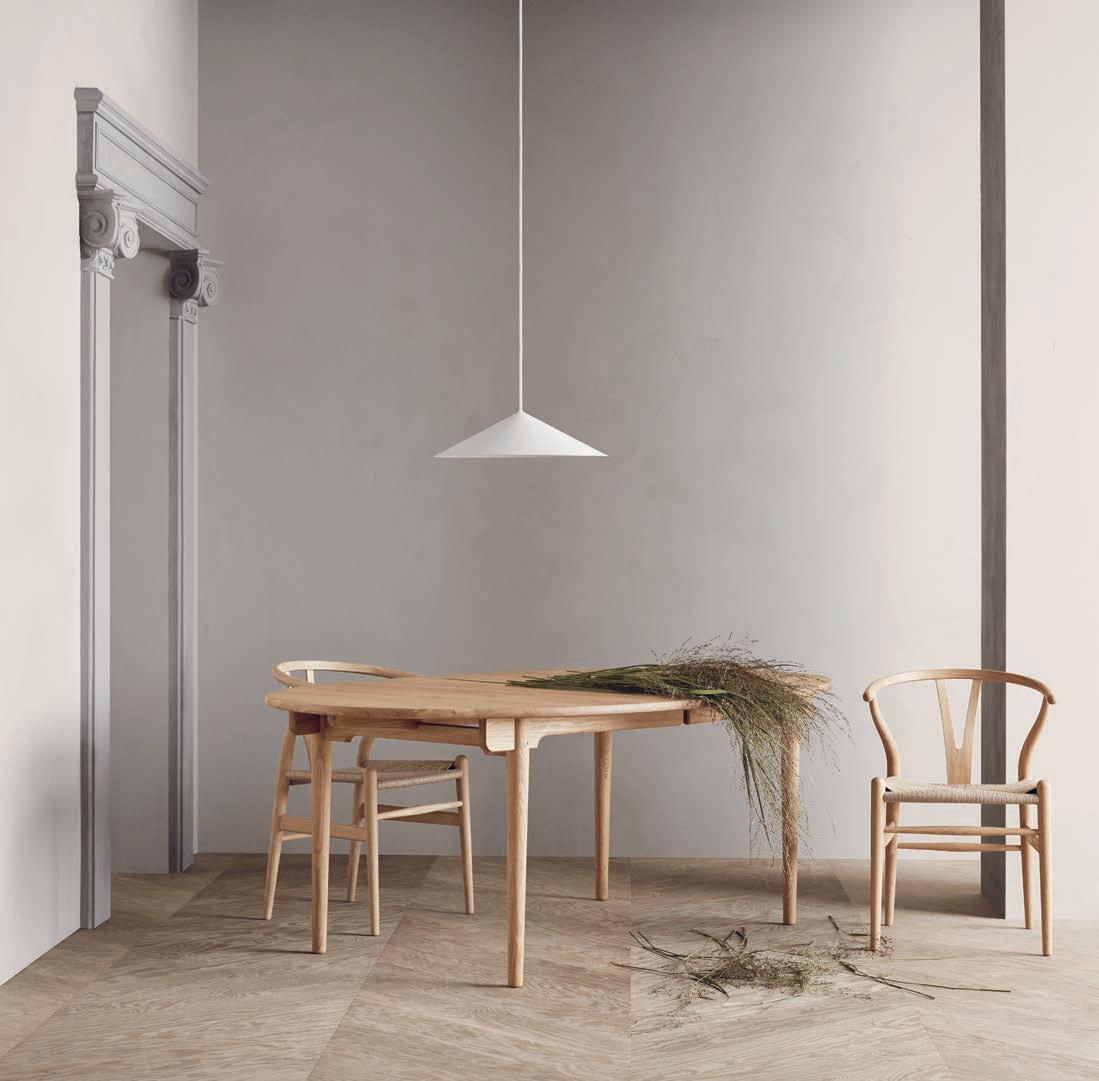
When designing the CH24, Wegner chose to combine the back- and armrest into a single piece. To give stability to the steam-bent top and ensure comfortable support, Wegner developed the characteristic Y-shaped back that the Wishbone Chair is named after.
More than 100 steps are required to manufacture each Wishbone Chair, most of which are carried out by hand. The hand-woven seat alone takes a skilled craftsman about an hour to create, using approximately 120 meters of paper cord, the impressive durability and stability of which makes the chair both strong and long-lasting. The Wishbone Chair o ers comfort and stability as well as satisfying aesthetic desires for distinctive, elegant form.
Over time, the Wishbone Chair has gained recognition as the ideal chair, capturing the essence of modern Danish design.
16 Hans J. Wegner 1950
CH24 WISHBONE CHAIR
CH24 WISHBONE CHAIR: Frame: Oak, white oil. Seat: Natural paper cord. CH338 TABLE: Table top and legs: Oak, oil. BT1001 LAMP PENDANT NO 1: Steel white
The chair is part of a series of iconic chairs Wegner created for Carl Hansen & Søn. Along with the CH22 Lounge Chair, Wegner created a working drawing for translating the lounge chair’s form into a dining chair, the
CH26. Yet he never actually manufactured a mock-up of the armchair and it remained unknown to the public for decades. In 2016 – the same year as the reintroduction of the CH22 – Carl Hansen & Søn brought the CH26 design to life. The CH26 Dining Chair closely resembles the lounge version with its organic shapes, re ned back and hand-woven seat, and features proportions ideal for longer periods of sitting at a dining table or a desk.

17 Hans J. Wegner 1950 CH26
The CH26 Dining Chair by Hans J. Wegner was put into production by Carl Hansen & Søn in close collaboration with the Hans J. Wegner Design Studio and in accordance with Wegner’s original working drawing.
CH26 CHAIR: Frame: Walnut, oil. Seat: Natural paper cord. CH337 TABLE: Table top and legs: Mahogany, oil
Hans J. Wegner designed the CH29P Sawbuck Chair in 1952. His inspiration was drawn from the sawbucks and saw horses used by carpenters and woodcutters – he added upholstered comfort to ensure a unique touch.

The seat is signi cantly wider at the front, and - along with the very curved back – ingeniously enhances comfort in various sitting positions while providing a stylish expression.
This elegant chair was taken out of production in the 1970s and relaunched 20 years later at the suggestion of Wegner’s family, becoming an immediate success thanks to its organic, comfort-driven design and unique aesthetic.
The CH29P Sawbuck Chair is available in di erent colors and wood types with a comfortable seat upholstered in fabric or leather and complements a variety of interiors and style.
18 Hans J. Wegner 1952 CH29P SAWBUCK
CHAIR
CH29P SAWBUCK CHAIR: Frame: Oak, oil. Seat: Sif 90 leather. CH002 TABLE: Table top and legs: Oak, oil
The CH30 Chair by Hans J. Wegner unites a high level of comfort with balanced proportions and exceptional craftsmanship to present a true archetype of Danish Modern.

Hans J. Wegner presented the CH30 Chair in 1954 and the harmonious design embodies his ongoing journey to design the perfect chair. The CH30 Dining Chair showcases Wegner’s signature style: His organic design and exceptional craftsmanship can be seen in sophisticated details such as the cruciform cover caps on the curved, oval backrest that pitches back in line with the rear legs to achieve ultimate comfort. Combined with the wide, form-pressed padded seat it makes for a chair with a high level of comfort and functionality. As the highly comfortable chair can be tucked under a table, it only takes up limited space, making it ideal for any modern context.

19 Hans J. Wegner 1954 CH30P
TOP: CH30P CHAIR: Frame: Oak, oil. Seat: Sif 93 leather
BOTTOM: CH30P CHAIR: Frame: Oak, oil. Seat: Sif 93 leather.
CH327 TABLE: Table top and legs: Oak, oil
Hans J. Wegner designed the CH33 Chair for Carl Hansen & Søn in 1957 which was then produced for the next 10 years. In 2012 Carl Hansen & Søn reintroduced the manufacturing of this characteristic dining chair.
The chair’s mode of expression clearly re ects Wegner’s personal approach to design. It is harmonious and with nely sculptured features. Everything down to the smallest detail is well planned. The CH33 is based on the idea of creating an attractive and sturdy chair with sensible ergonomics while maintaining a ner dimension in the wood where possible.
Therefore, the tapered legs are thickest where they need to support load-bearing joints with the seat’s rails and become slender closest to the oor.
The CH33 appears visually light with a clear division between the bearing – the wooden frame with sloping legs - and the supported elements, in the form of the two plywood shell shapes. In combination with the oval seat, the curved shape of the back makes it possible to turn in the chair and continue to have support in more sloping sitting positions.

20
Hans J. Wegner 1957 CH33
CH33 CHAIR: Frame and seat: Oak/walnut, oil
Hans J. Wegner’s clean and simple CH36 and CH37 Chairs are as comfortable to sit in as they are beautiful to behold. Simple, functional and thoughtfully made, the 1962 CH36 Chair and CH37 Armchair demonstrates the in uence American Shaker furniture principles and craftsmanship had on Wegner’s aesthetic.

The legs of the CH36 and CH37 taper slightly o towards the oor, creating an elegant appearance. The backrest is signi cantly more curved at the top than at the bottom to enhance back support. The overall expression is completed with the frame and hand-woven seat in durable paper cord. The carefully considered design of the CH36 Chair and CH37 Armchair o ers a light expression combined with a sturdy construction to comfortably seat generations. TOP:

21 Hans J. Wegner 1962 CH36 / CH37
CH37 CHAIR: Frame: Oak, oil. Seat: Natural paper cord. CH36 CHAIR: Frame: Oak, oil. Seat: Natural paper cord. CH53 FOOTSTOOL: Frame: Oak, oil. Seat: Natural paper cord. CH337 TABLE: Table top and legs: Mahogany, oil
BOTTOM: CH37 CHAIR: Frame: Oak, oil. Seat: Natural paper cord. CH36 CHAIR: Frame: Oak, oil. Seat: Natural paper cord
Hans J. Wegner´s CH46 Chair is simple and functional, but, at the same time, elegant. One senses that Wegner could be inspired by the simple chairs of the Shaker movement.

Ergonomics was an essential consideration for Wegner in his designs. Careful coordination between slopes and proportions ensured that each chair was optimally suited for the human body. The choice of curved hind legs plays an important role in the construction and balance of the chair. The chair seat is woven from paper cord. At the front, the armrest has the same elegant rounding as the
front leg while curving slightly upwards toward the back where it is rmly fastened between the two backrest bars. The legs and armrests have a slightly arched surface.
The comfortable armrest, the good back support, and the handwoven seat in paper cord, all incorporated in a timeless design, make CH46 comfortable and suitable for the dining room, conference rooms and waiting rooms.
When Carl Hansen & Søn started working on CH46 in 1966, Wegner also gave them the drawing for a chair without armrests, model number CH47.
22 Hans J. Wegner 1966 CH46 / CH47
CH47 CHAIR: Frame: Oak, black. Seat: Natural paper cord. CH46 CHAIR: Frame: Oak, black. Seat: Black paper cord. CH46 CHAIR: Frame: Beech, soap. Seat: Natural paper cord
The CH56 and CH58 Bar Stool creates a welcoming atmosphere in the kitchen, the bar or in a restaurant with its clean look. The stool is robust and sturdy with its 4 slightly angled legs.

The stainless steel ring, holding the legs together, provides stability and a place to rest the occupant’s feet. The stool’s stable construction is well thought
out regarding stability, and typical of Hans J. Wegner, it features legs that are thickest at the joint with the ring narrowing towards the oor and the seat.
The bar stool comes in a lower version, CH58. CH56 is designed to stand next to a bar whereas the lower version, CH58, is more suitable next to a kitchen counter.

23 Hans J. Wegner 1985 CH56 / CH58
CH56/CH58 BAR STOOL: Frame: Oak, oil, stainless steel. Seat: Sif 93 leather
An experimental mix of materials meet in a carefully considered design with a personal expression. An artful fusion of wood and steel, Hans J. Wegner’s versatile CH88 Chair epitomizes his characteristically playful approach to design and materials.
Although known for his work in wood throughout his career, Wegner often explored the limits and potential of other materials. The CH88 is a testament to his skills in this realm. Wegner originally developed the CH88 as a prototype with colored legs for the international
Helsingborg Exhibition of 1955 in Sweden. In 2014, Carl Hansen & Søn brought the chair into production for the rst time in celebration of Wegner’s centennial.
Versatile and elegant, with a simple, stackable design that seamlessly joins wood and industrial steel, the CH88 showcases Wegner’s skill in combining softness and minimalist shapes. The steel frame supports an oval wooden seat and a steam-bent backrest with elegantly upturned ends forming a natural resting place for the arms.

24 Hans J. Wegner 1955 CH88
CH88 CHAIR: Frame: Oak, oil, black stainless steel. Seat: Sif 98 leather. CH338 TABLE: Table top and legs: Oak, oil
BM1106 HUNTSMAN CHAIR
Børge Mogensen’s furniture designs are renowned for their subtlety, with an emphasis on functional exibility and the use of high quality natural materials. The BM1106 Huntsman Chair is no exception to this rule.
Designed for the 1950 Copenhagen Cabinetmakers’ Guild Exhibition, the rugged elegance of the Huntsman Chair helped to de ne Mogensen’s distinctive style. Originally crafted from smoked oak and saddle leather –two of Mogensen’s preferred materials at that point in his career – the robust Huntsman Chair made its mark on the 1950 Guild Exhibition and represents a key moment in the designer’s legendary career.
With the Huntsman Chair, Mogensen created a chair that is at once aesthetically timeless and sublimely comfortable. But, it is in the details of this design that Mogensen’s training as a cabinet maker becomes evident.
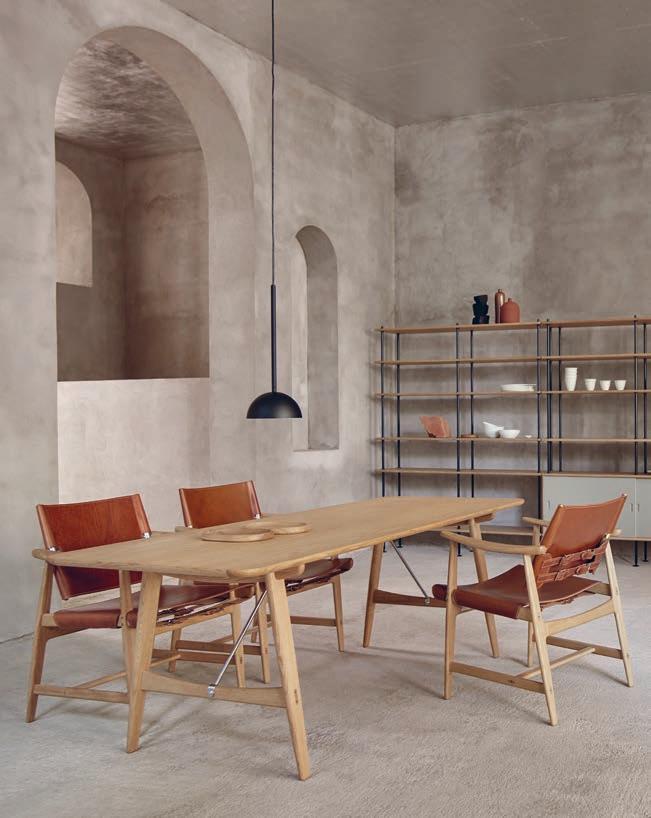
The chair’s elegant wooden frame, rounded armrests, angled legs, and contrasting mortise and tenon joints demonstrate the architect’s passion for craftsmanship. In addition to precision woodwork, the Huntsman Chair also features premium saddle leather, exquisite details, and an adjustable backrest.

Designed alongside the BM1160 Hunting Table, Børge Mogensen’s Huntsman Chair works as both a companion to the Hunting Table or as a stand-alone lounge chair.
SHELVING
BOTTOM:
25 Børge Mogensen 1950
TOP: BM1106 HUNTSMAN CHAIR: Frame: Oak, oil. Seat: Cognac saddle leather. BM1160 HUNTING TABLE: Table top and legs: Oak, oil. Details: Stainless steel. MO300 LAMP: Steel black. BM0253
SYSTEM: Oak, oil, black steel
BM1106 HUNTSMAN CHAIR: Frame: Walnut, oil. Seat: Cognac saddle leather
E004 EMBRACE CHAIR / E005 EMBRACE ARMCHAIR
Enjoy superior comfort with this modern and inviting blend of skilfully sculpted organic and soft materials.
The result of Carl Hansen & Søn’s rst collaboration with EOOS in 2015 was the E005 Dining Chair - so novel and expressive, it easily functions as a stand-alone, sculptural addition to any interior. The Embrace Armchair unites the Austrian design trio’s strong sense of modern aesthetics with Carl Hansen & Søn’s century-old tradition of quality craftsmanship and outstanding comfort.
To achieve a precise yet relaxed expression, EOOS paired soft, modern upholstery with a classic, light, solid wood frame. The wooden structure is continuous, with the legs serving as an essential element of the overall silhouette rather than appendages to the upholstered upper section. The back of the frame, composed of three pieces assembled in classic nger joints, is especially striking. A soft, three-dimensional cushion functions as seat, back and armrests, embracing the wooden structure and appearing to oat within the frame.

26 E00S 2019 / 2015
E005 EMBRACE ARMCHAIR: Frame: Oak, white oil. Seat and back: Sunniva 811 fabric. E020 EMBRACE TABLE: Table top: Laminate, black. Legs: Walnut, oil, stainless steel. E004 EMBRACE CHAIR: Frame: Oak, soap. Seat and back: Remix 173 fabric
A strong sense of modern aesthetics and a tradition for quality craftsmanship.
Optimal seating comfort meets elegant lightness on the Embrace Bar Stool, designed for Carl Hansen & Søn by renowned Austrian design trio EOOS.

Addressing the need to sit on a bar stool for longer periods of time, the exible and dynamic design encourages movement without compromising comfort. Here, soft, relaxed upholstery interacts with the precise,
simple wooden frame, which forms an integral part of the chair’s expression.
Designed to t into the private home, it is especially intended for o ce environments and restaurants that require comfortable, exible seating with a focus on communication. The tall, padded backrest lends support to allow ideal seating comfort and the height ensures that you are at eye level even if one person stands and another sits.
27 E00S 2021 E006 / E007 EMBRACE BAR
STOOL
E006 EMBRACE BAR STOOL: Frame: Oak oil, black powder coated steel.
Seat: Mood 3103 fabric. E007 EMBRACE BAR STOOL: Frame: Oak oil, stainless steel.
Seat: Mood 2103 fabric. MO310 TABLE LAMP: Steel white
KK96620 FAABORG CHAIR
Kaare Klint created his iconic Faaborg Chair in 1914 and rst presented the landmark design to the public at the inauguration of the Danish Faaborg Museum in 1915.

Contemplate a signi cant piece of artwork, in an artwork. This iconic design is one of life’s rare pleasures, designed for everyone who appreciates beauty.
Widely regarded as the rst Danish modern design classic, the chair ushered in a new era for Danish design, creating a foundation for the Danish Modern phenomenon that emerged onto the global stage in the 1950s. The young Klint meticulously considered every aspect of the Faaborg Chair to ensure it ful lled its intended function, arriving at a light and portable solution that allowed museum visitors to position the chair before artworks they wished to study in greater detail.
The Faaborg Chair’s unadorned design and the unity between its structure, materials and function set it apart from its predecessors while showcasing Klint’s traditional design values and modern approach. The elegant form highlights Klint’s outstanding sense of space and proportion and his ability to combine architecture and design into a seamless whole.
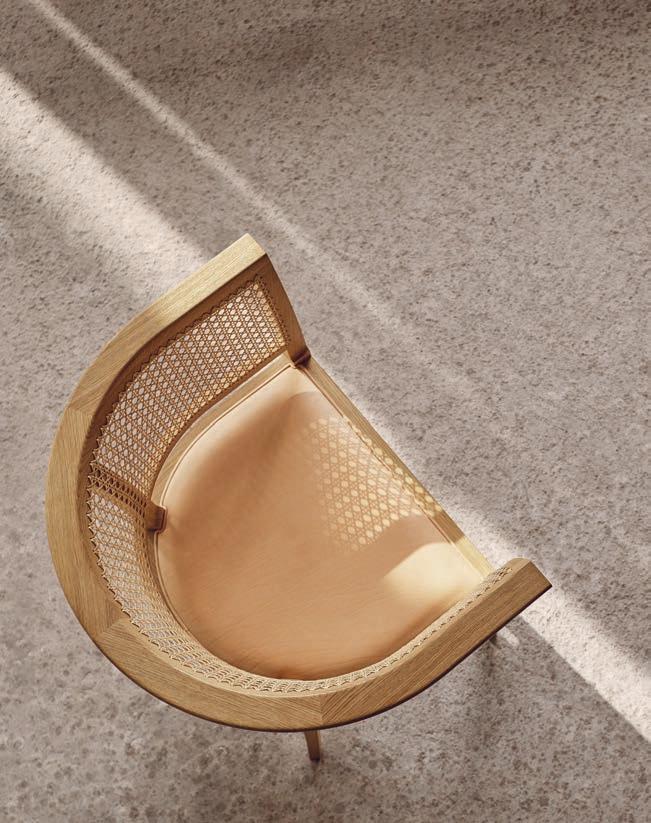
28 Kaare Klint 1914
TOP: KK96620 FAABORG CHAIR: Frame: Oak, oil. Seat: Sif 90 leather
BOTTOM: KK96620 FAABORG CHAIR: Frame: Oak, oil.
Seat: Sif 90 leather. KK96620 FAABORG CHAIR: Frame: Mahogany, oil. Seat: Sif 98 leather
a variety of functions – the Metropolitan Chair can be used as a conference, dining or desk chair.
The LM92P Metropolitan Chair is fully upholstered in luxurious saddle leather in a variety of options – black, cognac or natural, with a trim in red or matching leather. It is also available as a combination with a leatherupholstered seat and an exposed veneer back in oak or walnut as the LM92T Metropolitan Chair.

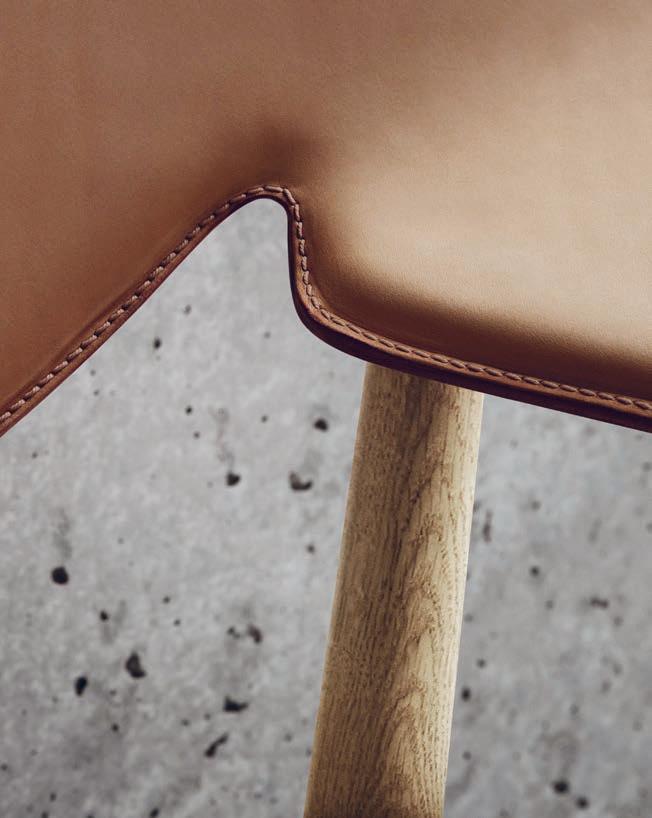
29 Ejner Larsen & Aksel Bender Madsen 1949
METROPOLITAN
LM92T
CHAIR
The LM92P Metropolitan Chair by Ejner Larsen and Aksel Bender Madsen, earned its name at the 1960 exhibition, ‘The Arts of Denmark’ at the New York Metropolitan Museum of Art.
The LM92P Metropolitan Chair by Ejner Larsen and Aksel Bender Madsen combines wood and upholstered leather with great skill and beauty. The Metropolitan Chair is distinguished by a back and armrest crafted from a single piece of veneer, resulting in excellent seating comfort for
LM92 METROPOLITAN CHAIR: Frame: Oak, oil. Seat: Nature saddle leather
Ole Wanscher, inextricably linked to the characteristic, simple aesthetics and functionality of the Danish design movement, sought to nd the ideal furniture constructions which he then gave a more modern expression.

Ole Wanscher’s deep respect for materials, craftsmanship and function come to the fore on the OW58 T-Chair, relaunched in a loyal tribute to his original design — albeit adjusted in height to provide optimum ergonomics for today’s design enthusiasts who have grown taller since 1958.
The chair’s distinctive expression challenges the art of the possible without compromising craftsmanship or comfort. A re ned, sculptural object, the OW58 T-Chair’s characteristic T-shaped backrest and beautiful carpentry embody both classic and modern lines to give the chair a light and elegant appearance.
The result of careful processing and many carpentry hours to achieve smooth transitions in the joints, the chair’s most striking detail is the T-shaped backrest which merges with the tightly placed back legs, giving the chair a three-legged appearance. Despite its light expression, the T-Chair has a wide, upholstered seat that provides excellent comfort, making it ideal for dining use.
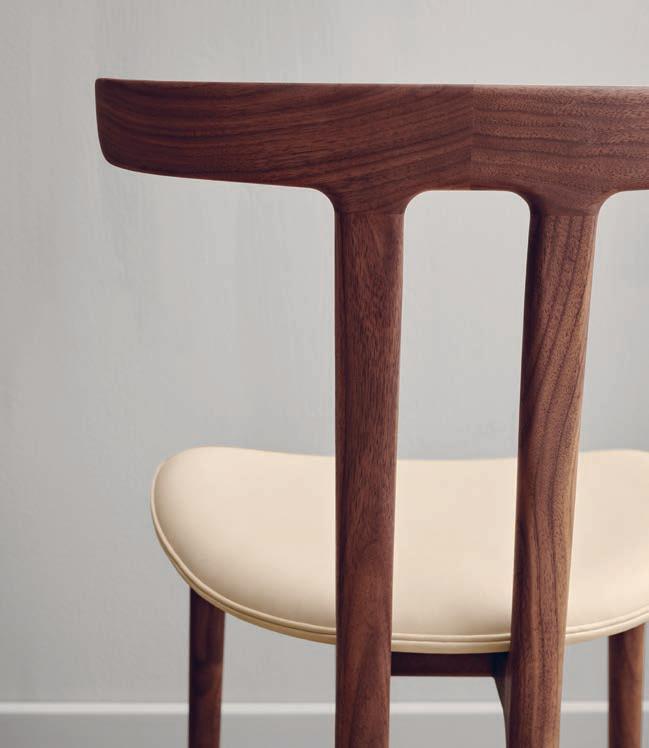
30 Ole Wanscher 1958
OW58 T-CHAIR
TOP: OW58 T-CHAIR Frame: Walnut, oil. Seat: Sif 90 leather.
BM1160 HUNTING TABLE: Table top and legs: Walnut, oil.
Details: Brass. BT1041 CALOT LAMP: Steel white
BOTTOM: OW58 T-CHAIR: Frame: Walnut, oil. Seat: Sif 90 leather
The chairs Kaare Klint designed between 1927 and 1933 won international acclaim for their prominent roles at two key showcases for the nest in Danish design: the Danish Museum of Art and Design and the Danish Pavilion at the Barcelona International Exposition.

A classic series designed for a higher purpose – to withstand the test of time in support of prime ministers and politicians. Klint rmly believed that long-existing archetypes could and should inform contemporary design. In developing his Red Chair Series, he carefully studied several English chair designs, including the
Chippendale, combining elements to create a new construction with a modern expression and excellent support. The Large Red Chair, the rst in the series, was designed for the lecture hall of the new Danish Museum of Art and Design in central Copenhagen, and shown at the Danish Pavilion at the 1929 Barcelona International Exposition. Klint then designed the Large Red Chair with Armrests for Danish Prime Minister Thorvald Stauning’s o ce at the Christiansborg Palace, and developed the Small Red Chair and the Medium Red Chair to t various tables.
31
Klint 1927-1933
Kaare
RED CHAIR SERIES
KK37581 RED ARMCHAIR: Frame: Oak, black. Seat: Sif 98 leather. KK37490 RED CHAIR: Frame: Oak, white oil. Seat: Sif 98 leather. SH900 EXTEND TABLE: Table top and legs: Oak, white oil. Leaves: Black. BT1041 LAMP: Steel black
It takes a skilled craftsman 10 hours and approximately 400 meters of paper cord to complete the CH25 Lounge Chairs seat and backrest by hand, using a particular technique resembling weaving, which is visible on both sides of the backrest.
32
LOUNGE CHAIRS & FOOTSTOOLS
33
COLLECTION
Hans J. Wegner’s architectural expertise and absolute determination creates the ultimate sense of proportion and balance.
When Wegner unveiled the design in 1963, many critics loved the avantgarde look, but the general public was more reluctant to accept its distinctive expression. Mixed reviews in the 1960s resulted in very limited production, but when Carl Hansen & Søn reintroduced the CH07 Shell Chair in 1998, it immediately won broad public admiration.

The design’s oating lightness is achieved through its wing-like seat and three arched legs. The chair’s signature seat and backrest are created from form-pressed veneer and upholstery, cradling the user in generous comfort. The chair’s legs are crafted in formpressed veneer, with the front legs made from a single piece, and all three legs splitting at their highest point, before coming back together and curving sharply downwards. This unique construction adds stability to the light and distinctive form.
The Shell Chair is a clear manifestation of Wegner’s belief that a chair should have no back side and should be beautiful from all sides and angles.

34 Hans J. Wegner 1963
SHELL CHAIR
CH07
CH07 SHELL CHAIR: Frame: Oak, oil. Back and seat: Thor 307 leather
An early design that displays Hans J. Wegner’s natural air for honest craftsmanship and passion for subtle intricacies in materials and techniques.

After several decades, Carl Hansen & Søn brought the intricately detailed CH22 back into production in 2016. The lounge chair features Wegner’s characteristic armrests, an envelope-woven paper cord seat, and a distinctive back shell in form-pressed veneer with striking oblong cover caps. The chair’s re ned joinery is evident in
the nger-jointed corners of the seat frame, with the front legs locking into wooden wedges in a color contrasting that of the frame.
Today, while parts of the production process have been modernized, the CH22 is still manufactured as it was when Wegner oversaw initial production at the Hansen family facilities in 1950, with expert hand craftsmanship employed from assembly through to surface treatment and seat weaving.
35 Hans J. Wegner 1950 CH22
CH22 LOUNGE CHAIR: Frame: Walnut, oil. Seat: Natural paper cord
The CH25 Lounge Chair, like many of Hans J. Wegner’s other iconic designs, is clean and simple in its distinctive shape. But its introduction caused a stir due to Wegner’s choice of materials on the backrest and seat. The woven paper cord, a replacement for seagrass developed during World War II, had not been used in furniture before.

However, Wegner was enthusiastic about the look of the material and its non-stretching and optimal durability, and so were generations after him. The CH25 Lounge
Chair has remained tremendously popular and has been in continuous production since 1950: a testament to Wegner’s visionary approach.
It takes a skilled craftsman 10 hours and approximately 400 meters of paper cord to complete one seat and backrest by hand, using a particular technique resembling weaving, which is visible on both sides of the backrest. The striking result of this exacting process is an exceptional chair that is fascinating from all angles.
36 Hans J. Wegner 1950 CH25
CH25 LOUNGE CHAIR: Frame: Oak, oil. Seat and back: Natural paper cord
Sharp and shapely lines contrast beautifully in this highly appealing chair. Ease back in the comfort of its rounded edges and delicate touches. Hans J. Wegner’s CH28 Lounge Chair designed in 1951 is as functional as it is sculptural. The chair, which was put into production the following year, is a carefully considered design capturing many of the master’s signature elements.
The CH28 Lounge Chair – closely related to Wegner’s famous Sawbuck Chair – is the essence of excellent
craftsmanship and showcases Wegner’s dedication to nding the optimal balance of function and visually attractive form.
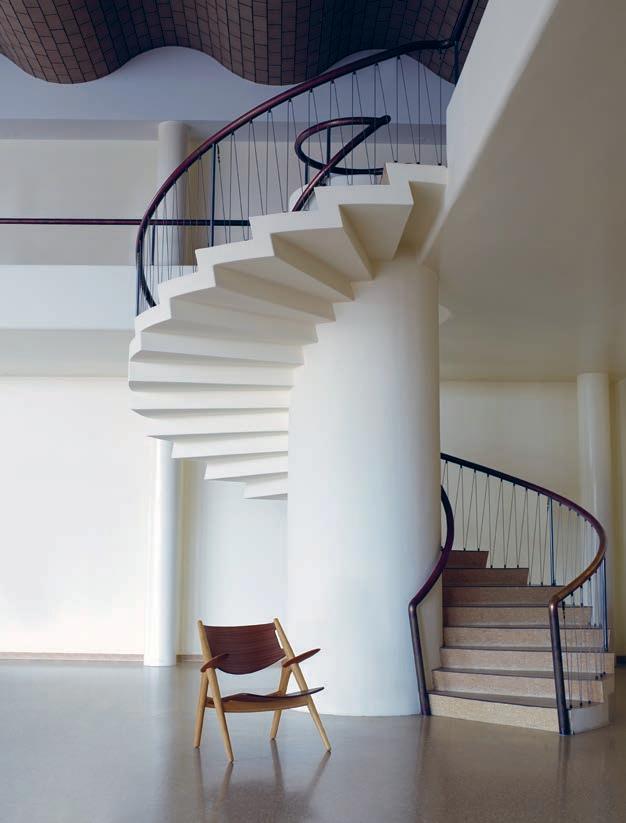
Noteworthy details include elegantly rounded armrests, wooden cover caps that contrast with the grain of the wood, and the intriguing dynamic between the slender, sweeping seat, the curved backrest and the round legs. Rounded edges and delicate details create unparalleled comfort with a relaxed expression.

37 Hans J. Wegner 1952 CH28
LEFT: CH28 LOUNGE CHAIR: Frame: Oak, oil. Seat and back: Oak, oil.
RIGHT: CH28 LOUNGE CHAIR: Frame: Oak, oil. Seat and back: Walnut, oil.
The CH44 Lounge Chair from 1965 by Hans J. Wegner is simplicity perfected. The chair features both Wegner’s characteristic, de ned joints between the front legs and armrests as well as grooves on the top of the rear legs from which to hang a back cushion. The armrests slope upwards towards the rear legs, becoming more slender as they rise, thus elegantly strengthening the vertical joint. The overall e ect appears striking and the result is comfortable.
The simplicity of the lounge chair design was inspired by the principles of American Shaker furniture, which also was Wegner’s inspiration for the closely related CH46 and CH47 chairs.
The CH44 Lounge Chair is crafted from solid wood and features a durable paper cord seat. It is available with optional seat and backrest cushions and the matching low CH53 Footstool for added comfort.

38 Hans J. Wegner 1965 CH44 / CH53
CH44 LOUNGE CHAIR: Frame and back: Oak, black. Seat: Black paper cord. CH53 FOOTSTOOL: Frame: Oak, black. Seat: Black paper cord
This supremely comfortable lounge chair features a streamlined design that is both neat and elegant: an ideal choice for a smaller space. Created in 1952, the masterfully designed CH71 Lounge Chair is a testament to Hans J. Wegner’s unparalleled understanding of woodworking and upholstery.
With its sculptural appeal and slender frame, the CH71 Lounge Chair has all the hallmarks of the ‘Master of the Chair’. As well as being a skilled cabinetmaker, Hans J. Wegner possessed an in-depth knowledge of upholstery techniques, which allowed him to conceive designs that required expert craftsmanship in their creation.

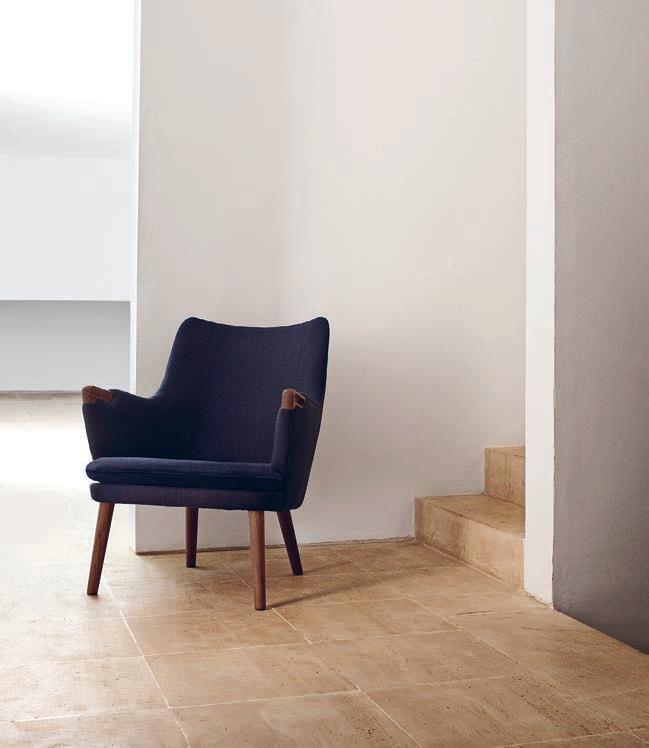
The designer gave much consideration to the CH71 Lounge Chair’s proportions, which is why this streamlined piece is a good t for even the smallest of corners. The cushioned curves wrap snugly around the angular frame, achieving an aesthetic that exudes both lightness and comfort. The upholstered armrests are nished with slim, solid wood handles, that are designed for resilience and make moving the chair easy and convenient.
Wegner had a special ability to create designs that were modern and innovative, and yet had all the qualities of a timeless classic. As relevant today as it was in 1952, the CH71 Lounge Chair has remained e ortlessly contemporary throughout the decades.
39 Hans J. Wegner 1952 CH71
TOP: CH71 LOUNGE CHAIR: Frame: Oak, soap.
Back: Divina Melange 120 fabric. Seat: Canvas 124 fabric
BOTTOM: CH71 LOUNGE CHAIR: Frame: Walnut, oil.
Back and seat: Canvas 749 fabric
With its thickly padded body, tapered legs, sloping armrests, and elegant, double curved backrest, the laid back and highly inviting CH78 Lounge Chair is one of Hans J. Wegner’s most visually instinctive chair designs. A ectionately known as the Mama Bear Chair, the CH78 Lounge Chair was originally introduced in 1954. De ned by a series of inviting curves that o er up a warm embrace, the CH78 Lounge Chair’s special aesthetic character comes from the way it balances soft, rounded curves with dynamic geometries and ne details, such as the signature wooden details on the chair’s armrests.
This lightweight, modern lounge chair is both incredibly soft and highly supportive, o ering ergonomic comfort to the neck, back, and body which encourages rest and relaxation. Like all of Hans J. Wegner’s furniture, the CH78 Lounge Chair contains several re ned design elements, including crescent-shaped stitching in the center of the backrest to ensure both solid padding and resilience in the design, precision upholstery work throughout, and durable legs and armrests expertly handcrafted from either oak or walnut.

The CH78 Lounge Chair is available in a wide selection of custom-crafted fabrics and leathers. An optional, matching pillow is also available.

40 Hans J. Wegner 1954
CH78 MAMA BEAR CHAIR
TOP: CH78 MAMA BEAR CHAIR: Frame: Walnut, oil. Back and seat: Hallingdal 100 fabric. Neckrest: Sif 92 leather
BOTTOM: CH78 MAMA BEAR CHAIR: Frame: Oak, oil. Back and seat: Fiord 271 fabric. CH78 MAMA BEAR CHAIR: Frame: Oak, oil. Back and seat: Fiord 151 fabric. CH008 COFFEE TABLE: Table top and legs: Oak, oil

41 Hans J. Wegner 1954
CH78 MAMA BEAR CHAIR
CH78 MAMA BEAR CHAIR Frame: Walnut, oil. Back and seat: Hallingdal 100 fabric. Neckrest: Sif 92 leather. CH008 COFFEE TABLE: Table top and legs: Walnut, oil
CH445 WING CHAIR / CH446 FOOTSTOOL
Hans J. Wegner’s CH445 Chair, also known as the Wing Chair, is a fully upholstered easy chair that rests on a stainless steel frame. The armchair, with its distinctive lines and pleasant seating comfort, is a ne example of how a high-backed armchair should be according to Wegner.
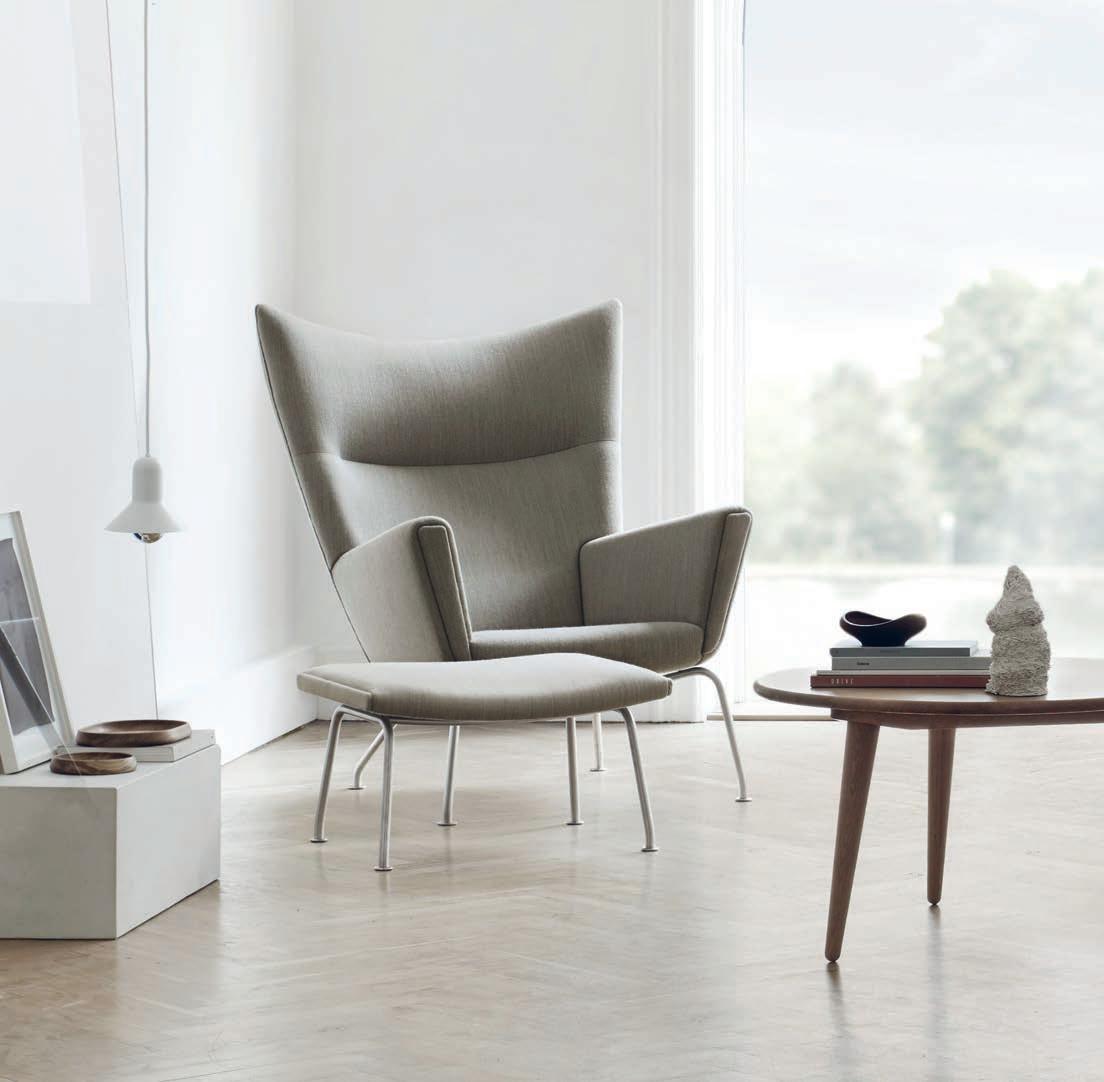
Under the upholstery there is a solid beech frame which gives the chair strength and durability. The seat and backrest are constructed to provide comfortable support for the back, shoulders, neck, and head in di erent sitting
positions. The slender, round stainless steel of the frame has front legs that tilt slightly forward while the rear legs protrude far backwards so that the chair, despite its reclining position, will not tip over. Four small steel cone shaped elements link the upper part of the chair with the frame. Each leg has a steel shoe attached to prevent the chair from sliding.
The CH445 Wing Chair is available with the matching CH446 Footstool, for added comfort.
42 Hans J. Wegner 1960
CH445 WING CHAIR: Back and seat: Mood 3103 fabric. Frame: Stainless steel. CH446 FOOTSTOOL Seat: Mood 3103 fabric. Frame: Stainless steel. CH008 COFFEE TABLE: Table top & legs: Oak, oil
The production history of Hans J. Wegner’s CH468 Oculus Chair is a little out of the ordinary. While visiting Wegner’s design studio, Carl Hansen & Søn became very interested in some photos and a small clay model of a 1960’s easy chair. When Wegner’s technical drawings of the chair were retrieved, and Carl Hansen & Søn was given the opportunity to study a full-size prototype of the chair manufactured in 1960, it became possible to start production of the Oculus Chair in 2010.

Oculus is the Latin word for eye and refers to the eye shaped stitching in the chair’s back upholstery. The
CH468 OCULUS CHAIR
design works to ensure that the shoulder blades can fall back comfortably into the chair creating rest for both the neck and back. The impressive upholstered upper chair shape is emphasized by the sleek looking stainless steel frame with slopping legs. With its sculptured silhouette and ne seating characteristics, the Oculus Chair will be the natural focal point in any room, both standing individually or in a group.
The CH468 Oculus Chair is available with the matching CH446 Footstool, for added comfort.

43 Hans J. Wegner 1960
CH468 OCULUS CHAIR: Seat and back: Mood 4104 fabric. CH53 FOOTSTOOL: Frame: Oak, black. Seat: Natural paper cord. CH008 COFFEE TABLE: Table top & legs: Oak, oil
The result of Carl Hansen & Søn’s collaboration with the designer Anker Bak, the Rocking Nest Chair fully reimagines an age-old concept for modern living and unwinding. Meditative movement, considered design and practical construction make the Rocking Nest Chair a sanctuary of peace and harmony. Like his other imaginative, innovative work, Bak’s Rocking Nest Chair was borne out of a real human need.






























Bak conceived the design when his sister needed a comfortable place to relax with her newborn baby,















creating a one-of-a-kind form with unprecedented functionality. Dynamic in its expression and clear in its construction, the seemingly oating Rocking Nest Chair unites a light steel and wood frame, a seat with a canvas back and a canvas or leather front, and a soft leather cushion into a welcoming, organic silhouette. For Bak, who is fond of nomadic living and fascinated by society’s ever-changing needs, the chair also needed to be exible and meet the constraints of urban spaces. To this end, the Rocking Nest Chair incorporates a mechanism that makes it easy to fold the chair at with just a few steps.

44 Anker Bak 2017
ROCKING NEST CHAIR
AB001
ABOO1 ROCKING NEST CHAIR: Frame: Oak, oil. Seat: Sif 95 leather, nature canvas fabric. Details: Stainless steel
E015 EMBRACE LOUNGE CHAIR / E016 EMBRACE FOOTSTOOL
EOOS designed the E015 Embrace Lounge Chair to provide superior comfort. The chair consists of a continuously visible wooden structure with a three-piece, rounded back and characteristic legs adding to the overall frame.
The seating is created with a three-dimensional cushion embracing the wooden frame, as well as the person sitting in it, with soft and elegant upholstery. The Embrace

Lounge Chair has enhanced comfort due to increased padding in the cushions and a lowered seat that creates the ultimate relaxation experience. This modern blend of organic and soft materials is skillfully sculpted to surround with supreme comfort.
The E015 Embrace Lounge Chair is also available with the matching E016 Footstool for added comfort.
45 E00S 2016
EO15 LOUNGE CHAIR: Frame: Oak, oil. Seat and back: Sif 98 leather. EO16 FOOTSTOOL: Frame: Oak, oil. Seat and back: Sif 98 leather
FH419 HERITAGE CHAIR / FH420 HERITAGE FOOTSTOOL
Drawing from global inspiration, this early design with its matching footstool embodies relaxed sophistication.
The mounting interest in Frits Henningsen’s work in recent years points to the timelessness of his aesthetic values and design approach.
Characterized by soft, elegant lines and high quality down to the smallest detail, the Heritage Chair bears testimony to Henningsen’s constant pursuit of perfection. With this

1930 design, Henningsen drew on inspiration from earlier style epochs, particularly French imperial and 17thcentury British styles, to create a classic so comfortable and inviting that it easily becomes the favorite chair in any space. The fully upholstered easy chair is built upon a meticulously crafted, solid beech frame.
It is available with the matching FH420 Heritage Footstool for added comfort.
46 Frits Henningsen 1930
FH419 HERITAGE CHAIR: Frame: Walnut, oil. Back and seat: Basel 121 fabric. FH420 HERITAGE FOOTSTOOL: Legs: Walnut, oil. Seat: Remix2 612 fabric
FH429 SIGNATURE CHAIR / FH430 SIGNATURE FOOTSTOOL
Capturing a lifetime of work, this completely unique, exceptionally pure and superbly crafted lounge chair is as easy on the eye as it is to relax in.

As the last piece of furniture Frits Henningsen designed and produced, the Signature Chair crowned his life’s work and consummated his legacy as one of Denmark’s greatest furniture designers.
A cabinetmaker who held his profession to very high standards, Henningsen always manufactured his own designs. He often began the process by creating a small model – in this case, using modeling clay and toothpicks. The frame was then manufactured in his Copenhagen workshop, undergoing months of testing and adjustments before Henningsen was content with the result. After the chair was completed in 1954, fewer than 20 pieces were produced. Carl Hansen & Søn reintroduced the design in 2015.
Over the course of his career, Henningsen’s work evolved towards increasing simplicity, with the Signature Chair becoming his purest, most pared-down design. His interest in achieving comfort and elegance through the use of graceful, curved lines is apparent in this nal project. Its soft, inviting shapes and oating armrests create a simple, organic form that calls for quiet contemplation.
The Signature Chair is available with the matching FH430 Signature Footstool for added comfort.

47 Frits Henningsen 1954
TOP: FH429 SIGNATURE CHAIR: Frame: Oak, oil. Seat and back: Sif 98 leather. FH430 SIGNATURE FOOTSTOOL: Frame: Oak, oil. Seat: Sif 98 leather BOTTOM: FH429 SIGNATURE CHAIR: Frame: Oak, oil Seat and back: Sif 98 leather.
Despite its light exterior, the Plico Chair o ers supreme comfort by virtue of its soft upholstery.
A turning point in the work of Preben Fabricius and Jørgen Kastholm and a precursor to an international career in furniture design, the award-winning, foldable Plico Chair is a unique example of a simple and honest design that neither compromises on comfort nor aesthetics. Plico means ‘to fold’ in Latin and the adjustable backrest can be completely folded, creating a chair that takes up as little space as possible when not in use.

With visible joints, beautiful brass ttings and accomplished craftsmanship, the Plico Chair beautifully highlights what other designers often seek to hide. At rst glance, it appears deceptively simple, but closer examination reveals an extremely detailed design.
The solid oak frame and the rear legs are gently curved, giving the chair a soft rounding at the back. The armrests are made from saddle leather attached on the rear legs, the back and seat are in canvas, and the cushions are upholstered in stitched linen canvas to provide an elegant expression. The high back version of the chair also has a neck cushion for an extra degree of comfort.
TOP: FK10/FK11 PLICO CHAIRS Frame: Oak, oil and nature saddle leather. Seat and back: Canvas fabric. Neckrest: Canvas fabric and nature saddle leather. Details: Brass. MO320 FLOOR LAMP: Steel white. FK63 BOOKCASE SYSTEM Frame and fronts: Oak, oil. Handles: Brass
BOTTOM: FK10/FK11 PLICO CHAIRS: Frame: Oak, oil and nature saddle leather. Seat and back: Canvas. Neckrest: Canvas and nature saddle leather. Details: Brass

48 Fabricius & Kastholm 1963 FK10 / FK11 PLICO CHAIRS
Kaare Klint’s KK43960 Mix Chair has earned iconic status among collectors since its unveiling in 1930. This easy chair is admired as much for its elegant, owing form as for its intricate construction concept. The design of the KK43960 Mix Chair is a culmination of a sophisticated geometric exercise. The easy chair features a series of convex and concave curves that repeat and mirror one another to form the main frame and armrests.
By contrast, the solid wood legs are kept square, with just the back legs gently sloping back to support the chair’s slightly reclined pro le. The Mix Chair embodies Klint’s signature systematic design approach, using geometry and mathematics to achieve ideal shapes, proportions, and overall balance. The loose, rm cushions o er exceptional comfort while re ecting the design’s gentle curves and helping to maintain the intended form.
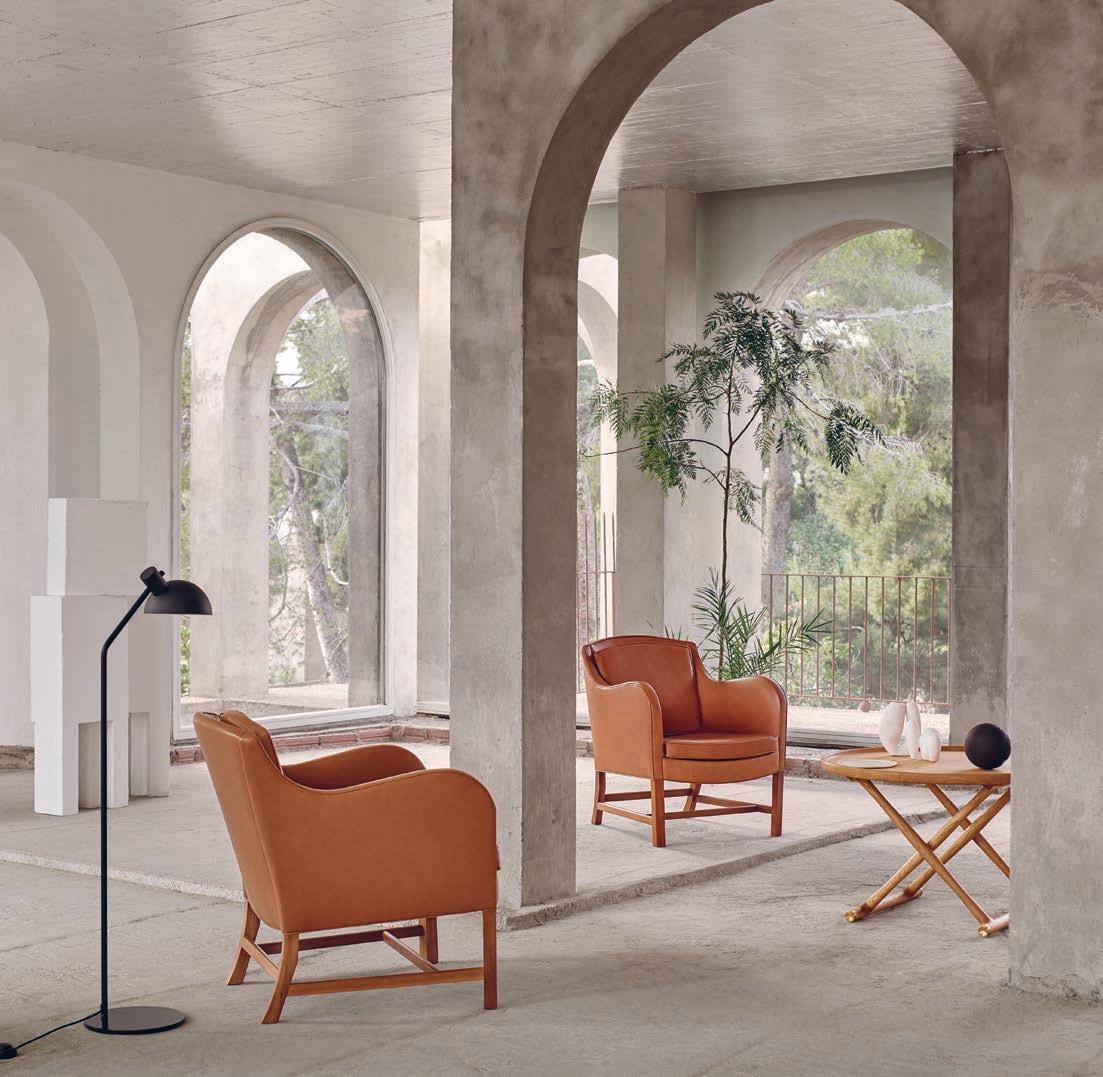
49 Kaare Klint 1931 KK43960 MIX CHAIR
KK43960 MIX CHAIR: Frame: Walnut, lacquer. Seat and back: Sif 91 leather. ML10097 EGYPTIAN TABLE: Table top and legs: Oak, oil. Details: Brass. MO320 FLOOR LAMP: Steel black
KK47000 SAFARI CHAIR / KK97170 SAFARI FOOTSTOOL
From the wild plains of Africa to living rooms and hotels, this iconic design has come a long way. Imagine great adventures in its simple yet sturdy construction.
The Safari Chairs in the couple’s photos were likely based on Indian Roorkhee Chairs used by the British military –possibly the rst examples of self-assembled furniture.
The archetype featured glueless joints, tool-free assembly, and an intelligent construction that caused the









joints to tighten when the chair was occupied, enhancing strength and stability. Kaare Klint delved into simplifying, clarifying and re ning the chair’s composition, exhibiting his nal Safari Chair design in 1933 at the Copenhagen Cabinetmakers’ Guild Exhibition.
While inspired by its British predecessor, Klint’s sophisticated, lightweight chair is de ned by his signature systematic approach, ne craftsmanship, well-conceived proportions, and remarkable material e ects.
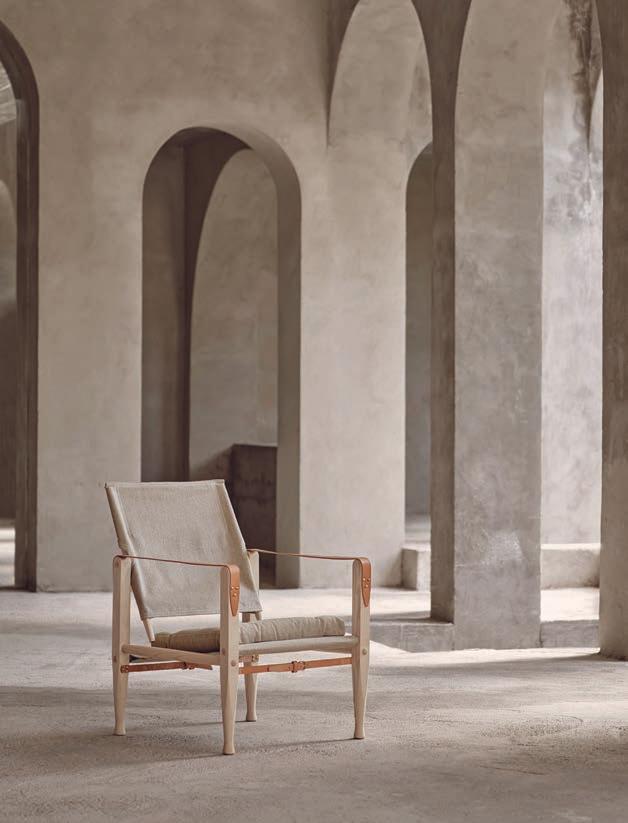
50 Kaare Klint / Esben Klint 1933 / 1966
LEFT: KK47000 SAFARI CHAIR Frame: Ash, white oil. Seat and back: Canvas. Details: Nature saddle leather
RIGHT: KK97170 SAFARI FOOTSTOOL: Frame: Ash, white oil. Seat: Thor 307 leather
The Copenhagen Saddlemakers’ and Upholsterers’ Guild’s 475th anniversary in 1935 o ered Kaare Klint an opportunity to showcase his excellent upholstery skills. Soft to the touch and pleasing to the eye, this Klint chair with its perfect construction and balanced proportions is easy to fall in love with.

Klint submitted four distinct designs to the Guild’s celebratory competition under the title “Christmas 1934”:
KK53130 EASY CHAIR
the Red Chair with armrests; a sofa bed upholstered with Greek fabric; a sectional sofa; and the elegant, upholstered Easy Chair featuring a loose, down- lled seat cushion. Lauded as a very modern contribution due to its precise, tight lines and composition, the Easy Chair was produced for the 1937 Copenhagen Cabinetmakers’ Guild Exhibition.
51
Kaare Klint 1937
KK53130 EASY CHAIR Frame: Oak, oil. Seat and back: Sif 98 leather. KK87830 PROPELLER STOOL: Frame: Ash, stained. Seat: Sif 98 leather
An exercise in mathematical construction, the Propeller Stool expressed Kaare Klint’s vision of the ideal fold, with the two intersecting, propeller-shaped legs forming a perfectly round rod when folded at.
An impressive design made with ingenious multifunctionality and a highly appealing and compact form. Although initially too complex to put into production, the 1930 design quickly attracted attention and was featured as a concept in several design books. A prototype was created in 1956 for the major memorial exhibition for
Klint at the Danish Museum of Art and Design, and the design went into production in 1962, eight years after Klint’s death. In 1964, the Propeller Stool was presented at the Copenhagen Cabinetmakers’ Guild Exhibition, organized by Klint’s son, Naur Klint. The idea of a folding stool was certainly not new; the concept existed as early as the Bronze Age. Klint, however, re ned and optimized it, adding the innovative propeller element. The stool is manufactured using wood with long, strong bers that help support the slim, sophisticated construction. An optional tray transforms the stool into a low table.

52 Kaare Klint 1930 KK87830
PROPELLER STOOL
KK87830 PROPELLER STOOL: Frame: Ash, soap. Seat: Canvas
This stylish lounge chair displays exquisite textures and natural materials. Expert functionalism also make folding it away an absolute pleasure.
Taking extra seating to a new level, the Cuba Chair features a solid oak frame, with the cotton girths around the frame forming a comfortable seat and back and providing excellent support as they gently follow the body’s contours. Ideal as an extra or a permanent xture, the light and exible folding lounge chair can easily be hung on a wall for convenient storage.
Designed in 1997, Morten Gøttler’s ingenious Cuba Chair is an excellent example of the designer’s focused approach to furniture design. With its low, open construction, the Cuba Chair encourages an informal sitting position and clearly re ects the democratic ideals of modernist design. In just a few decades, the deceptively simple Cuba Chair has become a new classic of Danish furniture design.

The chair, which after just a couple of decades has become a true classic, is now being introduced in a new variant with the seat and back in paper cord, giving the Cuba Chair an even lighter and more re ned expression.

53 Morten Gøttler 1997
CUBA
MG501
CHAIR
TOP: MG501 CUBA CHAIR: Frame: Oak, oil. Seat and back: Natural paper cord
BOTTOM: MG501 CUBA CHAIR: Frame: Oak, soap. Seat and back: Webbing, black
Classic methods, Mother Nature and an adventurous mind inspired this elegant chair. Decades later, it is still eye-catching and inviting.
Ole Wanscher possessed a unique ability to add sculptural dimension to his furniture, and his Beak Chair is no exception.


An elegant example of Wanscher’s re ned design and bold pushing of boundaries, the chair was also a testament to his masterful grasp of furniture-making.

The Beak Chair’s distinctive appearance is thanks in part to the beak-like armrests that inspired its name. This unique design feature demands carefully selected materials and exemplary craftsmanship, as do the upholstered seat and back.

Re ecting Wanscher’s predilection for slender dimensions and resilient shapes, the design features slim, gently undulating elements that seamlessly unite in an organic ow. Only the armrest cover caps remain visible: a functional and decorative detail reminiscent of a bird’s eye.

























54 Ole Wanscher 1951
BEAK CHAIR
OW124
LEFT: OW124 BEAK CHAIR: Frame: Oak, oil.
Seat and back: Sif 95 leather
RIGHT: OW124 BEAK CHAIR: Frame: Oak, soap.
Seat and back: Thor 301 leather
OW149 COLONIAL CHAIR / OW149F COLONIAL FOOTSTOOL


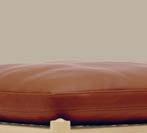
Re ned and luxurious all at once with contrasting forms and materials. This stylish chair is a true pleasure to experience.
Known as a minimalist and functionalist, Ole Wanscher also had a predilection for the slim and re ned. Yet despite its slender dimensions, the Colonial Chair is very stable, its strength lying in the carefully designed bracing.


The design’s sophisticated, slightly curved armrests rise to a point before taking a turn downward – a trademark Wanscher feature. The front and back legs are made of roundwood timber, with the back legs curving gently outward for added stability and a more re ned silhouette.


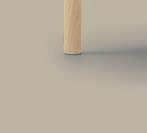



Wanscher later designed the matching Colonial Sofa and Colonial Co ee Table, creating the Colonial Series. The Colonial Chair is available with the matching OW149F Footstool for added comfort.
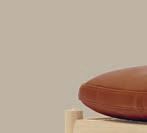
55 Ole Wanscher 1959
TOP: OW149 COLONIAL CHAIR: Frame: Oak, oil. Seat and back: Loke 7050 leather
BOTTOM: OW149F COLONIAL FOOTSTOOL
Frame: Oak, soap. Seat: Loke 7050 leather
OW2000 EGYPTIAN FOOTSTOOL
The OW2000 Egyptian Stool by Ole Wanscher exempli es his creative vision and masterful touch. The stool is crafted from quality, natural materials that express his passion for exploration and original thought.
The OW2000 Egyptian Stool was designed by Ole Wanscher in 1957. The in uence of his travel outside of Denmark is clear to see in this intriguing design. While in Egypt, Wanscher became fascinated with old seats of power, leading to the design of the elegant, lightweight
Egyptian Stool with Temple of Thebes furniture in mind. The design of the stool nods gracefully to his source of inspiration, yet is distinctly modern in its expression and construction. The seat, crafted from saddle leather, easily collapses into the chair when folded.
Many of Wanscher’s designs have become collectors pieces due to their timeless simplicity and beautiful nish. The OW2000 Egyptian Stool is no exception.
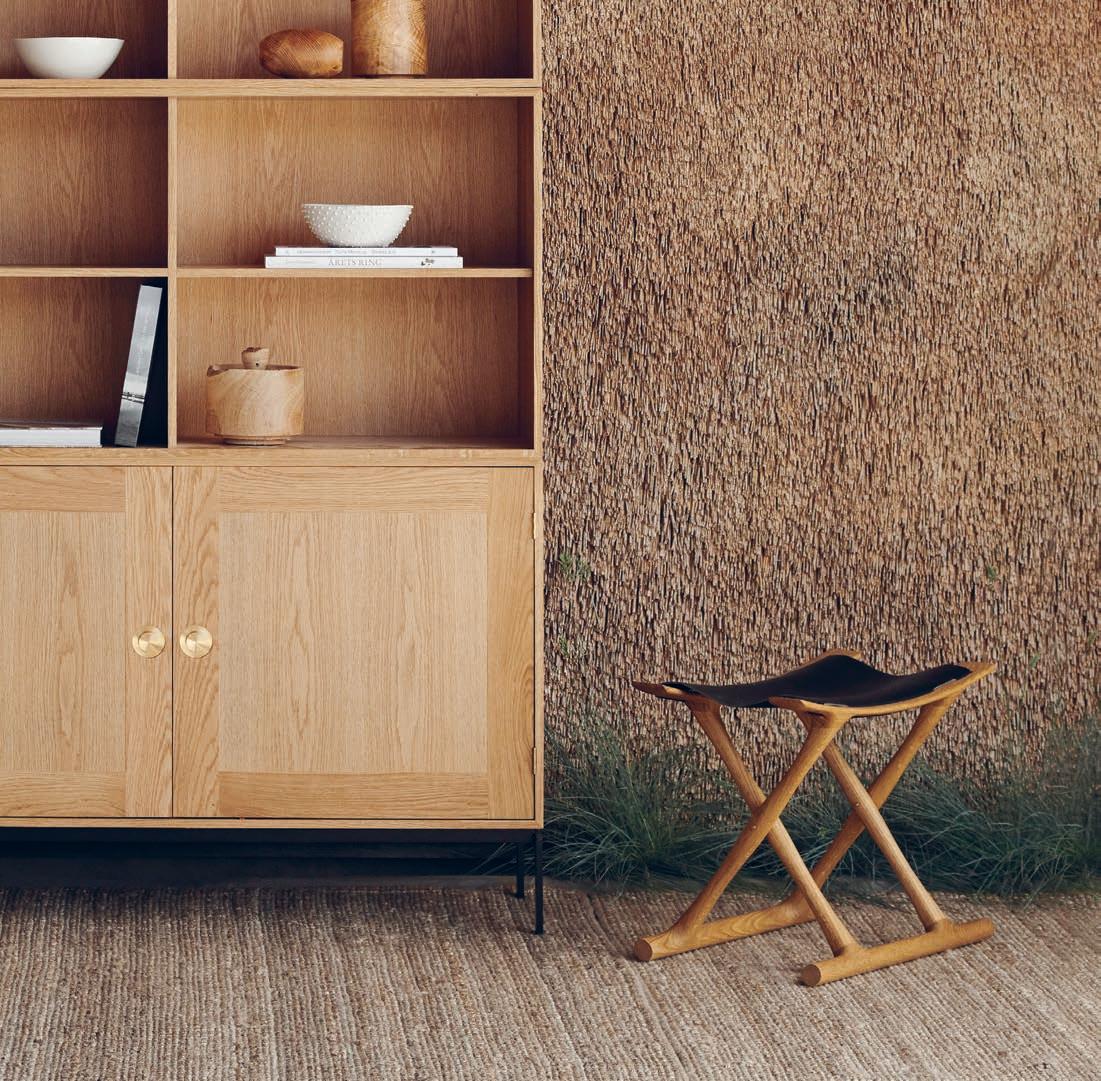
56 Ole Wanscher 1957
OW2000 EGYPTIAN FOOTSTOOL: Frame: Oak, oil. Seat: Black saddle leather. FK63 BOOKCASE SYSTEM: Frame and fronts: Oak, oil. Handles: Brass
In 2013, the acclaimed Japanese architect Tadao Ando designed the Dream Chair for Carl Hansen & Søn as a tribute to Hans J. Wegner, seeking to capture the sculptural minimalism that de ned Wegner’s work.
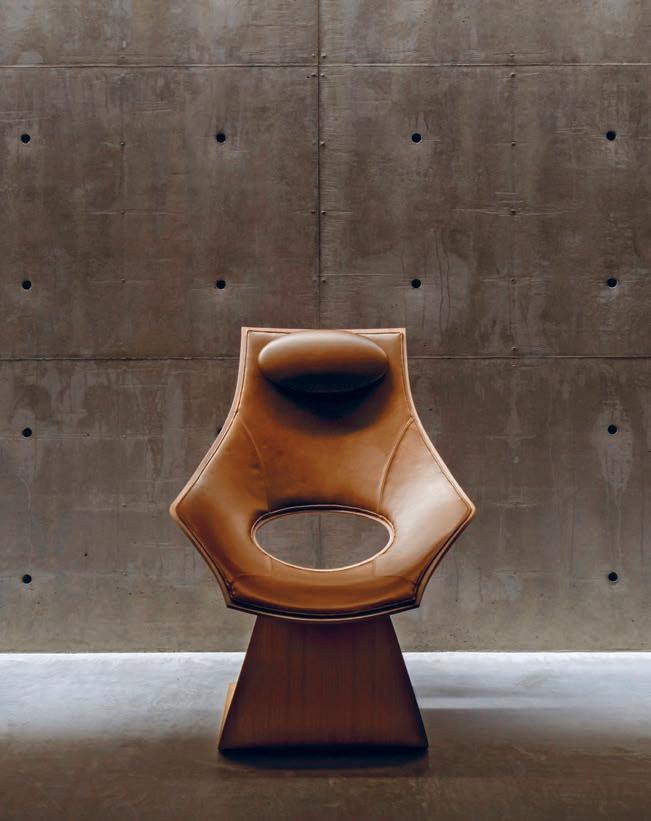
This chair’s sculptural appeal is captivating and comforting all at once – the perfect place to dream away the hours. Residing at the intersection of art and design, the Dream Chair merges beauty and comfort as it invites relaxed re ection. True to Wegner’s mantra, the
chair is designed to be enjoyed from all angles, its form as captivating when viewed from the front as from the sides and back. To create the necessary characteristics of a chair from the fewest possible parts, Ando and the cabinetmakers at Carl Hansen & Søn used threedimensional veneer that can be curved along two axles during the molding process. Pushing the size and curvature of the veneer sheet beyond what was thought possible, Ando succeeded in creating a form that is dreamlike both in its construction and its soothing e ect.
57 Tadao Ando 2013 TA001P DREAM CHAIR
TA001P DREAM CHAIR: Frame: Oak oil. Seat and back: Loke 7050 leather
Today up to 90% of the wood we use in our products is FSCTM-certified, and the remainder derives from non-certified sustainable forestry. We are committed to using only environmentally certified wood by 2025, thereby ensuring that the wood we source comes from responsibly managed forests and sawmills.
58
COLLECTION 59
TABLES
A table series that adapts e ortlessly to any environment with grace and ease. The perfect balance of form and function.
Designed in 1982, this series of minimalist, versatile dining tables captures Hans J. Wegner’s visionary design approach, excelling in contemporary spaces that require exible solutions.
Highlighting Wegner’s attention to detail and focus on function, the clean, intelligent design o ers numerous
options for creating the optimal size and look for any interior. The two tables – the CH002 for smaller environments such as kitchens and the CH006 for more spacious settings – come equipped with generous hinged leaves at both ends that easily lift up to accommodate guests.
The solid wood design pairs elegantly with Wegner’s dining chairs, taking on a di erent and individual expression depending on the chair, wood type, and nish chosen.

60 Hans J. Wegner 1982 CH002 / CH006
CH002 TABLE: Table top and legs: Oak, oil. CH29P CHAIR: Frame: Oak, oil. Seat: Sif 90 leather
Hans J. Wegner’s CH110 Desk was in many ways a departure from his usual style of wooden furniture. Created in 1970, it was part of an exclusive o ce concept. The series shows some of Wegner’s most distinctive steel-framed furniture.
The CH110 Desk by Wegner introduced a di erent balance to his collection of designs with slender industrial legs combined with a large wooden table top resting lightly upon them. Merging function and form with his


trademark detail-oriented approach, Wegner equipped the desk with long, sleek drawers nished with dovetail joints and small yet distinctive stainless steel handles. The drawers were thoughtfully designed with exible interior compartments.


The desk was created in 1970 as a part of Wegners CH100 Series, which was relaunched in 2008 in celebration of Carl Hansen & Søn’s 100th anniversary.

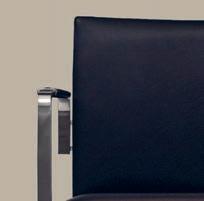
61 Hans J. Wegner 1970 CH110 / CH111
LEFT: CH111 CHAIR Frame: Stainless steel. Seat and back: Thor 301 leather
RIGHT: CH110 DESK: Desktop: Walnut, oil. Legs: Stainless steel
Hans J. Wegner’s CH322 Dining Table has a rectangular solid wood table top with a vertical edge and a stainless steel frame with removable legs. The dining table consists of two parts which can be pulled apart. The joint between the two halves of the top is almost invisible as it follows the natural wood grains.
The frame has rounded legs with oor protectors on the bottom of the legs, and the legs fasten directly to the table plate at the top. Stabilizing the table construction
are two at steel rails. These are shaped, bent and assembled with each pair of legs in a trestle at each table end using distinct screws. The versatile CH322 Dining Table, with seating for six people, can be extended with up to four insert leaves, allowing for a total of 14 seats. The exible design makes the table suitable for large gatherings, meetings, and conferences.
CH322 Dining Table is, design wise, in the same family as the small round CH388 Dining Table.
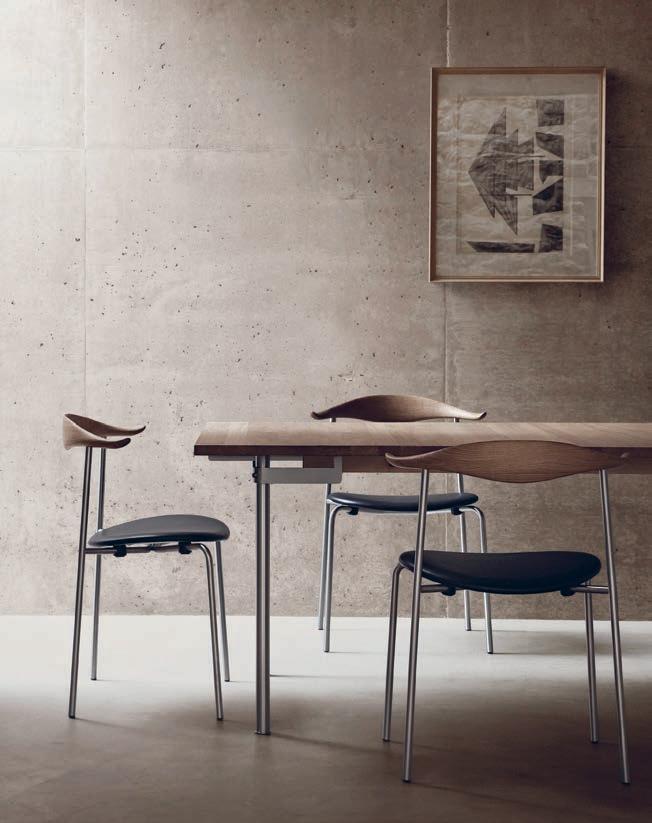
62 Hans J. Wegner 1960 CH322
CH88 CHAIR: Frame: Stainless steel. Seat: Thor 301 leather. Back: Oak, oil. CH322 TABLE: Table top: Oak, oil. Legs: Stainless steel
Hans J. Wegner’s CH327 Dining Table from 1962 is a good example of how creativity combined with excellent craftsmanship can result in a di erent and exciting design. CH327 is a solid wood dining table with softened edges and rounded legs that become narrower towards the oor.

The wood’s grains follow the length of the table top which itself is supported by 3 distinct rails. Underneath each of these, on each side, is a side rail that continues along the length of the table. Between the side rail and the table top there is a space, thus giving the impression that the table top is oating.
For support, there is two detachable legs at each end which are connected by a cross-stretcher. The legs and stretchers ensure stability of the table transversely while the side rails do the same in the length. The side rails are joined higher at the table legs and narrower between them to increase leg space for seating.
CH327 is available in two lengths: 190 cm for six people and 248 cm for eight people. Both tables can be extended at each end with a 40 cm wide extension plate, increasing the number of seats to 10 and 12.
The elegant CH327 Wegner Table is suitable to be used as both a dining table and a meeting table. It can also easily be used as a desk.
TOP: CH327 TABLE: Table top and legs: Oak, oil. CH23 CHAIR:
Frame: Oak, black. Seat: Natural paper cord. CH24 WISHBONE

CHAIR: Frame: Oak, white oil. Seat: Natural paper cord. BT1041
CALOT LAMP Steel black
BOTTOM: CH327 TABLE: Table top and legs: Oak, oil. CH23 CHAIR:
Frame: Oak, black. Seat: Natural paper cord
63 Hans J. Wegner 1962
CH327
Hans J. Wegner’s CH337, CH338 and CH339 Dining Tables from 1962 is made of solid wood. With its inviting form and the possibility of expanding the seating, the table is suitable for both everyday use and for parties. The design is characterized by its nely processed elliptical table top and its elegant, tapered legs.
The harmonious shape of the solid table top is one of the most eye-catching features, and with the wood’s cross grains, one can hardly see the join between boards. The horizontal rails are placed at an angle to support and control the wood optimally. They have been formed in such a way that they are tallest at the joints with the legs to give optimal support and lower where space is needed for legs.
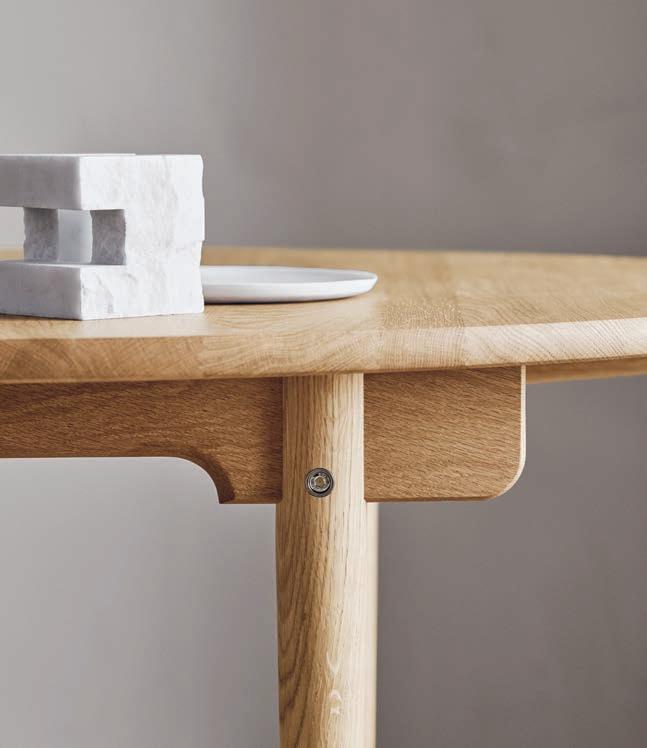
The tables are equal in their width. They all have elliptical plates and are available with up to four loading leaves which allows the tables to easily be adapted to di erent occasions and tasks.

64 Hans J. Wegner 1962 CH337 / CH338
CH339
/
TOP: CH338 TABLE: Table top and legs: Oak, oil. CH88 CHAIR: Frame: Stainless steel. Seat: Sif 90 leather. Back: Oak, oil BOTTOM: CH338 TABLE: Table top and legs: Oak, oil
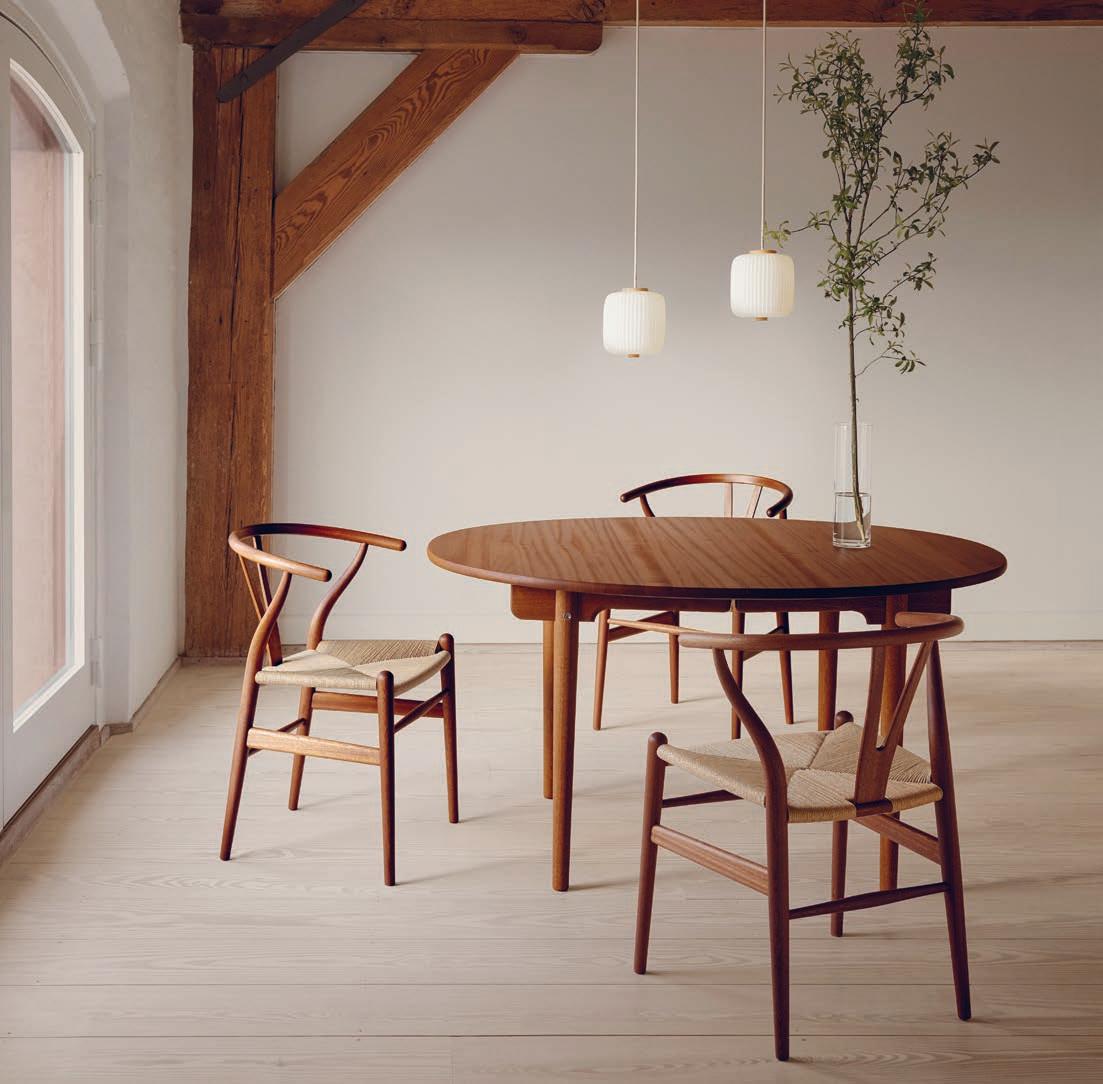
65 Hans J. Wegner 1962
CH337 / CH338 / CH339
CH337 TABLE: Table top and legs: Mahogany, oil. CH24 WISHBONE CHAIR: Frame: Mahogany, oil. Seat: Natural paper cord. EK61 OPAL PENDANT: Opal glass, oak, oil
The small CH388 Dining Table for four people, has a round wooden table top supported by two trestles with round legs and a uniquely shaped rail. The result is a well thought-out composition that still seems extremely modern today.

The round table top is in solid oak with a vertical edge. The cylindrical, removable stainless steel legs meet the oor with visible oor protectors with a small, rounded edge on the side. The legs are attached to both the table
top and the two rails for maximum stability. If the table is split, the two halves can be pulled apart, so that the table can be enlarged with leaves to a maximum of eight seating places.
CH388 is in the same series as Hans J. Wegner’s CH322 Dining Table which has the same table top pro le and similar frame.
66 Hans J. Wegner 1960 CH388
CH388 TABLE: Table top: Oak, soap. Legs: Stainless steel. CH24 WISHBONE CHAIR: Frame: Beech, Soft Grey. Seat: Natural paper cord
A uid fusion of Bauhaus, functionalism and industrial design, this exquisitely crafted writing desk is made from a timeless mix of materials. The AJ52 Society Table is a bold and enduring example of Arne Jacobsen’s functionalist approach to design. The pioneering Danish architect created the piece in 1952, as part of a complete set of o ce furniture for the American-Scandinavian Foundation’s New York o ce, which was commissioned by Burmeister & Wain, a large Danish shipyard.

Ever the visionary, Jacobsen united Bauhaus, functionalism and industrial aesthetics to create this
unique piece, which at the time, was a one-o design. He harnessed brand-new techniques and materials to create the slender writing desk, which features a ne-structured leather top that wraps tightly around a tubular metal frame. A conical desk lamp in brushed stainless steel is a awless addition to the design, as is the glass-fronted, wood-and-veneer letter compartment.
Beneath the table, a six-drawer unit, also in wood and veneer, is suspended from ne metal tubes – a feature that, together with the slim frame and solid-wood feet, adds to the desk’s air of lightness.
67 Arne Jacobsen 1952
AJ52 SOCIETY TABLE
AJ52 SOCIETY TABLE: Table top: Freja 2002 leather. Legs: Stainless steel. Details: Walnut, oil. MO310 TABLE LAMP: Steel black. BM0865 DAYBED: Frame: Oak, oil. Seat: Canvas2 244 fabric
Børge Mogensen designed the BM1160 Hunting Table for the Copenhagen Cabinetmakers’ Guild Furniture Exhibition in 1950. The table combines excellent woodwork with elegant metal brace bars, creating a bold and organic whole. The BM1160 Hunting Table was made by Børge Mogensen. The name refers to the “Hunting Cabin” theme of the Guild’s exhibition, a detail which is also re ected in the table’s robustness and woodfocused design.
Mogensen’s Hunting Table is slightly narrow across the top, which makes it suitable for smaller spaces, while
allowing for more intimate social gatherings. Furthermore, the table is constructed for frequent use with rounded corners and edges in solid wood, which reveals Mogensen’s passion for democratic and accessible design.
The stability is ensured through the use of two diagonal brace metal bars connecting the table top and frame with an aesthetically pleasing e ect. Further detailing, such as the mortise and tenon joints on the legs manufactured in contrasting wood, accentuate the table’s handcrafted expression.

68 Børge Mogensen 1950
BM1160 HUNTING TABLE
BM1106 HUNTSMAN CHAIR: Frame: Oak, oil. Seat: Cognac saddle leather. BM1160 HUNTING TABLE: Table top and legs: Oak, oil. Details: Stainless steel. MO300 LAMP: Steel black. BM0253 SHELVING SYSTEM: Oak, oil, black steel
A sculptural manifestation of innovation.
Designed by Austrian trio EOOS for Carl Hansen & Søn, the Embrace Table E020 is a stylish reinterpretation of a furniture staple, created as part of the intelligent Embrace Series. Crafted from three components, the design has a wooden base, a steel wire structure and a round table top. The result is a distinctive, sculptural expression inspired by a kite blowing in the wind; with table legs that have been pulled to the center to maximize legroom, the piece provides optimal functionality.
The table top is circular and designed to facilitate communication between people as the round shape and added legroom highlights social interaction. Contrasted by the lightness of the frame, the wooden table top seems to oat on the stable frame and will merge seamlessly with the Embrace Chair and Embrace Armchair.


BOTTOM: E020
EMBRACE TABLE: Table top: Laminate, white.
69 E00S 2019 E020 EMBRACE TABLE
TOP: E005 EMBRACE ARMCHAIR: Frame: Oak, white oil. Seat and back: Sunniva 811 fabric. E020 EMBRACE TABLE: Table top: Laminate, black. Legs: Walnut, oil, stainless steel. E004 EMBRACE CHAIR: Frame: Oak, soap. Seat and back: Remix 173 fabric
Legs: Oak, oil, steel black
PROFESSOR DESK / PK52A STUDENT DESK
The PK52 Professor Desk, together with the smaller PK52A Student Desk, designed for the Royal Danish Academy of Fine Arts, established Poul Kjærholm’s reputation for uniting the best of traditional craftsmanship and industrial design.

The Academy needed a number of tables for lecturers and students, and Kjærholm, who had recently joined the academic sta , designed a pair of bespoke tables for the occasion: the larger Professor Desk and more compact Student Desk. Drawing on his cabinetmaking experience, Kjærholm developed a new table structure
that showcased his mastery of steel and wood. Metal ferrules separate the steel and wood to lend these desks a dynamic, light appearance and highlight his signature ability to unite traditional craftsmanship and industrial design. Both desks o er reversible table tops, allowing the user to work on both sides – or use one side for work and the other for meals. They embody the lightness and simple, geometric elegance for which the designer became renowned and established Kjærholm’s pioneering role in Danish functionalism. They also con rmed his position as one of the world’s leading furniture designers.
70 Poul Kjærholm 1955
PK52
PK52 PROFESSOR DESK: Table top: Oak, soap. Legs: Steel black.
Drawer: Oak, black. PK52A STUDENT DESK: Table top: Oak. Legs: Steel black
A bold table that blends new and known materials to create a novel take on functionalism. A true feast for the eyes.
In 2007, Strand + Hvass set out to design a table that would pay tribute to previous masters while exploring new forms and structural directions. The resulting Extend Table represents a new era of modern Danish design with its
minimalist, visually engaging composition and integration of new structural possibilities. Featuring strong, clean lines, the table o ers a perfect pairing of style and stability. Perhaps most importantly, the Extend Table simpli es table extension to an unprecedented degree, with a cleverly hidden foldout system providing easy access to built-in extensions leaves in a bold, modern black nish.

71
Strand & Hvass 2007
SH900 EXTEND TABLE
SH900 EXTEND TABLE: Table top and legs: Oak, white oil. Leaves: Black. KK37490 RED CHAIR: Frame: Oak, white oil. Seat: Sif 98 leather
We choose each and every one of our materials carefully, selecting for strength, durability, tactility, beauty, and the feelings they evoke. By using natural materials such as wood, leather and wool, we strive to craft enduring, meaningful objects that provide a genuine sense of comfort and well-being.
72
COLLECTION 73
SOFAS
The sculptural design of the expertly crafted CH72 Sofa features an upholstered frame and slender legs made from solid wood. First presented in 1952 at the Danish Furniture Design exhibition in Copenhagen, Hans J. Wegner’s CH72 Sofa combines optimal comfort with enduring style.
Designed and exhibited in 1952, Hans J. Wegner’s two-seater CH72 Sofa showcases an incredibly skilful combination of form and function, with a slimline frame that o ers all the comfort of a larger design, while taking up very little space.
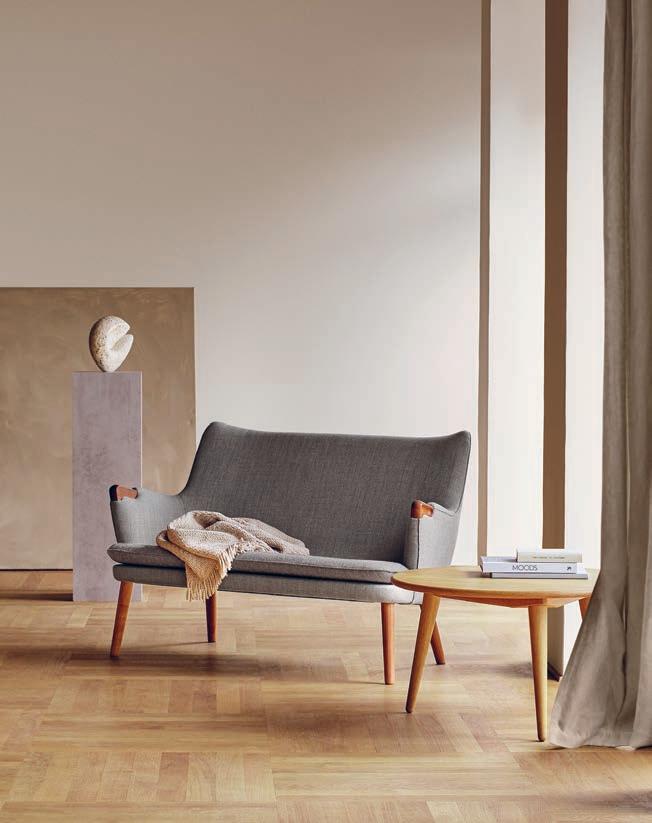
74 CH72 Hans J. Wegner 1952
CH72 SOFA: Frame: Walnut, oil. Back and seat: Remix 133 fabric. CH008 COFFEE TABLE: Table top and legs: Oak, oil
In Hans J. Wegner’s CH100 Series, there is a stainless steel frame in an unconventional design with an upholstered top made by traditional methods.
It is built over an inner frame of solid beechwood and two arm elements, which are upholstered by hand, according to the best quality standards. For dimensional stability, the seat and back cushions have a foam core which is wrapped in a down jacket to enhance the comfort. The stainless steel at frame consists of a longitudinal rail which is joined to the leg with skids at each end. Stainless steel is also included in the arm rests where
it both supports the armrests but also covers the upholstered attachment and creates an exciting contrast to the upholstery. The CH100 Series was designed, in its time, as part of an exclusive o ce furniture range and represents today some of Wegner’s nest work in stainless steel.
The CH100 Series was relaunched in 2008 in connection with the celebration of the 100th anniversary of Carl Hansen & Søn. The series consists of a lounge chair, a sofa in three sizes and two co ee tables.

75 Hans J. Wegner 1970 CH101 / CH102 / CH103 / CH104
CH101 LOUNGE CHAIR Frame: Stainless steel. Seat and back: Sif 92 leather. CH103 SOFA: Frame: Stainless steel. Seat and back: Sif 92 leather. CH106 COFFEE TABLE: Table top: Glass. Legs: Stainless steel
Hans J. Wegner demonstrates with CH162/ CH163 how even a small detail can be so important that it becomes a special feature of the furniture.

In this case, the special feature is the enlarged cover caps in the armrests which conceal the screws in the upper part of the characteristically shaped legs that hold the armrest upholstery to the wooden frame. The wooden cap is made larger for decorative reasons, moved slightly back from the front of the legs, and placed so that the grain is moving in the transversal direction of the leg’s grains.
The sofa’s solid wooden frame is rmly upholstered. The cushions in the seat and back are loose and soften the otherwise straight lines of the sofa. The idea of using down wrapping a foam core in a sofa enabled Wegner to add pleasant comfort to a mostly tight form.
Hans J. Wegner’s CH162 and CH163, with their casual look and pleasant comfort, are appealing for relaxation in both smaller and larger rooms.

76 Hans J. Wegner 1965 CH162 / CH163
TOP: CH163 SOFA: Frame: Oak, soap.
Back and seat: Breeze Fusion 4001 fabric
BOTTOM: CH162 SOFA: Frame: Oak, oil.
Back and armrest: Sunniva 957 fabric
The minimalist Kastrup Series designed by Hans J. Wegner in 1958, is still in use in the inviting interior of Copenhagen Airport to this day. The simple, tubular-steel design proves that upholstered furniture does not need to be large or bulky. Wegner covered the mechanisms by which the upholstered fabric is attached to the frame with a slender, angled element of stainless steel, creating a clean and simple expression.
The design is not only aesthetically pleasing – the series construction is also exceptionally durable for long-term use. The combined backrest and seat are upholstered in either fabric or leather. The entire series has an incredibly light and stream-lined appearance, proving that upholstered furniture can be sleek and modern. The Kastrup Series also includes a lounge chair and elegant sofas in di erent sizes.

77 Hans J. Wegner 1958/1993
/ CH402
CH403
CH401
/
/ CH404 KASTRUP SERIES
CH403 KASTRUP SOFA: Frame: Stainless steel. Back and seat: Sif 95 leather
E300 EMBRACE SOFA
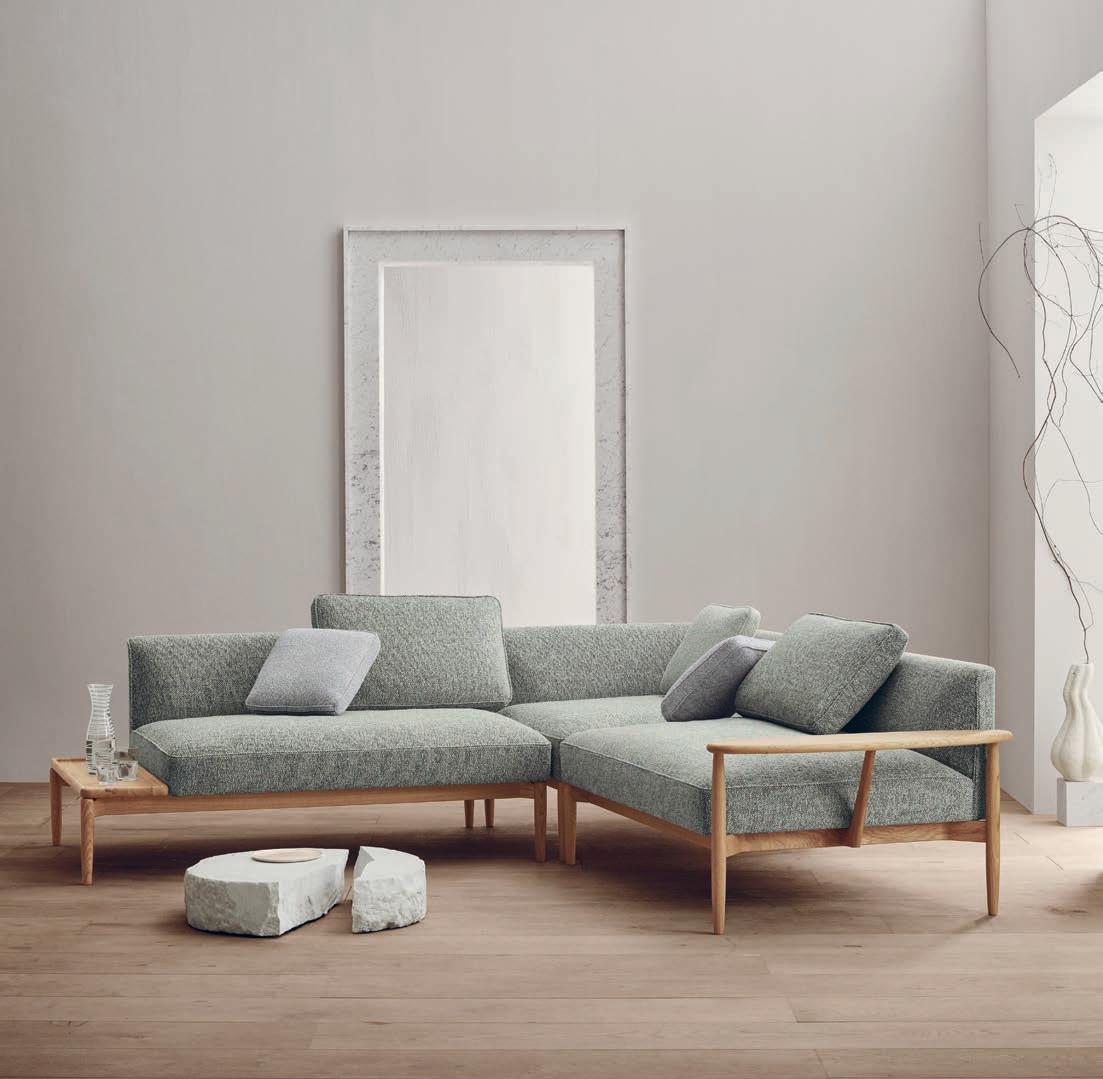
78 E00S 2021
E300 EMBRACE SOFA: E331L/120cm, E301L/120cm and E321R/120 cm: Frame, armrest and table: Oak, oil. Back and seat: Moss 0003 fabric. Pillows: Moss 0003 and Moss 0001 fabric
A modular sofa that unites a stringent geometric expression with unparalleled comfort and craftsmanship.
Striking the perfect balance between a stringent wooden frame and soft upholstery, the E300 Embrace Sofa brilliantly unites Austrian design studio EOOS’s strong sense of contemporary aesthetics with Carl Hansen & Søn’s quality craftsmanship traditions.


The E300 Embrace Sofa was several years in the making. The modular design minimizes the materials used so that the look embodies the design, and the design embodies the look – as minimalistic as it gets, without compromising comfort or function. Comprising ten modules, each of which is combinable in every way imaginable, they can also stand alone, making the sofa exceptionally versatile.
The solid wood frame, armrests and tables are stringent in their expression, while exible in their composition. The upholstery’s piping cord produces ne lines that accentuate the textile or leather seam. A layer of soft feather down on the seat and padded, loose cushions add contrast, providing a pleasant, embracing comfort.
The exible composition of modules allows it to blend into any spatial dimension, from private homes to hotel lobbies, o ces and meeting rooms – from classic and symmetrical to expressive and sculptural, only your imagination sets the limits.
79 E00S 2021 E300
EMBRACE SOFA
TOP: E300 EMBRACE SOFA: E321R/120cm and E331L/120cm: Frame, armrest and table: Walnut, oil. Back and seat: Gentle 0963 fabric. Pillows: Moss 0003 fabric
BOTTOM: E300 EMBRACE SOFA E321R/120cm. Frame and armrest: Walnut, oil. Back and seat: Gentle 0873 fabric. Pillows: Moss 0003 fabric
Designed by Danish cabinetmaker Frits Henningsen, the FH436 Coupé Sofa is a masterpiece of early modern design that remains as intriguing today as it was when it was introduced to the public in 1936.
First presented at the Copenhagen Cabinetmakers’ Guild Furniture Exhibition, the Coupé Sofa demonstrates Henningsen’s artistic sensibilities, his unique sense of proportion, and his vision of modern furniture design. The sofa’s shoulder-height pro le angled rear legs, and elegant armrests also reveal Henningsen’s deep
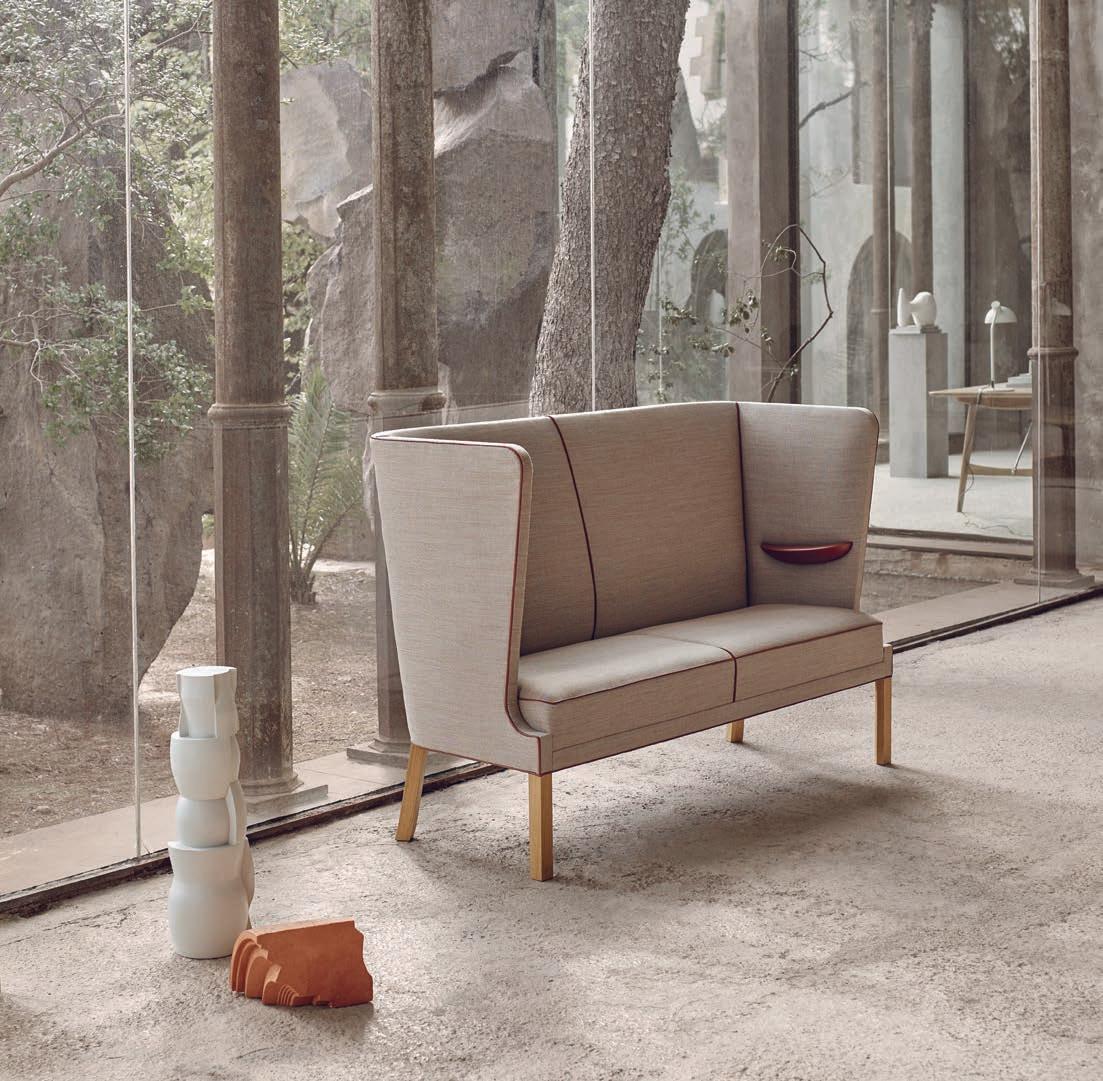
understanding of materials and the importance of quality craftsmanship.
The Coupé Sofa has been recreated according to the precise measurements of Henningsen’s original design and is handcrafted in solid wood and with premium textiles, cushions, and ttings. Every detail of Frits Henningsen’s remarkable Coupé Sofa is crafted with a level of careful, uncompromising attention to detail that honours the designer’s legacy and creative vision.
80 Frits Henningsen 1936 FH436 COUPÉ SOFA
FH436 COUPÉ SOFA: Frame: Oak, oil. Back and seat: Canvas2 244 fabric. Details: Sif 92 leather
KK41180 / KK41181 SOFA WITH HIGH SIDES
Designed in 1930 by Kaare Klint, the KK41181 Sofa was created for Danish Prime Minister Thorvald Stauning’s o ce at Christiansborg Palace. With its re ned, functionalist form, this sophisticated sofa is an eloquent representation of the Danish architect and designer’s longstanding legacy.

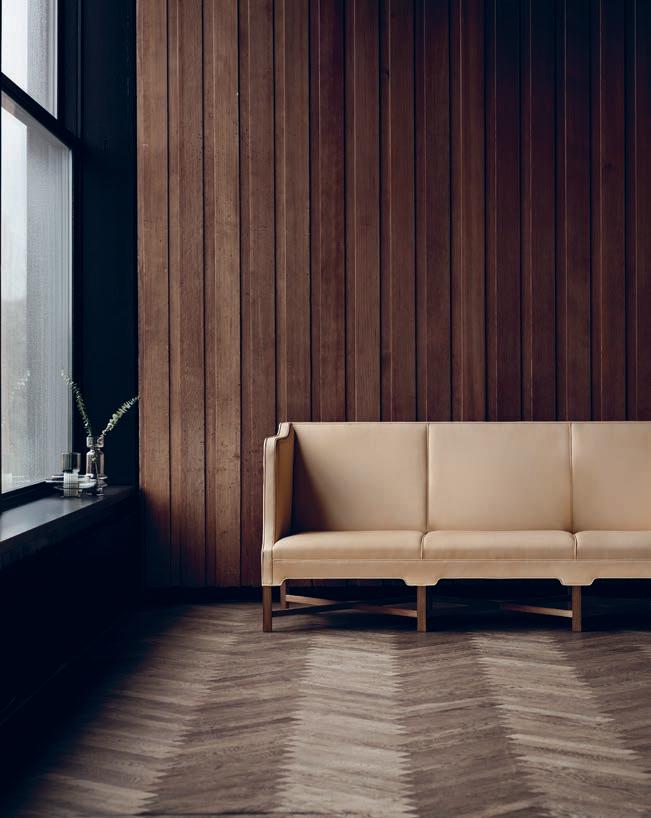
When shown at the Copenhagen Cabinetmakers’ Guild Exhibition in 1937, the KK41181 Sofa was lauded by critics as ‘the best exponent of modern furniture design’ and praised for its ‘mature expression’. Now, almost a century later, the sofa remains a stand-out classic from the Golden Age of Danish Design. Its design is characteristic of Kaare Klint, who was renowned for his extensive anatomical measurements, which formed the basis of his furniture designs. E ortlessly combining grace and comfort, the KK41181 Sofa features high sides and tight leather upholstery. The well-proportioned sofa is divided into sections, each supported by their set of crossbars.
While serving as an elegant design feature, the construction is also practical, creating more legroom and making it easier to rise from the sofa. Originally designed to seat three people, the KK41181 Sofa has since been supplemented with a two-seater alternative known as the KK41180 Sofa. This modi ed version has all the elegance of the larger design, but is suitable for smaller spaces.
81 Kaare Klint 1930
KK41181 SOFA WITH HIGH SIDES Frame: Walnut, oil. Back and seat: Sif 90 leather
Designed in 1933, Kaare Klint’s Addition Sofa is composed of two modules – one with and one without a back – that can be combined to create the ideal seating arrangement for any space. A testament to simpli cation and purpose. This series can be enjoyed for generations with crafted details that capture the essence of classic design.

Inspired by a French rococo sofa, Klint designed a versatile, modern sectional. The rst variant was created in the early 1930s for the prestigious New Carlsberg Foundation o ces in Copenhagen. Klint then continued to re ne the design, presenting the nal Addition Sofa at
the 1933 Copenhagen Cabinetmakers’ Guild Exhibition. The Addition Sofa is trimmed with piping to ensure beautiful, clean seams around the seat and back. The leather pleats create rhomboid panels that are held in place with leather-covered buttons and open up when pressure is applied to the sofa to keep the leather from overstretching. The sofa quickly earned accolades for its simple construction and sophisticated upholstery, including an award at the Copenhagen Saddlemakers’ and Upholsterers’ Guild’s 475th anniversary competition in 1935. Today, the modular design remains a coveted choice for contemporary interiors.
82 Kaare Klint 1933
KK48650 / KK48651 ADDITION SOFA
KK48650 / KK48651 ADDITION SOFA: Frame: Oak, oil. Back and seat: Nature saddle leather. KK87830 PROPELLER STOOL: Frame: Ash, soap. Seat: Canvas fabric
Appreciate the intriguing contrast of slender wooden details and comforting, upholstered cushions in this elegant sofa. Ole Wanscher reimagined his popular OW149 Colonial Chair as a two-seater sofa. Manufactured in very small quantities, the design was virtually unknown until Carl Hansen & Søn launched the entire Colonial Series, including a co ee table, in 2015.
The Colonial Series’ name and style re ect Wanscher’s fascination with 18th century English furniture design, which was often inspired by styles and materials used in the colonies. Based on the same core design as the armchair,
the OW149-2 Colonial Sofa communicates Wanscher’s fondness for re ned detailing. The sofa features a relatively simple lattice construction, its elements supporting one another.
The slender dimensions are kept minimal, the design’s strength is achieved instead through a well-conceived structure that includes double center legs. Wanscher’s trademark interpretation of classic shapes according to modern needs for functionality is evident in the Colonial Sofa’s combination of a timeless expression and a modern approach to materials and construction.

83 Ole Wanscher 1964 OW149-2 COLONIAL SOFA
OW149-2 COLONIAL SOFA: Frame: Oak, oil. Back and seat: Rewool 0768 fabric
Experience a blend of in uences from near and far in the superior craftsmanship and comfort of these classic sofas. Ole Wanscher originally designed the two-seater OW602 and three-seater OW603 Sofas as part of a complete living room set. They have since become treasured classics.
As with many of his other works, Wanscher found the inspiration for this series beyond the borders of his
native Denmark, merging elements of classic English and Oriental furniture to create a new expression.
Comfortable and elegant, with a clean and dynamic design, the sofas combine linear and organic forms to great modern e ect. They continue to be crafted by hand over solid wood frames, carrying on Wanscher’s legacy of exacting craftsmanship.
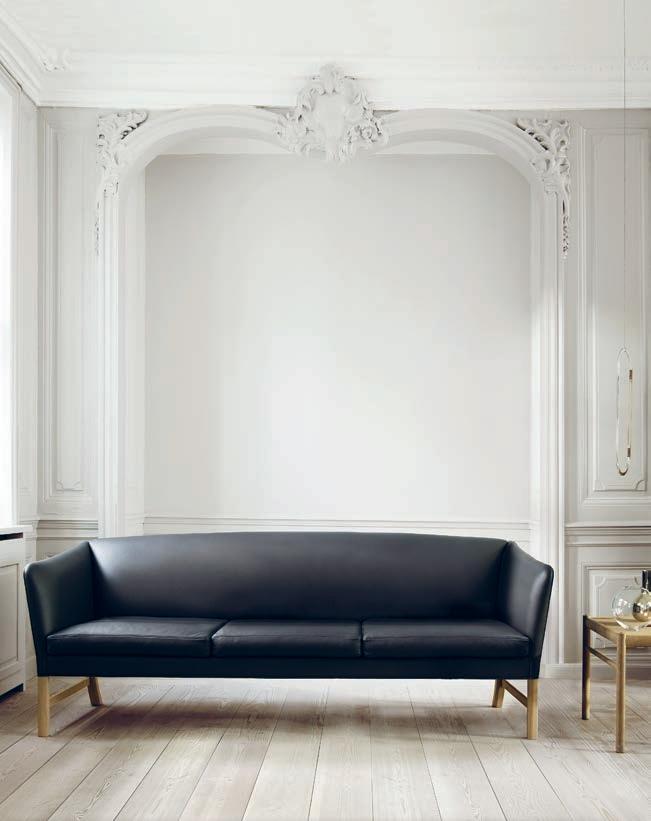
84 Ole Wanscher 1960
/ OW603
OW602
OW603 SOFA: Frame: Oak, oil. Seat and back: Thor 301 leather. OW449 COFFEE TABLE: Table top and legs: Oak, oil
The RF1903 Sideways Sofa from Rikke Frost combines classic materials – wood, paper cord, and high-quality upholstery textile – with a modern asymmetric shape. The steam-bent backrest is shaped from solid wood and woven paper cord for a light, elegant expression, while the seat and back are padded and upholstered for optimal comfort. The result is a sofa you want to sit in for a long time.
As digital devices challenge our traditional ways of conversation, the RF1903 Sideways Sofa provides an equally modern antidote to dialogue and discovery —
and, not least, downtime. Made in Denmark and created by award-winning Danish designer Rikke Frost, the distinctive design eschews the traditional forward-facing sofa in favor of a sideways position that encourages more natural conversation.

In keeping with Carl Hansen & Søn’s DNA, where uncompromising craftsmanship and thoughtful expression seamlessly merge. Classic in its use of materials and contemporary in its form, the RF1903 Sideways Sofa invites both comfort and conversation.

85 Rikke Frost 2020 RF1903 SIDEWAYS SOFA
RF1903 SIDEWAYS SOFA: Frame; Walnut, oil, natural paper cord. Back and seat: Hallingdal 116 fabric
Leather is a natural and authentic upholstery material. It is timeless and durable and can be shaped or sculpted into sophisticated furniture. By 2025 we expect all our leather to be traceable and sustainable.
86
DAYBEDS, BEDS & BENCHES
COLLECTION 87
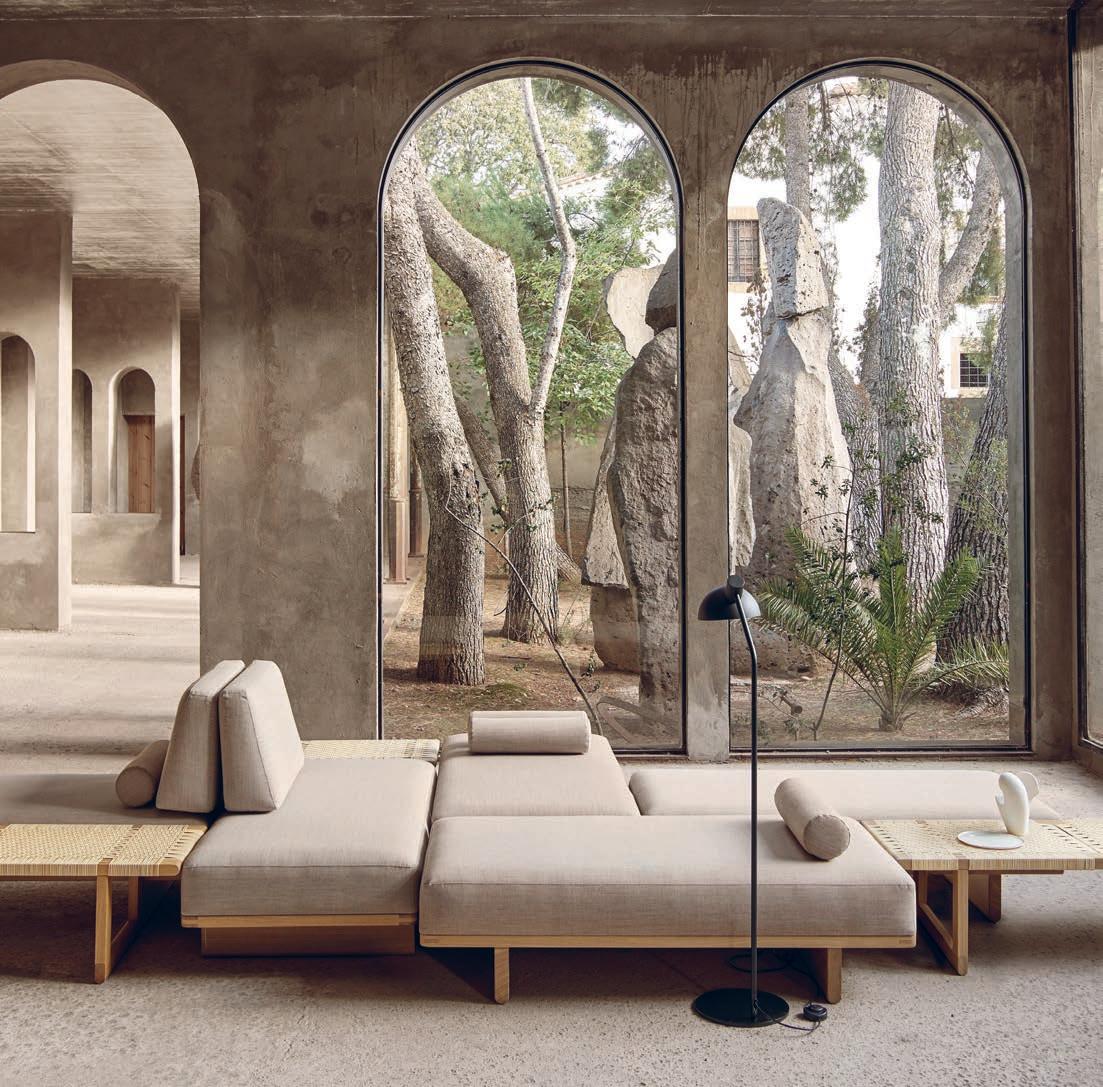
88 Børge Mogensen 1958 BM0865
BM0865 DAYBED: Frame: Oak, oil. Seat and pillows: Canvas2 244 fabric. BM0488 TABLE BENCH: Frame: Oak, oil. Table top: Cane. MO320 FLOOR LAMP: Steel black
At the Copenhagen Cabinetmakers’ Guild Furniture Exhibition of 1958, Børge Mogensen introduced the world to a daybed design that embodied the architect’s ‘building furniture’ concept, which allowed for and encouraged individual furniture pieces to be built upon over time.

As families grew and people’s needs changed, the daybed could stand alone in a space or be arranged to create a larger sofa or bed. In the years following the
1958 exhibition, Mogensen would continue experimenting with the daybed, revising and updating this popular and multi-functional design several times.
Carl Hansen & Søn is proud to have re-introduced the world to the BM0865 Daybed, developed in close collaboration with Børge Mogensen’s family. This deceptively simple design is handcrafted in Denmark and is constructed with solid oak, elegant cabinetry joints, and premium cushions upholstered in high quality fabric.
89
Mogensen 1958 BM0865
Børge
BM0865 DAYBED: Pillows: Canvas2 244 fabric, nature saddle leather
Create a new dynamic in any room with these iconic pieces, crafted from natural materials that express a passion for exploration and original thought.

Many of Ole Wanscher’s designs have become collector’s items by virtue of their timeless simplicity and beautiful nishes. His distinctive daybed exempli es his creative vision and masterful touch. Intrigued and inspired by classic furniture, Wanscher studied it wherever he went,
incorporating the styles and elements he felt best merged functionality and aesthetics into his own work.
The clean, classic daybed features a single long cushion that appears to oat above an angular, solid oak frame, but is in fact supported by a delicate yet strong cotton webbing. Hand-sewn buttons create a simple square pattern that accentuates the daybed’s geometric form, while an optional bolster pillow enhances user comfort.
90 Ole Wanscher 1963 OW150
OW150 DAYBED Frame: Oak, soap. Seat: Sif 95 leather. FK63 BOOKCASE SYSTEM: Frame and fronts: Oak, oil. Handles: brass
Distinctive, simple and con dent. This re ned design made with great passion and quality materials is a true modern masterpiece. With its sleek and straightforward
appearance and seamless combination of leather, wood and stainless steel, the TK8 has a powerful presence that ts as neatly into living rooms as into public spaces like the modern Copenhagen Airport. The frame, produced without welding, is easy to assemble using just a few bolts. The daybed is available in two sizes with an optional pillow for added comfort.
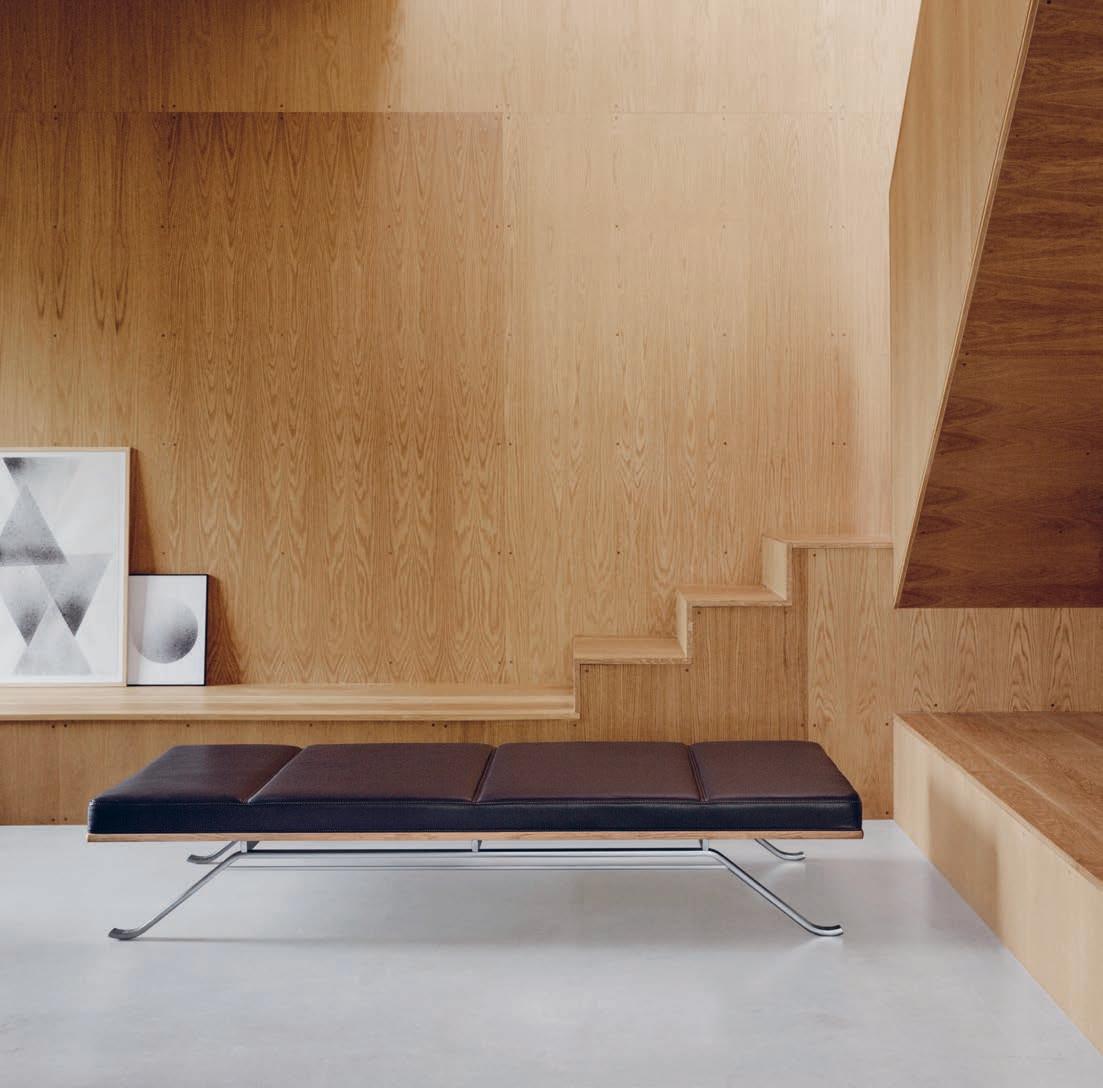
91 Thomas Bo Kastholm 2009 TK8
Designed in 2009 to enhance any lounge setting, Thomas Bo Kastholm’s TK8 Daybed became an instant classic.
TK8 DAYBED: Frame: Oak, oil, stainless steel. Seat: Thor 301 leather
The two family-owned companies, Danish Carl Hansen & Søn and Swedish DUX, jointly created a bed in a simple design based on sketches found in Børge Mogensen’s archives. With its simple design and compelling choice of materials, the BM0555 Bed combines the best of two worlds – DUX’s expertise in sleeping comfort, and Carl Hansen & Søn’s tradition for superb craftsmanship and design.

The bed features many of Børge Mogensen’s characteristic details, including the beautiful visible
mortise joints which require great precision and meticulous craftsmanship.
Børge Mogensen’s focus on creating designs that last for generations is also evident in the bed which has a sturdy frame made of solid oak and rectangular and cylindrical cushions that complete the look with straps in saddle leather. The DUX spring core mattress has been specially developed for the bed, and is upholstered in durable light grey DUX textile with exclusive, hand-sewn piping cord.
92 Børge Mogensens Tegnestue 1958/2021 BM0555 BED
BM0555 BED: Frame: Oak, oil. Pillows and neckpillows: Moss 021 fabric, cognac saddle leather

93 Børge Mogensens Tegnestue 1958/2021 BM0555 BED
BM0555 BED: Frame: Oak, oil. Pillow and neckpillow: Moss 06 fabric, cognac saddle leather
BM0488 / BM0488S
TABLE BENCH

94 Børge Mogensens Tegnestue 1958/2021
BM0488 TABLE BENCH: Frame: Oak, oil. Table top: Cane
The BM0488 Table Bench was originally designed in 1958 by Børge Mogensen. It is expertly crafted in oak heartwood with a supportive, double-woven wicker seat. The soulful, standalone piece is just as appropriate as a bench in an entrance hall or at the end of a bed as it is in the living or dining room as a co ee or side table.
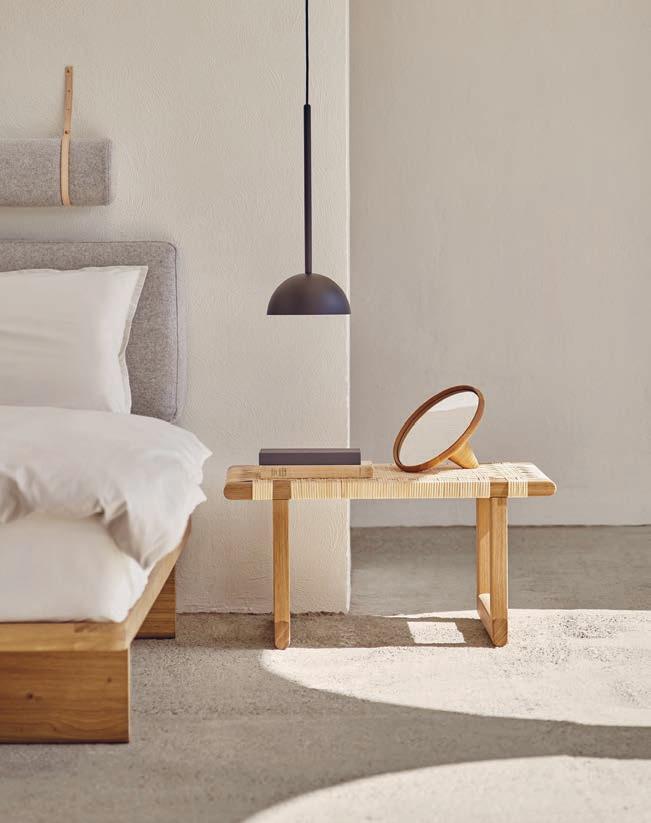
Versatile, timeless and carefully crafted, the BM0488 Table Bench was originally created to complement the BM0865 Daybed. The multi-functional piece forms part of Mogensen’s ‘building furniture’ concept – enduring furniture that could be added to and adapted over time in response to changing needs and living situations. The BM0488 is crafted in solid oak, where the dense and awless inner portion of the trunks known as heartwood is skillfully shaped with traditional cabinetry joints and rounded edges that repeat in the legs and rails. Topped with wicker, the durable and decorative design will look beautiful for generations to come.
The BM0488S Table Bench is a shorter version the BM0488, with the same characteristic woven seat, understated details and precise craftsmanship. Its more modest dimensions can easily be combined with its predecessor to create one uid piece of furniture, but it also serves as an independent piece that exudes wellbeing wherever it is placed.
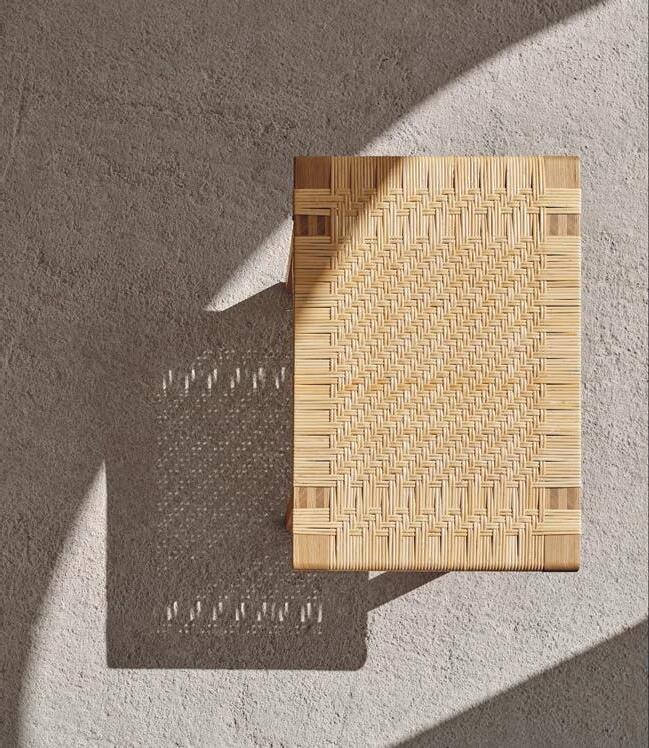
95 Børge Mogensens Tegnestue 1958/2021 BM0488 / BM0488S
TABLE BENCH
TOP: BM0488S TABLE BENCH: Frame: Oak, oil. Table top: Cane MO330 PENDANT: Steel black. BM0555 BED: Frame: Oak, oil. Pillow and neckpillow: Hallingdal 0110 fabric, nature saddle leather
BOTTOM: BM0488S TABLE BENCH: Frame: Oak, oil. Table top: Cane
We design and manufacture furniture to last for generations. To ensure the greatest possible enjoyment from your furniture and the longest lifespan, it is important that it is properly looked after.
96
COFFEE TABLES
COLLECTION 97
The CH008 Co ee Table is a ne example of Hans J. Wegner’s preference for simple, clear and interesting solutions.
CH008 consists of a round table top on a frame with three detachable, tapered legs. To support the table top, and as a link between the top and the legs, the table has a solid triangular frame, the corners of which are cut o at an angle at the edge of the table top. The legs are screwed into these surfaces to achieve their slanted outward direction. The rounding of the legs gives the
co ee table an elegant and almost oating look. The simple and elegant CH008 Co ee Table, crafted from solid wood, works especially well with other well-known pieces by Wegner, particularly his lounge chairs.
The table’s solid top with rounded corners is available in 3 di erent sizes and in three di erent heights. This gives the customer the possibility of putting the table together according to what best ts one’s existing furniture. With only 3 legs, the co ee table is also well suited for slightly uneven oors.

98 Hans J. Wegner 1954 CH008
CH78 MAMA BEAR CHAIR: Frame: Walnut, oil. Seat: Hallingdal 100 fabric, Sif 95 leather. CH008 COFFEE TABLE: Table top and legs: Walnut, oil
The CH011 Co ee Table was designed by Hans J. Wegner in 1954. Its four tapered legs tilt slightly outwards towards the two sides of the table, giving the solid top an elegant lightness, which is only further highlighted by the rounding of the legs towards the oor.
The table top’s simple expression and natural wood surface with the grain running lengthwise makes it more adaptable for di erent uses. CH011 is intended primarily as a co ee table but, with its narrow width, it also works well as a side. As a link between the top and the leg,
there is a solid wooden frame formed like a wide letter H. This has two purposes: It stabilizes the solid wood table top; and with its angled cuts at the free ends of the H, it ensures that the detachable legs are slanted. The softly rounded pro les of the rectangular table give it a welcoming look that ts particularly well with many of Wegner’s wooden chairs.
The CH011 Co ee Table is manufactured in oak and is available in three heights. CH011 is in the same series as CH008, the round co ee table.

99 Hans J. Wegner 1954 CH011
CH011 COFFEE TABLE: Table top and legs: Oak, oil
Hans J. Wegner’s square shaped CH106 Co ee Table is part of his furniture series CH100 from 1970, along with another co ee table, a lounge chair and three sofas – all with a similar base frame.
The sturdy, square glass table top rests on a frame consisting of two trestles in bent at steel, which are connected via two transverse steel rails. The rails also function as a support for the top, whose polished glass makes the frame’s structure fully visible. With the frame´s soft bends and the rounded corners of the glass, the
design looks soft and harmonious despite its solid materials.
The CH106 Co ee Table is a ne example of Hans J. Wegner’s viewpoint about good design which aims at nding a balance between the simple and the characteristic. The table also shows that Wegner was not timid about working on designs based on materials other than wood. In addition to the square shaped CH106, Wegner designed a rectangular version of the table, CH108.

100 Hans J. Wegner 1970 CH106 / CH108
CH106 COFFEE TABLE: Table top: Glass. Legs: Stainless steel. CH111 CHAIR: Frame: Stainless steel. Seat and back: Thor 301 leather
Hans J. Wegner designed the CH415 Co ee Table relatively late in his career. His idea was to make a small, low table with a frame that matches with his sofas CH402, 403 and 404 for the Copenhagen Airport. CH415 is an example of how Wegner would take on small simple design tasks as well as bigger, more complicated ones.
The design consists of a small, round solid wood table top with a vertical edge supported by a frame with four slim stainless steel legs. From the table top downwards,
the legs slant slightly outwards to end vertically on the oor in round glides. It was especially important for Wegner that the solid wood table top was stable and that the light table stood securely on the oor.
CH415 can easily be moved around and used as a co ee table, a side table as well as a little extra seat. The table, with its specially shaped steel frame, ts particularly well with Wegner’s upholstered lounge chairs with similar legs.
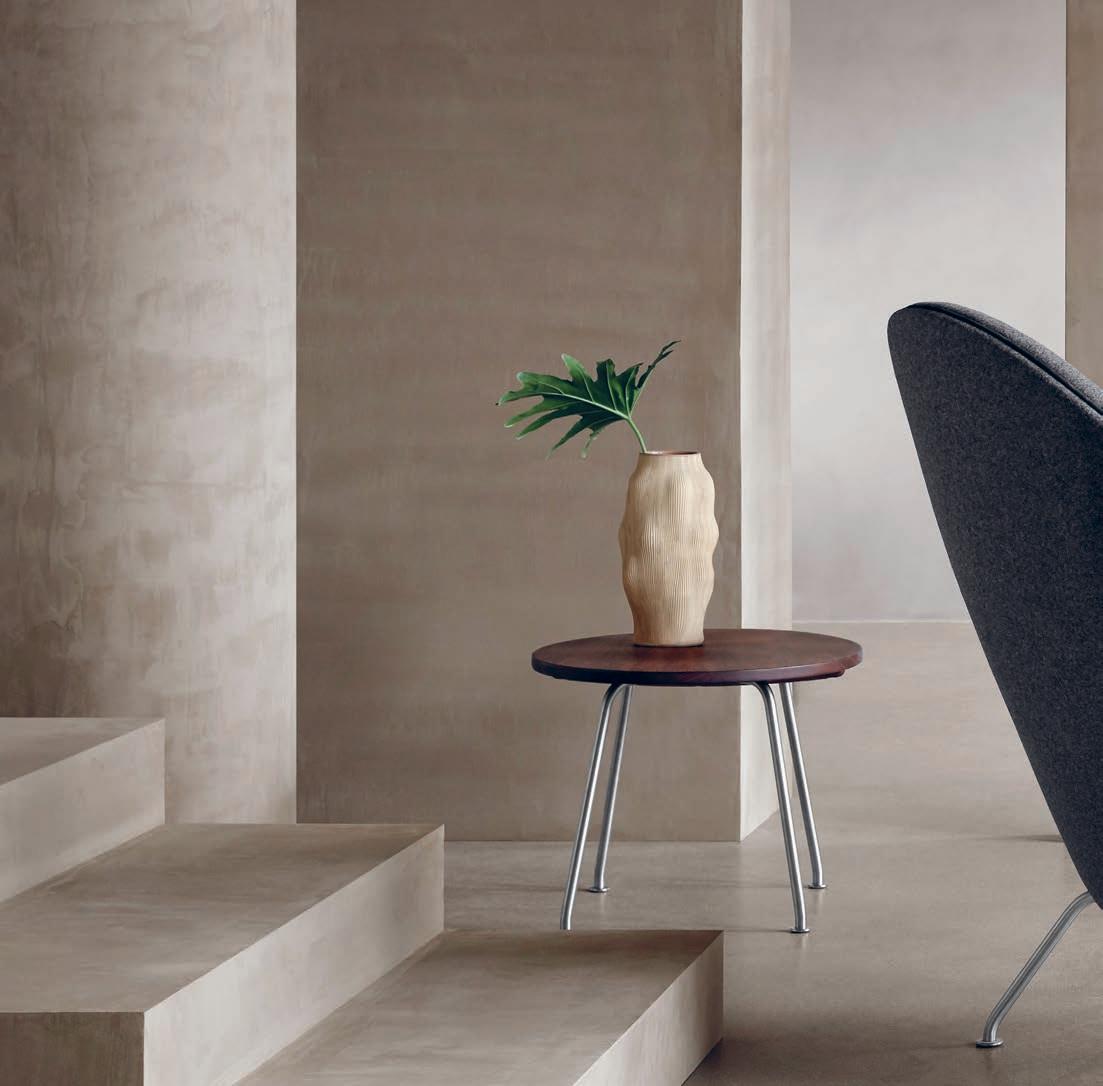
101 Hans J. Wegner 1990 CH415
CH415 COFFEE TABLE: Table top: Walnut, oil. Legs: Stainless steel
Hans J. Wegner’s CH417 Tray Table combines two simple parts – a reversible round tray and a collapsible stainless steel base – into a smart and easy-to-store solution that is both simple and practical.


The light tray has a natural colored oak rim, which is available in a version with black laminate on one side and
white on the other side or with oak and walnut on either side. The tray’s rim is made of shaped veneer in light oak, which is held together by a narrow piece of walnut. In addition to encasing the tray, this narrow piece acts as a handle, as a groove in the tray, making it easier to hold the tray when being carried.
102 Hans J. Wegner 1970
CH417 TRAY TABLE
LEFT:
MAMA BEAR
CH417 TRAY TABLE: Table
RIGHT:
TABLE
CH78
CHAIR: Frame: Oak, oil. Seat: Fiord 0191 fabric.
top: Oak, oil. Legs: Stainless steel
CH417 TRAY
Table top: Oak, oil. Legs: Stainless steel
The E021 Embrace Lounge Table is available in two heights – as a low co ee table and a slightly taller and slimmer side table. Both versions highlight the light expression of the Embrace Series, where the circular wooden table tops seem to oat on stabilizing steel
structures inspired by kites blowing in the wind. Designed by Austrian design trio EOOS for Carl Hansen & Søn, the E021 Embrace Lounge Table ts with any interior, both public, private and corporate.

103 E00S 2019 E021 EMBRACE
LOUNGE TABLE
E300 EMBRACE SOFA: Frame: Oak, oil. Seat: Moss 03 fabric. E021 EMBRACE LOUNGE TABLE: Table top and legs: Walnut, oil. Details: Black powder coated steel. MO310 TABLE LAMP: Steel white
The beauty and organic lines of this functional co ee table do justice to its complex origin of intricate study and foreign lands.
Mogens Lassen rst exhibited this round co ee table, inspired by folding stands found in Tutankhamen’s tomb in 1922, at the Copenhagen Cabinetmakers’ Guild Exhibition in 1940. The elegant table easily collapses for storage with the release of a small brass sliding latch beneath the table top – a exible design that exempli es the functionalism inherent in classic furniture types. For Lassen and his contemporaries, function was
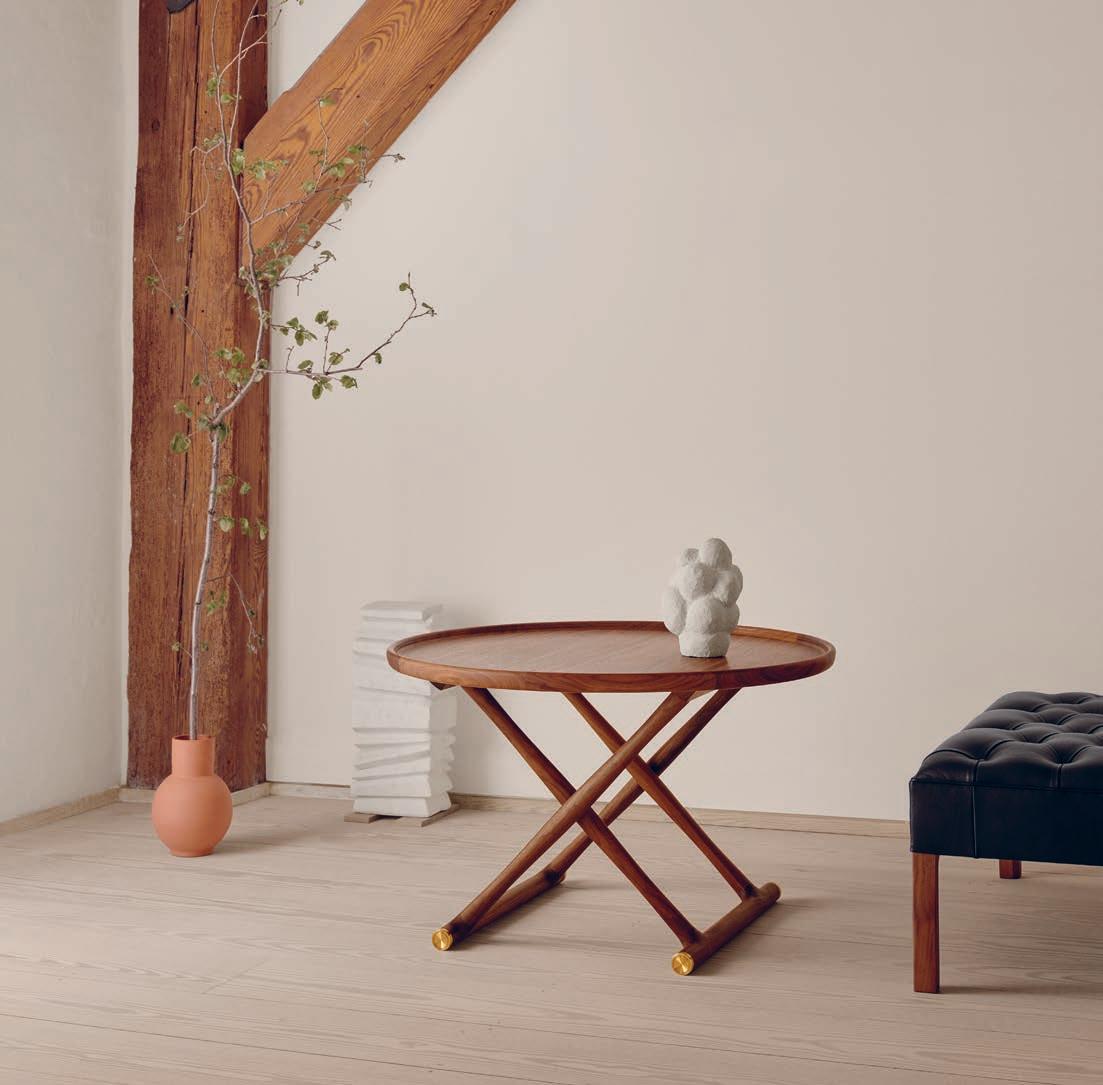
paramount. Their approach – strongly in uenced by Kaare Klint – often began with the careful study and re nement of long-existing archetypes such as safaristyle knockdown chairs, British Windsor and Chippendale chairs, and exible, practical tables like the ML10097 Egyptian Table.
These clear, proven furniture types appealed to midcentury design and architecture visionaries, upholding their core belief that intelligent, purposeful design never goes out of style.
104 ML10097 EGYPTIAN TABLE Mogens Lassen 1940
ML10097 EGYPTIAN TABLE: Table top and legs: Walnut, oil. KK48650 ADDITION SOFA: Frame: Walnut, oil. Seat: Sif 98 leather
OW449 COLONIAL COFFEE TABLE
As an integral part of the Colonial furniture series, this co ee table stands proud with elegant lines and an appealing aesthetic.
he
a
Wanscher’s desire to lend modern style and utility to classic objects. Featuring a square veneer table top and framing that mirrors that of the OW149 Colonial Chair and OW149-2 Colonial Sofa in its precise detailing, raised corners, and geometric aesthetic, the table enhances contemporary settings with its understated, thoroughly thought-through form.

105 Ole Wanscher 1964
Designed by Ole Wanscher when
developed
two-seater version of his Colonial Chair – creating a harmonious focal point for the entire Colonial Series. The OW449 Colonial Co ee Table communicates
OW149-2 COLONIAL SOFA: Frame: Oak, soap. Seat: Sif 98 leather. OW449 COLONIAL COFFEE TABLE: Table top and legs: Oak, black. OW449 COLONIAL COFFEE TABLE: Table top and legs: Walnut, oil
Wood is our great passion. Along with the classic Scandinavian varieties such as oak, beech and ash, we also incorporate fine cherry, walnut, maple, mahogany and teak into our production.
106
COLLECTION 107
STORAGE
Hans J. Wegner designed the CH825 Credenza in 1959 as one of the several credenzas that, with their calm appearance and functional interior. In 2014, Carl Hansen & Søn relaunched one of these credenzas, CH825.
When the two roller shutter doors on the Wegner credenza CH825 are slid to one side and behind the interior backing, the interior of the credenza is fully accessible. If the credenza is closed, the doors form a calm, continuous veneer surface with the vertical grain texture. As a grip, a vertically placed piece of wood is
attached through a thin, square steel plate to the solid vertical front edge of the door. The interior of Wegner’s credenza is tted with a combination of shelves and pullout trays, which as a starting point, provide useful and diverse storage space. The shelves can be adjusted as needed.
The credenza can be chosen with either round legs in solid wood which t with most of Wegner’s chairs and tables or with a curved steel frame which is also used in his CH100 Series.
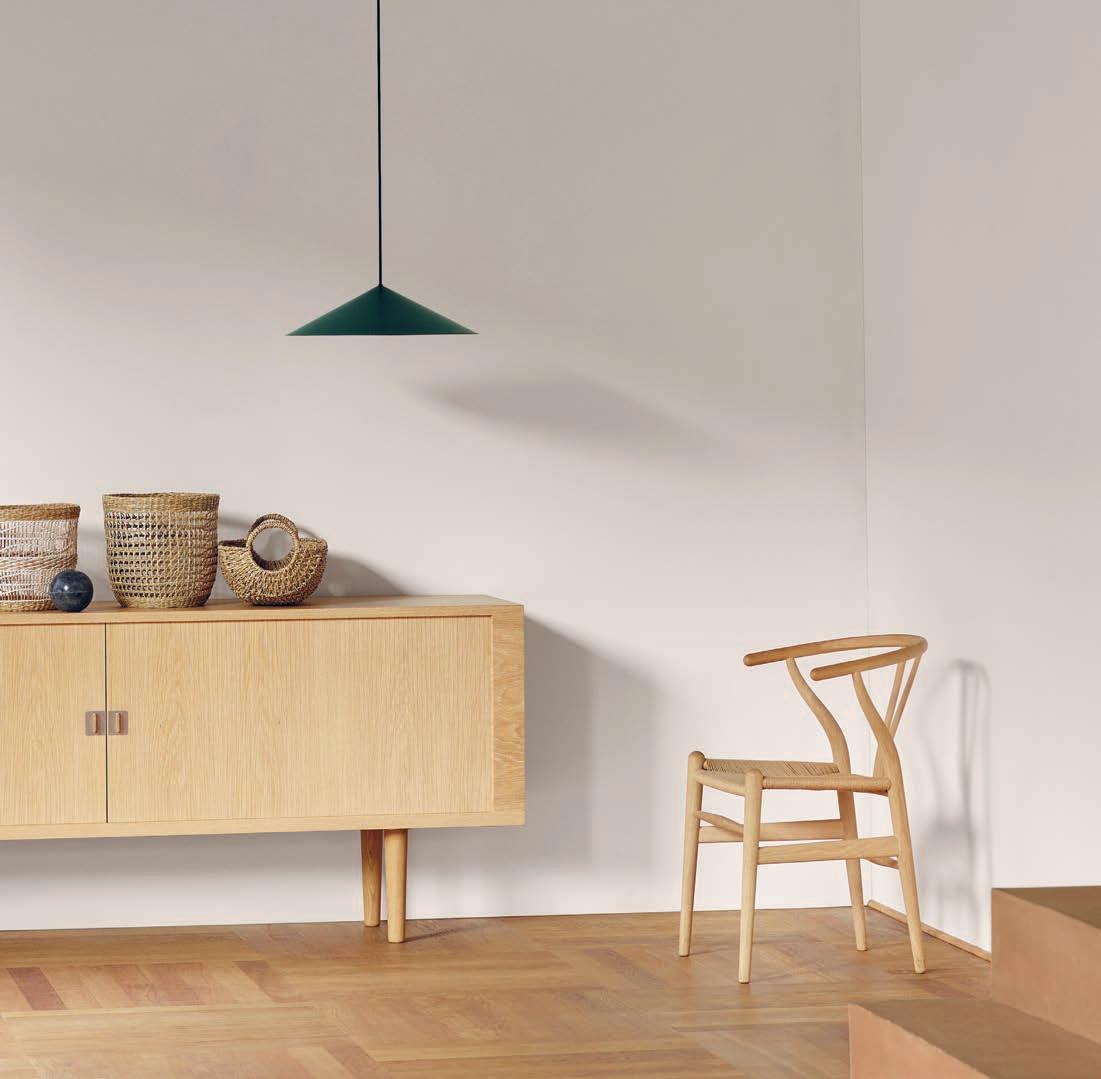
108 Hans J. Wegner 1959 CH825 CREDENZA
CH825 CREDENZA: Cabinet and legs: Oak, oil. CH24 WISHBONE CHAIR: Frame: Beech, soap. Seat: Natural paper cord. BT1001 PENDANT LAMP NO 1: Steel green
BM0253 SHELVING SYSTEM
In 1953, the Danish architect Børge Mogensen designed a exible, module-based shelving system for Søborg Møbelfabrik (Søborg Furniture Factory), but Mogensen’s system was never put into production.
The BM0253 Shelving System is a continuation of Mogensen’s byggemøbler (or building furniture) concept, which centred on the idea that furniture should be simple enough to endure aesthetic trends while, at the same time, be exible enough to respond to the changing needs of people and the spaces they inhabit.

The BM0253 Shelving System consists of wooden shelves that feature elegantly rounded edges and cabinets with sliding doors that feature intricately milled handles. The color scheme for the cabinet doors was carefully selected to honour the designer’s original drawings, and was chosen with the help of Børge Mogensen’s family.
The interchangeable elements of the system come in varying sizes, so that custom solutions can be assembled and adapted to meet the individual needs of the user. The shelving system is a furniture piece that can be added to, adjusted, and reimagined over time and can, therefore, adapt as it is moved from space to space, extending its useful function for many years to come.

109 Børge Mogensen 1953
TOP: BM0253 SHELVING SYSTEM: Cabinet and shelves: Walnut, oil, steel black. Fronts: Walnut, oil, black and blue. BM0865 DAYBED:
Frame: Oak, oil. Seat and pillows: Canvas2 244 fabric
BOTTOM: BM0253 SHELVING SYSTEM Shelves: Oak, oil, steel black
FK63 BOOKCASE SYSTEM
The FK63 Bookcase System, designed by Preben Fabricius and Jørgen Kastholm, embodies Carl Hansen & Søn’s commitment to craftsmanship excellence and timeless design. Devised for maximum exibility, the di erent modules can be combined in a multitude of ways to suit every space and need. Visit our customizer online to design your own.
Designed for idiosyncratic displays of functional and aesthetic objects, FK63 Bookcase System transforms rooms with its bold presence. Designed in 1963 by Preben Fabricius and Jørgen Kastholm, the piece is the result of a shared interest in functionally minimalist designs that focus on proportion, handcrafted details, and natural materials.

The FK63 Bookcase System embodies the designers’ uncompromising approach to design, crafted in FSC™-certi ed solid oak, oiled to accentuate the texture and grain of the wood. It features thoughtful joinery details including full-width cabinets tted with brass handles and open shelves with optional sliding trays – both of which are customizable to accommodate growing collections. Available in wall-mounted and standalone versions, the latter of which rests on a slender powder coated metal frame.

110 Fabricius & Kastholm 1963
FK63 BOOKCASE SYSTEM: Cabinet and bookcases: Oak, oil. Drawers: Ash, white oil. Handles: Brass. PK52 PROFESSOR TABLE: Table top: Oak, oil. Frame: Black powder coated steel
FK63 BOOKCASE SYSTEM

111 Fabricius & Kastholm 1963
FK63 BOOKCASE SYSTEM: Bookcases: Oak, oil. OW149 COLONIAL CHAIR: Frame: Oak, soap. Back and seat: Rewool 218 fabric
We use only the best and most environmentally friendly surface treatments when manufacturing our high-quality furniture, because we are dedicated to protecting our environment and reducing the environmental impact of our activities.
112
CHILDREN’S FURNITURE
COLLECTION 113
CH410 PETER’S CHAIR / CH411 PETER’S TABLE
Designed as the perfect gift decades ago, this furniture set by Hans J. Wegner has remained a cherished classic for kids’ rooms and continues to o er the ultimate combination of carefully considered design and an engaging toy.

The CH410 Peter’s Chair was created by Wegner during World War II. Finding quality products in wartime Europe was not easy, so when he needed a suitable christening gift for Peter, the son of his friend and fellow furniture designer Børge Mogensen, Wegner took matters into his own hands and crafted the gift himself.
An accomplished cabinetmaker, Wegner conceived and built a simple yet ingenious chair and table that would work as both a functional piece of furniture and an engaging toy. Designed as a life-size three-dimensional puzzle in untreated beech, the pieces are easily assembled without the use of tools.
The 1944 CH410 Peter’s Chair and CH411 Peter’s Table reveal the extent of Wegner’s innovative spirit as well as his superior ability to ful l the natural interest of children without compromising on design and quality.
114 Hans J. Wegner 1944
CH410 PETER’S CHAIR: Frame: Beech, untreated. CH411 PETER’S TABLE: Table top and legs: Beech, untreated. BM0253 SHELVING SYSTEM: Frame: Oak, oil, black powder coated steel, grey doors
ND54 HIGH CHAIR
The ND54 High Chair is an acclaimed work of modern children’s furniture, designed by the wife and husband team of Nanna and Jørgen Ditzel.

In 1954, the Ditzels welcomed twin daughters – Lulu and Vita – into their family. That same year, the couple used their daughters as a reference for how to determine the proportions of the High Chair, which was designed as a companion to a dining room set they had recently designed. In 1955, the High Chair was introduced to the public at the Danish Arts & Crafts Exhibition in Copenhagen. Although the Ditzels created a number of children’s furniture pieces together, the High Chair is widely regarded as their masterpiece.
Handcrafted in solid beech, the High Chair has been designed to adapt to the changing needs of growing children, so that the chair can be used by children up until the age of ve. Each High Chair is beautiful and durable enough to be handed down for many years of use.

115 Nanna & Jørgen Ditzel 1954
TOP: ND54 HIGH CHAIR: Frame: Beech, lacquer. Details: Cognac saddle leather BOTTOM: ND54 HIGH CHAIR: Frame: Beech, lacquer
Continuing our legacy of purposeful design, uncompromising craftsmanship and timeless aesthetics, the lighting collection illuminates spaces with comfort and simplicity.
116
COLLECTION 117
LIGHTING
PENDANT LAMP NO 1 / BT1041 CALOT
Originally created in the late 1960s, the BT Ligthing Series was designed by proli c Danish architects Claus Bonderup and Torsten Thorup. Three designs, di erent in size and shape but united by their stylish simplicity and a common feature: a half-mirror light bulb peeking out from under the lamp shades.

Revealing the light source in all of the lamp designs was a conscious choice for Claus Bonderup and Torsten Thorup. As such, the sleek pendants acquire further visual appeal, while the half-mirror bulb re ects the light onto the white interior of the shades, creating indirect
lighting. The silhouettes are characterized by cones, squares and circles in carefully balanced proportions, making them an ideal match for classic as well as modern interiors. Alongwith their functionalist features, the small Confetti Lamp, the larger Pendant Lamp No 1 and the largest Calot Lamp o er versatile illumination for global homes and public spaces alike. The pendants come with LED half-mirror light bulbs and a fabric cable. As a more recent addition to the original black or white, the lamps are now available with dark green or polished brass shades. Whether suspended over a staircase or softly lighting up a dinner table.
118 Torsten Thorup & Claus Bonderup 1970
BT1091 CONFETTI / BT1001
BT1001 PENDANT LAMP NO 1, MO330 PENDANT, BT1041 CALOT LAMP, BT1091 CONFETTI LAMP: Steel black. BM0865 DAYBED Frame: Oak, oil. Seat and pillow: Canvas2 244 fabric
A classic lamp, designed in 1961 but never been in production before, is now launched in mouth-blown opal glass and certi ed oak. Created by the son of prominent designer Kaare Klint, the understated and elegant pendant, available in three sizes, emits soft, indirect light thanks to its careful combination of classic materials. Originally imagined in pleated plastic, the design was too complicated to produce at the time and remained stored

in the family archives until now. The new iteration features a pleated, super-elliptical shape with distinctive top and bottom pieces, evoking traditional Chinese lanterns. The lamp’s materials – mouth-blown opal glass and oak, meticulously turned and honed by hand, give it a classic look, ennobling the original design.
Elegantly complementing Carl Hansen & Søn’s existing collection of lighting, the Opal Pendant blends in beautifully above the dining table, in the hall, in the living room or in the bedroom, while being a lamp which can stand alone or be combined in clusters.
119 Esben Klint 1961 EK61 OPAL PENDANT
Danish architect and cabinetmaker Esben Klint joins Carl Hansen & Søn’s prominent group of designers with the EK61 Opal Pendant.
EK61 OPAL PENDANT: Opal glass, oak, oil
This MO Lighting Series is a collection of four exquisitely minimalistic lamps designed to bring a sense of serenity and warmth into any interior space.

Inspired by the comforting e ect that light has on the human experience, especially during the dark days of winter, Danish designer Mads Odgård chose to focus on two simple and familiar shapes for the MO Lighting Series: the hemisphere and the cylinder, forms with clear, logical connections to natural light. The MO Lighting
Series consists of a wall lamp, oor lamp, tablelamp, and a pendant lamp – each of which was designed to serve a speci c function. Because the forms of the cylinder and hemisphere are featured in all four lamps, the individual models work together to create a sense of calm through repetition. With this in mind, all four lamps can be used in di erent ways within the same environment, or several of the same lamps can be used together to bring a sense of harmony and comfort to a space.
120 Mads Odgård 2020
/ MO310
MO320
MO300
/
/ MO330
MO300 WALL LAMP, MO310 TABLE LAMP, MO330 PENDANT, MO320 FLOOR LAMP: Steel black
A simple, sculptural expression rooted in nature. A complement to Carl Hansen & Søn’s existing collection of classic lighting designs, the RF200 Table Lamp, designed by Rikke Frost, is distinguished by its ability to create mood lighting.
The distinctive composition of wood, metal and ambient light takes its cues from trees and architectural arches and columns: atop the lamp’s trunk-like wooden base rest two vaulted metal re ectors that illuminate upwards and
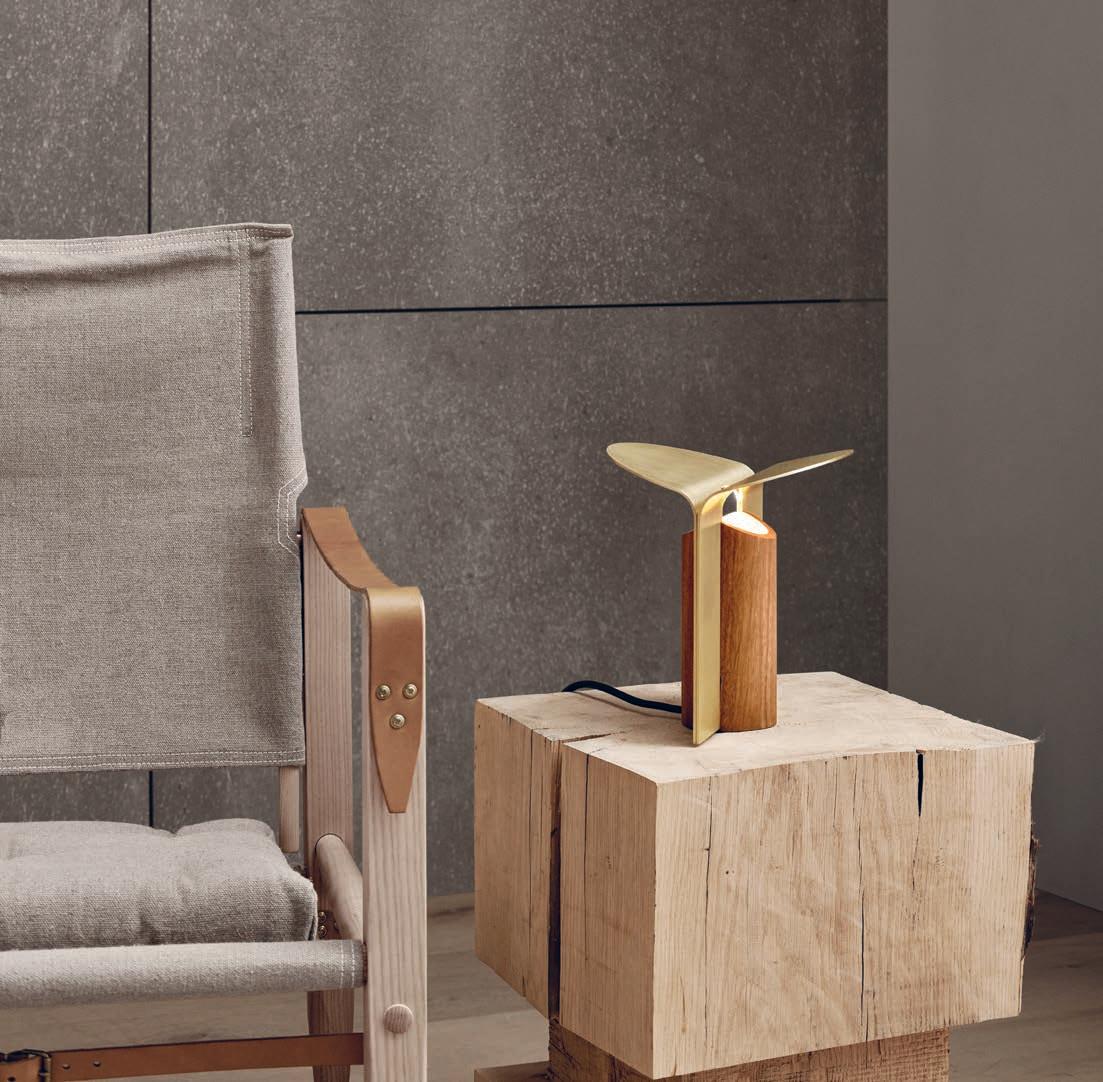
disperse soft, glare-free light downwards through the shades.
Allowing the materials to play a leading role in its simple, organic design, the juxtaposition of warm wood and cool metal coupled with uncompromising craftsmanship ensure the RF200 Lamp is both timeless and modern. The lamp’s base and light re ectors can be joined together in a total of nine di erent combinations, making it possible to tailor its expression to the intended interior.
121 Rikke Frost 2021 RF200 LIGHTING
KK47000 SAFARI CHAIR: Frame: Ash, white oil. Seat: Canvas fabric. Details: Nature saddle leather. RF200 LAMP Brass, oak, oil.
The FSCTM-certified teak used in our Outdoor Furniture Collection is prized for its durability and rich aesthetic qualities. This inherent durability, along with teak’s warm spectrum of colors and its technical versatility, make it ideal.
122
COLLECTION 123
OUTDOOR

124 Bodil Kjær 1959
BODIL KJÆR INDOOR-OUTDOOR SERIES
BK10 LOUNGE CHAIR, BK11 CHAIR, BK12 BENCH, BK14 SUNBED, BK15 TABLE, BK16 TABLE: Frame: Teak, untreated. Cushions: Canvas 5453 fabric
BODIL KJÆR INDOOR-OUTDOOR SERIES
Inspired by the bold geometries of Cubism and guided by the principles of human scale and aesthetic balance, architect Bodil Kjær’s iconic Indoor-Outdoor Series was conceived as a collection of harmonious, contemporary architectural elements that would relate to their immediate surroundings, whether in or out of doors.
Six decades after the initial launch of Kjær’s IndoorOutdoor Collection, Carl Hansen & Søn have now added this timeless series to our collection of design classics. Today, the collection is being produced for the rst time in solid, FSC™-certi ed teak – a durable wood species which can withstand a wide range of weather conditions and will develop a beautiful patina over time.
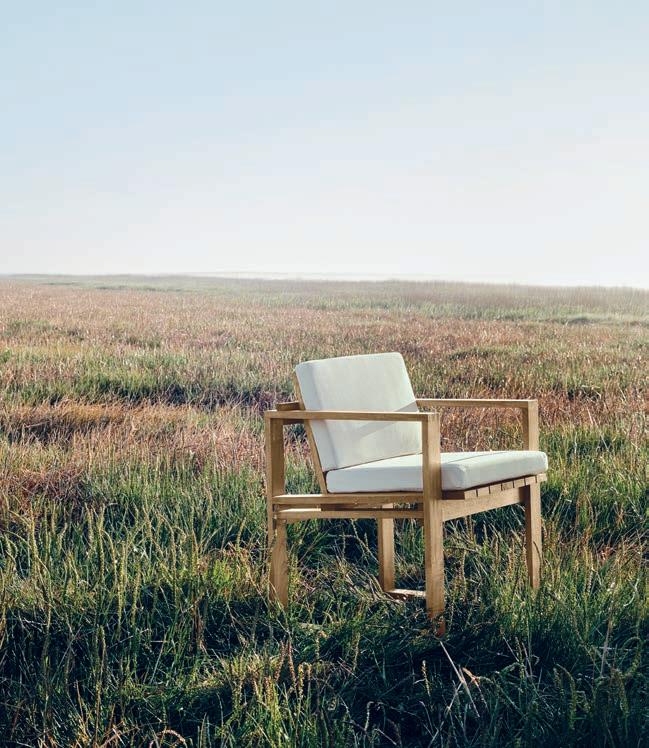

The Indoor-Outdoor Series comprises a lounge chair, a small table, a dining table, a dining chair, a two-seater bench, a swing seat, and a sunbed. All seats, chairs, and beds can be supplied with slender cushions made from weather-resistant Sunbrella fabric.
Cushions:
BOTTOM:
Cushions: Canvas 5453 fabric
125 Bodil Kjær 1959
TOP: BK10 CHAIR, BK15 TABLE: Frame: Teak, untreated.
Canvas 5453 fabric
BK10 CHAIR: Frame: Teak, untreated.
BØRGE MOGENSEN OUTDOOR SERIES
Originally developed in the late 1960s, Danish furniture designer Børge Mogensen’s Outdoor Series was created as a lightweight, space-saving solution for the balcony of the designer’s own home. When not in use, Mogensen’s clever, utilitarian pieces can be folded up and stowed away or hung onto a wall as a decorative feature.
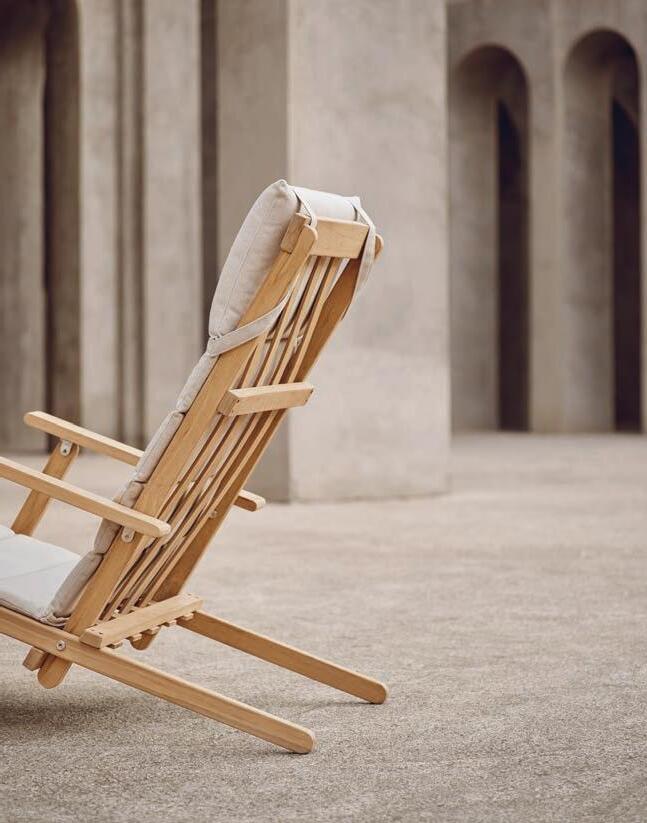
Like all of Børge Mogensen’s furniture designs, the Outdoor Series combines functional strength with natural materials and a timeless aesthetic. Featuring a number of carefully crafted details that point to Mogensen’s background as a cabinetmaker, the Outdoor Series features clear stylistic references to the American Shakers and to 19th Century English furniture design.
The Outdoor Series is made from solid, FSC™certi ed teak. The series consists of a deck chair with cushion and footstool, a side table, a tray, a dining table with matching chairs, a table and bench set, and a matching wall mount. The cushion for the deck chair, the seat of the chair, and the footstool are upholstered with Sunbrella performance fabrics.

126 Børge Mogensen 1968-1971
TOP: BM5568 DECK CHAIR: Frame: Teak. Cushions: Heritage Papyrus 18006 fabric
BOTTOM: BM1771 TABLE, BM1871 BENCH: Frame: Teak.
Cushions: Heritage Papyrus 18006 fabric
BØRGE MOGENSEN OUTDOOR SERIES
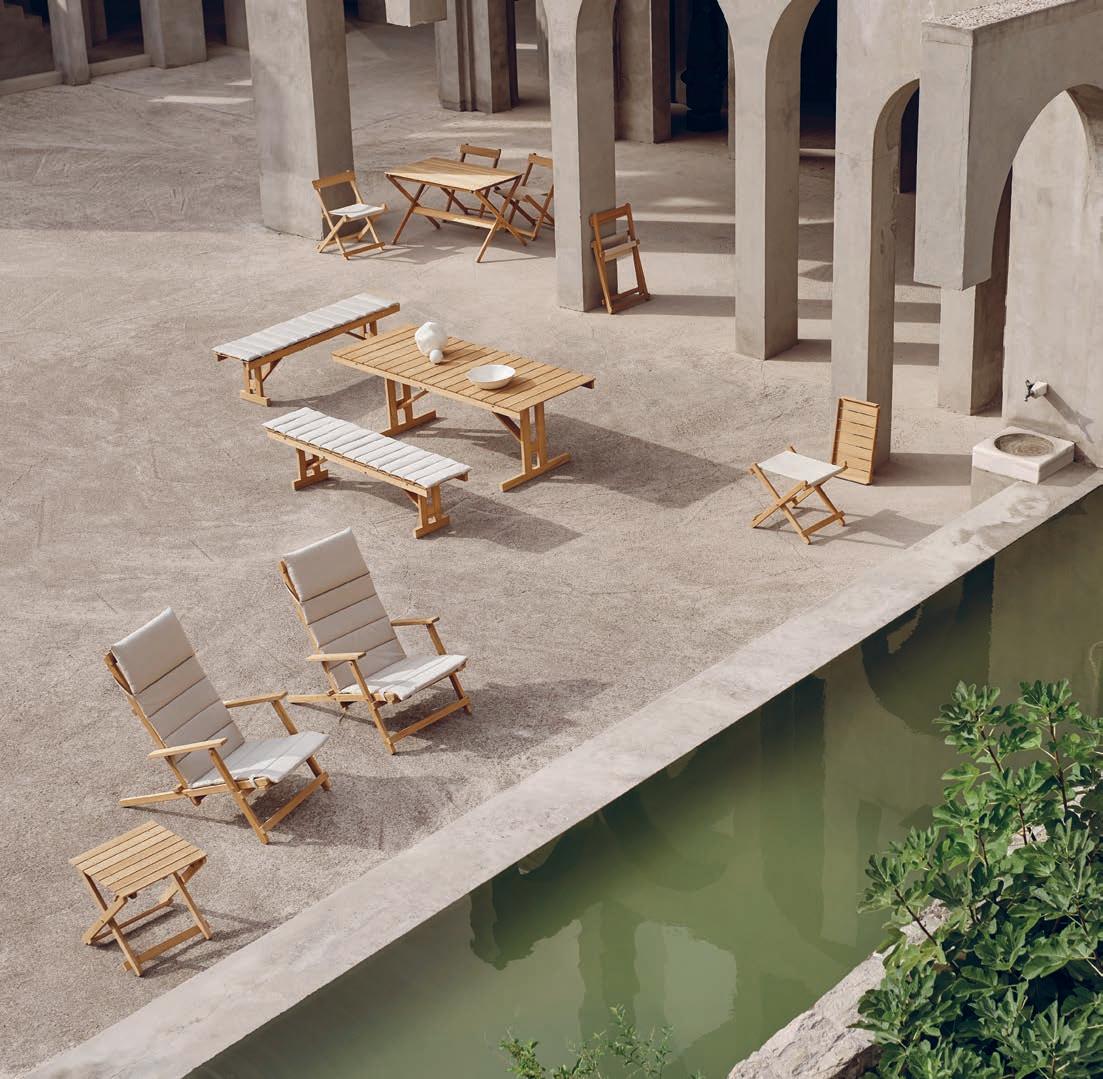
127 Børge Mogensen 1968-1971
BM1771 TABLE, BM1871 BENCH, BM5568 DECK CHAIR, BM5868 SIDE TABLE, BM5768 FOOTSTOOL, BM1069 TRAY, BM4570 CHAIR, BM3670 DINING TABLE: Frame: Teak. Cushions: Heritage Papyrus 18006 fabric
MG501 CUBA OUTDOOR
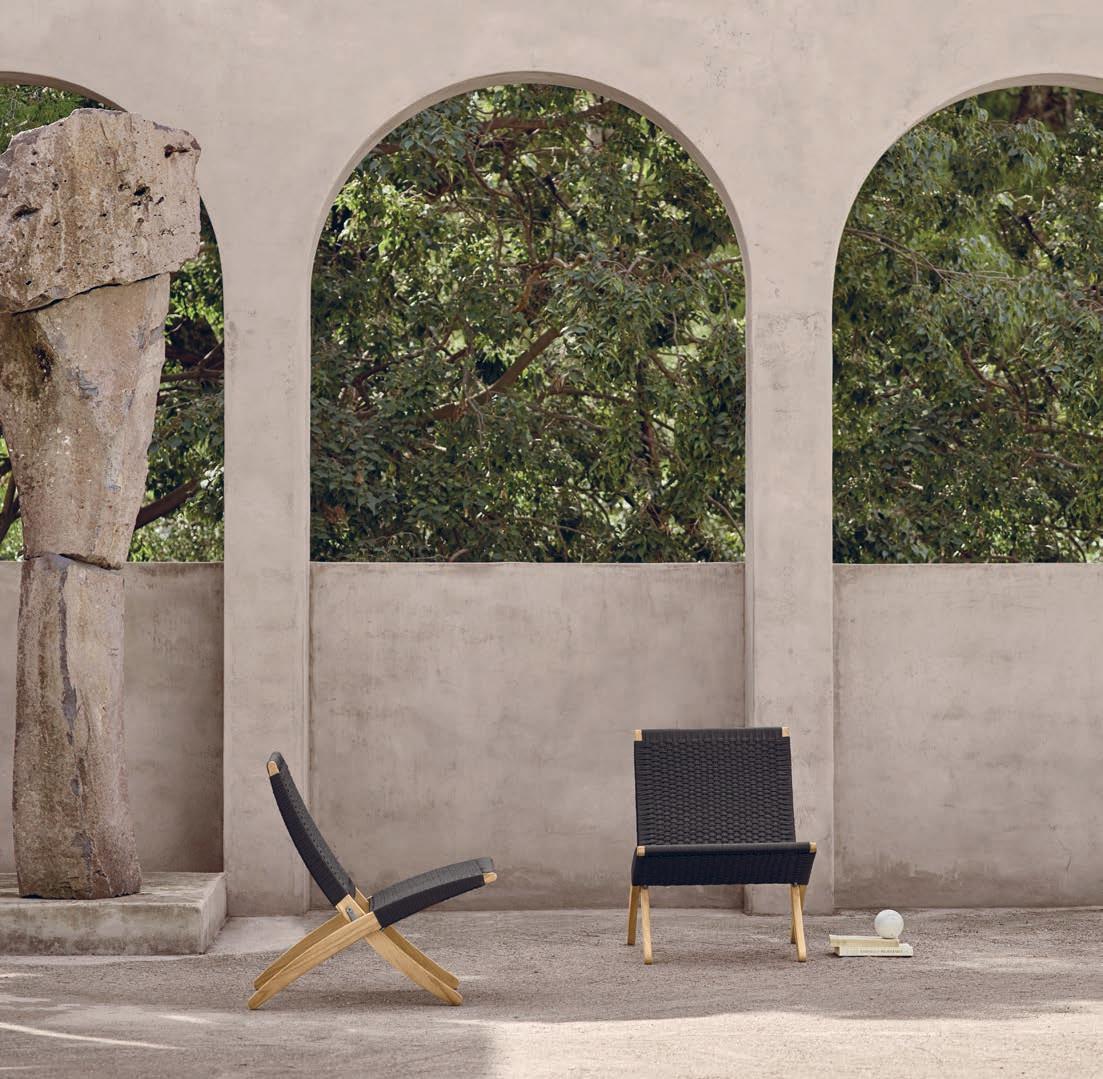
128 Morten Gøttler 1997
MG501 CUBA CHAIR: Frame: Teak, untreated. Seat and back: Flat rope, Charcoal 1402
Designed in 1997, Morten Gøttler’s ingenious Cuba Chair is an excellent example of the designer’s focused approach to furniture design. With its low, open construction, the Cuba Chair encourages an informal sitting position and clearly re ects the democratic ideals of modernist design. In just a few decades, the deceptively simple Cuba Chair has become a new classic of Danish furniture design. While the aesthetic and functional features of this version of the Cuba Chair are
identical to the original, the materials have been updated for outdoor use. This lightweight and highly functional folding chair is a weather-resistant variant ideal for patio, terrace, balcony, and garden spaces.
The outdoor Cuba Chair is made from solid, FSC™certi ed teak, water and light-resistant at-weave rope, and stainless steel ttings that guarantee long-term durability and resistance to wind and weather.

129 Morten Gøttler 1997 MG501 CUBA OUTDOOR
MG501 CUBA CHAIR: Frame: Teak, untreated. Seat and back: Flat rope, Charcoal 1402
Our furniture is crafted into iconic design pieces from materials that are precious natural resources. Residue material is inevitable, but we are committed to using every piece and little scrap to its fullest.
130
FRAMES
COLLECTION 131
In 1948 the Victoria and Albert Museum in London mounted a comprehensive display of ‘Danish Art Treasures through the Ages’ with Kaare Klint as the main exhibition designer.
For this exhibition Klint created a series of sleek wooden frames, which is just as appealing today, as it was more than 70 years ago.

As the son of well-renowned architect Peder Vilhelm Jensen-Klint, Kaare Klint acquired an understanding for





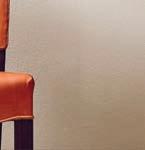

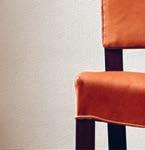

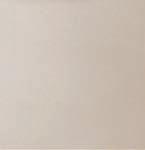








proportions from an early age. Later on, as a furniture designer, he strove to grasp and improve the relationship between human proportions and their surroundings even further. With the frames designed for the exhibition, Klint used standard dimensions to match international formats.


Manufactured in solid oak or teak, the gentle, natural surfaces of the frames contrast their more controlled silhouettes. We o er them with a mirror, a felt board or as a classic frame with a glass front, providing ample opportunity for combining and re ecting images.
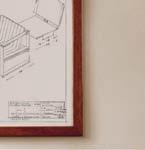


132 Kaare Klint 1948 KAARE KLINT
FRAMES
KAARE KLINT FRAME: Teak, lacquer, glass. KK39490 RED CHAIR: Frame: Walnut, oil. Seat and back: Sif 92 leather
KAARE KLINT FRAMES

133 Kaare Klint 1948
KAARE KLINT FRAMES: Oak, teak, lacquer, glass. KK47000 SAFARI CHAIR: Frame: Ash, white oil. Seat and back: Natural canvas fabric. Details: Nature saddle leather
134
COLLECTION INDEX
ILLUSTRATED GUIDE
A complete overview and useful reference for every piece of Carl Hansen & Søn furniture. Explore details, nd measurements and choose the perfect materials to create the right look, proportion and atmosphere in any space.
All measurements in cm / To explore more about the materials visit carlhansen.com 135
CH23
CHAIRS
Hans J. Wegner 1956 p. 14
Materials Frame: Beech, oak, painted Seat: Leather, fabric
CH24
CH26
CH29P
CH30P
Hans J. Wegner 1950 p. 15 / 63
Materials
Frame: Oak, walnut, oak/walnut, painted Seat: Paper cord
Hans J. Wegner 1950 p. 16 / 63 / 65 / 66 / 108
Materials Frame: Ash, beech, oak, walnut, painted Seat: Paper cord
Hans J. Wegner 1950 p. 17
Materials Frame: Oak, walnut, oak/walnut, painted Seat: Paper cord
Hans J. Wegner 1952 p. 18 / 60
Materials Frame: Beech, oak, painted
Seat: Leather, fabric
Hans J. Wegner 1954 p. 19
Materials Frame: Oak, walnut, painted Seat: Leather, fabric
136
CH20 Elbow Chair
Wishbone Chair
54 47 46 71,5 73 50,5 50,5 1:10 78,6 50,3 44,5 50,3 50,3 1:10 78,6 50,3 44,5 50,3 50,3 44,5 78,5 53 59 55 49 52 51 44 81 44,5 45 70 79 76 53 49 81 44 49 53 49 81 44 49 52 47 46 78 52 cm / 20,5” 52 cm / 20,5” 47 cm / 18,5” 46 cm 18,1” 78 cm 30,7” 47 cm 18,5” 52 cm / 20,5” 52 cm / 20,5” 47 cm / 18,5” 46 cm 18,1” 78 cm 30,7” 47 cm 18,5”
CHAIRS
CH33
Hans J. Wegner 1957 p. 20
Materials
Frame: Oak, walnut, oak/walnut, painted Seat: Wood, leather, fabric CH36
Hans J. Wegner 1962 p. 21
Materials
Frame: Beech, oak Seat: Paper cord
Hans J. Wegner 1962 p. 21
Materials Frame: Beech, oak
Seat: Paper cord
Hans J. Wegner 1966 p. 22
Materials
Oak. painted Seat: Paper cord
Hans J. Wegner 1966 p. 22
Materials
Oak, painted Seat: Paper cord
Hans J. Wegner 1985 p. 23
Materials Frame: Oak, walnut, painted Seat: Leather Details: Stainless steel
137
CH46
CH47
CH37
CH56
Frame:
Frame:
55 48 46 74 74 44 55 48 48 74 44 55 48 48 55 58 50 51 50 51 52 48 81 45 48 52 48 81 45 48 45 44 81 79 69 45 44 68 79 81 55 79 69 44 51 55 79 69 44 51 55 51 79 44 51 55 51 79 44 51 52 48 Ø35 39 76 76 46 39 36 76 46 39 36
CH88
CHAIRS
Hans J. Wegner 1985 p. 23
Materials
Frame: Oak, walnut, painted
Seat: Leather
Details: Stainless steel
Hans J. Wegner 1955 p. 24 / 62 / 64
Materials
Frame: Beech, oak, painted
Seat: Wood, leather, fabric
Hans J. Wegner 1970 p. 61 / 100
Materials
Frame: Stainless steel
Seat: Leather
Børge Mogensen 1950 p. 25 / 68
Materials
Frame: Oak, walnut
Seat: Saddle leather
Details: Brass
EOOS 2019 p. 26 / 69
Materials
Frame: Oak, walnut, painted
Seat: Leather, fabric
EOOS 2015 p. 26 / 69
Materials
Frame: Oak, walnut, painted
Seat: Leather, fabric
138
E005
CH111 BM1106 Huntsman
Chair
E004 Embrace Chair
Embrace Armchair
CH58 57 44,5 45,5 76,5 1:10 76,5 44,5 57 44,5 1:101:10 76,5 44,5 57 44,5 61 67 55 62 45 42,5 64 68 79 84 59 55 46,5 85 85 67 46 59 55 52 85 67 46 59 55 52 Ø35 68 68 46 36 36 68 46 36 36 56 61 46,5 82,5 56 cm / 22” 56 cm / 22” 61 cm / 24” 46,5 cm 18,3” 61 cm 24” 82,5 cm 32,5” 56 cm / 22” 56 cm / 22” 61 cm / 24” 46,5 cm 18,3” 61 cm 24” 82,5 cm 32,5” 67 cm / 26,4” 67 cm / 26,4” 62 cm / 24,4” 42,5 cm / 16,7” 68 cm / 26,8” 84 cm / 32,7” 62 cm 24,4” 67 cm / 26,4” 67 cm / 26,4” 62 cm / 24,4” 42,5 cm / 16,7” 68 cm / 26,8” 84 cm / 32,7” 62 cm 24,4” 39
CHAIRS
E006 Embrace Bar Stool
E007 Embrace Bar Stool
KK39490 Red Chair Small
KK47510 Red Chair Medium
KK37580 Red Chair Large
EOOS 2021 p. 27
Materials
Frame: Oak, walnut, painted
Seat: Leather, fabric
Details: Powder coated steel
EOOS 2021 p. 27
Materials
Frame: Oak, walnut, painted
Seat: Leather, fabric
Details: Powder coated steel
Kaare Klint 1928 p. 31 / 71 / 132
Oak, walnut Seat: Leather
Kaare Klint 1933 p. 31 / 71
Leather
Kaare Klint 1927 p. 31 / 71
Leather
139
Frame:
Materials Frame:
Seat:
Materials Frame:
Seat:
KK37581 Red Armchair Large Kaare Klint 1930 p. 31 Materials Frame: Oak, walnut Seat: Leather 49 49 54,5 52,5 29,5 21,5 78,5 105 70,5 97 48 53 58 49 52 55 46 46 46 85 85 88 49 cm / 19,3” 54,5 cm / 21,5” 49 cm / 19,3” 78,5 cm 31” 29,5 cm 11,6” 105 cm 41,3” 54,5 cm 21,5” 49 cm / 19,3” 54,5 cm / 21,5” 49 cm / 19,3” 78,5 cm 31” 29,5 cm 11,6” 105 cm 41,3” 54,5 cm 21,5” 49 cm / 19,3” 52,5 cm / 20,7” 49 cm / 19,3” 70,5 cm 27,8” 21,5 cm 8,5” 97 cm 38” 52,5 cm 20,7” 49 cm / 19,3” 52,5 cm / 20,7” 49 cm / 19,3” 70,5 cm 27,8” 21,5 cm 8,5” 97 cm 38” 52,5 cm 20,7” 48 cm / 18,8” 46 cm 18,1” 85 cm 33,4” 49 cm / 19,6” 48 cm / 18,8” 49 cm 19,6” 48 cm / 18,8” 46 cm 18,1” 85 cm 33,4” 49 cm / 19,6” 48 cm / 18,8” 49 cm 19,6” 53 cm / 20,8” 46 cm 18,1” 85 cm 33,4” 52 cm / 20,4” 53 cm / 20,8” 52 cm 20,4” 53 cm / 20,8” 46 cm 18,1” 85 cm 33,4” 52 cm / 20,4” 53 cm / 20,8” 52 cm 20,4” 46 cm 18,1” 88 cm 34,6” 55 cm 21,6” 58 cm / 22,8” 55 cm / 21,6” 58 cm / 22,8” 46 cm 18,1” 88 cm 34,6” 55 cm 21,6” 58 cm / 22,8” 55 cm / 21,6” 58 cm / 22,8” 58 55 46,5 88 70 58 cm / 22,8” 46 cm 18,1” 88 cm 34,6” 70 cm 27,6” 55 cm / 21,6” 58 cm / 22,8” 55 cm 21,6” 58 cm / 22,8” 46 cm 18,1” 88 cm 34,6” 70 cm 27,6” 55 cm / 21,6” 58 cm / 22,8” 55 cm 21,6”
Materials
Oak, walnut
Oak, walnut
CHAIRS
Kaare Klint 1914 p. 28
Materials
Frame: Oak, mahogany, walnut
Seat: Leather
Ejner Larsen & Aksel Bender Madsen 1949 p. 29
Materials
Frame: Oak, walnut
Seat: Wood, saddle leather
Ole Wanscher 1958 p. 30
Materials
Frame: Oak, walnut, painted
Seat: Leather, fabric
140
KK96620 Faaborg Chair
LM92T Metropolitan Chair
OW58 T-Chair
70 55 77,5 56 42,5 79,5 68 44 73 46 82 48 50 70 cm / 27,5” 70 cm / 27,5” 55 cm / 21,6” 44 cm 17,3” 73 cm 28,7” 55 cm 21,6” 70 cm / 27,5” 70 cm / 27,5” 55 cm / 21,6” 44 cm 17,3” 73 cm 28,7” 55 cm 21,6” 76 cm / 29,9” 76 cm / 29,9” 56 cm / 22” 56 cm 22” 68 cm 26,8” 42,5 cm / 16,7” 78 cm / 30,7” 76 cm / 29,9” 76 cm / 29,9” 56 cm / 22” 56 cm 22” 68 cm 26,8” 42,5 cm / 16,7” 78 cm / 30,7” 48 cm / 18,9” 48 cm / 18,9” 50 cm / 19,7” 50 cm 19,7” 82 cm 32,3” 46 cm 18,1” 48 cm / 18,9” 48 cm / 18,9” 50 cm / 19,7” 50 cm 19,7” 82 cm 32,3” 46 cm 18,1”
LOUNGE CHAIRS
Hans J. Wegner 1963 p. 34
Materials
Frame: Beech, oak, walnut, painted
Seat: Leather, fabric
Hans J. Wegner 1950 p. 35
Materials
Frame: Oak, walnut, oak/walnut, painted
Seat: Paper cord
Hans J. Wegner 1950 p. 36
Materials
Frame: Oak, walnut, painted
Seat: Paper cord
Hans J. Wegner 1952 p. 37
Materials
Frame: Oak, walnut, oak/walnut
Seat: Wood, leather
Hans J. Wegner 1965 p. 38
Materials
Oak, painted
Leather, fabric
Hans J. Wegner 1952 p. 39
Materials Frame: Oak, walnut, painted
Fabric
141
CH28 CH22 CH07 Shell Chair CH25 CH44 73 69,5 92 71 67 61,5 83 73 37 37 77 72,5 35 35 74 73 83 92 83 35 74 48 83 92 83 35 74 48 71 73 55 35 73 71 73 55 35 73 73 77 61 37 67 6773 77 61 37 67 67 64 66 39 80 64 66 80 62 39 66 64 66 80 62 39 66 CH71
Frame:
Seat:
84 cm 33,1” 70 cm 27,6” 70 cm 27,6” 62 cm 24,4” 41 cm 16,1” CH 71 84 cm 33,1” 70 cm 27,6” 70 cm 27,6” 62 cm 24,4” 41 cm 16,1” CH 71 70 70 41 84
Seat:
LOUNGE CHAIRS
Hans J. Wegner 1954 p. 40 / 41 / 98 / 102
Materials
Frame: Oak, walnut, painted
Seat: Leather, fabric
Hans J. Wegner 1960
Hans J. Wegner 1960 p. 43
Materials
Frame: Stainless steel
Seat: Leather, fabric
Anker Bak 2017 p. 44
Materials
Frame: Oak
Seat: Leather, canvas
Details: Stainless steel
EOOS 2016 p. 45
Materials
Frame: Oak, walnut, painted
Seat: Leather, fabric
Frits Henningsen 1930 p. 46
Materials Frame: Oak, walnut, painted Seat: Leather, fabric
142
FH419 Heritage Chair
EO15 Embrace Lounge Chair
AB001 Rocking Nest Chair
CH78 Mama Bear Chair
CH468 Oculus Chair
76 75 95 80 41 102 94 94 40 105 40 60 85 79,2 cm 31,2” 75,1 cm 29,6” 85,0 cm 33,5” 79,2 cm 31,2” 1:10 39,9 cm 15,7” 62,0 cm 24,4” 79,2 cm 31,2” 75,1 cm 29,6” 85,0 cm 33,5” 79,2 cm 31,2” 1:10 39,9 cm 15,7” 62,0 cm 24,4” 76 102 60 41 95 76 102 60 41 95 94 94 105 65 40 94 94 94 105 65 40 94 62 84 78 80 45 40 62,5 81 106 84 cm / 33,1” 40 cm 15,7” 62,5 cm 24,6” 106 cm 41,7” 80 cm 31,5” 84 cm / 33,1” 80 cm / 31,5” 84 cm / 33,1” 40 cm 15,7” 62,5 cm 24,6” 106 cm 41,7” 80 cm 31,5” 84 cm / 33,1” 80 cm / 31,5” 62 cm / 24,4” 78 cm / 30,7” 62 cm / 24,4” 45 cm 17,7” 81 cm 31,8” 78 cm 30,7” 62 cm / 24,4” 78 cm / 30,7” 62 cm / 24,4” 45 cm 17,7” 81 cm 31,8” 78 cm 30,7”
p. 42 Materials Frame: Stainless steel Seat: Leather, fabric CH445 Wing Chair 90 90 39 103 90 90 103 62 39 90 90 103 62 39
FH429 Signature Chair
LOUNGE CHAIRS
Frits Henningsen 1954 p. 47
Materials
Frame: Oak, walnut, painted
Seat: Leather, fabric
Kaare Klint 1933 p. 50 / 121 / 133
Materials
Frame: Ash, painted Seat: Leather, fabric Details: Leather
Kaare Klint 1937 p. 51
Materials
Oak, walnut
Leather
143
KK47000
Safari Chair KK53130 Easy Chair
KK43960 Mix Chair Kaare
Materials Frame: Oak, walnut Seat: Leather 67 89 41 102 1:10 66 89 101 40 89 1:10 66 89 101 40 89 57 57 34 80 65 80 44 78 65 cm / 25,5” 65 cm / 25,5” 44 cm 17,3” 78 cm 30,7” 66 cm 26” 80 cm 31,4” 80 cm / 31,4” 65 cm / 25,5” 65 cm / 25,5” 44 cm 17,3” 78 cm 30,7” 66 cm 26” 80 cm 31,4” 80 cm / 31,4” 69 72 44 80 61 69 cm / 27,2” 69 cm / 27,2” 72 cm / 28,3” 44 cm 17,3” 61 cm 24” 80 cm 31,5” 72 cm 28,3” 69 cm / 27,2” 69 cm / 27,2” 72 cm / 28,3” 44 cm 17,3” 61 cm 24” 80 cm 31,5” 72 cm 28,3” FK10 Plico Chair FK11 Plico Chair Fabricius & Kastholm 1963 p. 48 Fabricius & Kastholm 1963 p. 48 Materials Frame: Oak Seat: Fabric Details: Leather, brass Materials Frame: Oak Seat: Fabric Details: Leather, brass 85 85 74 74 20 37 93,5 20 74 37 85 cm / 33,5” 74 cm / 29,1” 74 cm / 29,1” 37 cm 14,6” 93,5 cm 36,8” 20 cm 7,9” 85 cm / 33,5” 74 cm / 29,1” 74 cm / 29,1” 37 cm 14,6” 74 cm 29,1” 20 cm 7,9” 85 cm / 33,5” 74 cm / 29,1” 74 cm / 29,1” 37 cm 14,6” 74 cm 29,1” 20 cm 7,9” 85 cm / 33,5” 74 cm / 29,1” 74 cm / 29,1” 37 cm 14,6” 93,5 cm 36,8” 20 cm 7,9”
Frame:
Seat:
Klint 1931 p. 49
LOUNGE CHAIRS
Morten Gøttler 1997 p. 53
Materials
Frame: Oak, painted
Seat: Cotton webbing, paper cord
Ole Wanscher 1951 p. 54
Materials
Frame: Oak, walnut, painted Seat: Leather
Ole Wanscher 1959 p. 55 / 111
Materials
Frame: Oak, walnut, painted
Seat: Leather, fabric
Tadao Ando 2013 p. 57
Materials
Frame: Walnut Seat: Leather
144
OW149 Colonial Chair
TA001P Dream Chair
65 69 46 85 1:10 65 68 85 xx 46 68 1:10 65 68 85 xx 46 68 80 86 36 100 86 cm / 33,9” 100 cm 39,3” 86 cm 33,9” 80 cm / 31,5” 80 cm / 31,5” 36 cm 14,2” 86 cm / 33,9” 100 cm 39,3” 86 cm 33,9” 80 cm / 31,5” 80 cm / 31,5” 36 cm 14,2”
OW124 Beak Chair
MG501 Cuba Chair
65 74 40 79 65 73 79 40 65 73 79 40 61 79 39 76 76 39 79 61 79 76 39 79 61 79
CH53
CH446 Footstool
EO16 Embrace Footstool
FH420 Heritage Footstool
FH430 Signature Footstool
KK87830 Propeller Stool
Hans J. Wegner 1965 p. 21 / 38 / 43
Materials
Frame: Beech, oak, painted
Seat: Paper cord
Hans J. Wegner 1960 p. 42
Materials
Frame: Stainless steel
Seat: Leather, fabric
EOOS 2016 p. 45
Materials
Frame: Oak, walnut, painted
Seat: Leather, fabric
Frits Henningsen 1930 p. 46
Materials
Frame: Oak, walnut, painted
Seat: Leather, fabric
Frits Henningsen 1954 p. 47
Materials
Frame: Oak, walnut, painted
Seat: Leather, fabric
Kaare Klint 1930 p. 51 / 52 / 82
Materials
Frame: Ash, oak, painted
Seat: Leather, fabric
Tray available
145
FOOTSTOOLS
50 68,5 38 38 44 / 48 41 39 / 41 43 / 45 39 50 39 / 41 43 / 45 39 50 38,0 cm 15,0” 68,5 cm 27,0” 40,8 cm 16,1” 38,0 cm 15,0” 1:10 38,0 cm 15,0” 68,5 cm 27,0” 40,8 cm 16,1” 38,0 cm 15,0” 1:10 62,5 49 37,5 1:10 1:10 52 59 42 55 37 40 1:10 40,2 cm 15.8” 54,9 cm 21.6” 58,8 cm 23.1” 47,5 cm 18.7” 42,4 cm 16.7” 40,2 cm 15.8” 54,9 cm 21.6” 58,8 cm 23.1” 47,5 cm 18.7” 42,4 cm 16.7” 1:10 54 49 45 54 cm / 21,3” 54 cm / 21,3” 49 cm / 19,3” 45 cm 15,9” 49 cm 19,3” 54 cm / 21,3” 54 cm / 21,3” 49 cm / 19,3” 45 cm 15,9” 49 cm 19,3”
FOOTSTOOLS
KK97170 Safari Footstool Esben Klint 1966 p. 50
Materials
Frame: Ash, painted
Seat: Leather, fabric
Details: Leather
OW149F Colonial Footstool
OW2000 Egyptian Stool
Ole Wanscher 1959 p. 55
Materials
Frame: Oak, walnut, painted
Seat: Leather, fabric
Ole Wanscher 1957 p. 56
Materials
Frame: Oak, painted
Seat: Leather
146
57 57 34 60 32,5 40 55 46 37,5 40 46 60 40 40 46 60 40 1:10 41 55 30 55 1:10 41 55 30 55
DINING TABLES AND DESKS
CH002
CH006
Hans J. Wegner 1982 p. 18 / 60
Materials
Table top and legs: Beech, oak
Hans J. Wegner 1982 p. 60
Materials
Table top and legs: Beech, oak
Hans J. Wegner 1970 p. 61
Materials
Table top: Oak, walnut
Legs: Stainless steel
CH322
Hans J. Wegner 1960 p. 62
Materials
Table top: Oak
Legs: Stainless steel Table leaves: Oak, MDF
Hans J. Wegner 1962 p. 19 / 63
Materials
Table top and legs: Beech, oak, walnut oak/walnut Table leaves: MDF
Hans J. Wegner 1962 p. 17 / 21 / 64 / 65
Materials
Table top and legs: Beech, oak, walnut Table leaves: Beech, oak, walnut, MDF
147
CH327 CH337 CH110 90 49 72 90 90 138 49 72 190 95 71 160 95 72 160 95 72 60 95 160 95 72 60 95 190 / 248 95 72 190 / 248 95 72 95 190 / 248 95 72 95 115 140 60 72 115 140 115 72 140 115 72 60 95 160 95 72 60 95 160 95 72 60 95 40 95 190 / 248 95 72 95
DINING TABLES AND DESKS
Hans J. Wegner 1962 p. 16 / 24 / 64 / 65
Materials
Table top and legs: Beech, oak, walnut
Table leaves: Beech, oak, walnut, MDF
Hans J. Wegner 1962 p. 64 / 65
Materials
Table top and legs: Beech, oak, walnut
Table leaves: Beech, oak, walnut, MDF
Hans J. Wegner 1960 p. 66
Materials
Table top: Oak
Legs: Stainless steel
Table leaves: Oak, MDF
Arne Jacobsen 1952 p. 67
Materials
Table top: Oak/leather, walnut/leather
Legs: Stainless steel Lamp available
Børge Mogensen 1950 p. 25 / 30 / 68
Materials
Table top and legs: Oak, walnut, oak/walnut
Details: Brass, stainless steel
EOOS 2019 p. 26 / 69
Materials
Table top: Laminated wood, oak, walnut
Legs: Oak, walnut
Details: Stainless steel, powder coated steel
148
CH339 CH388 E20 Embrace Table BM1160 Hunting Table AJ52 Society Table
CH338 200 72 115 200 115 60 72 115 200 115 60 72 115 115 60 160 95 72 60 95 60 60 50 115 120 160 95 72 60 95 160 95 72 60 95 240 72 115 240 115 60 72 115 240 115 60 72 115 120 120 120 60 120 72 120 120 120 60 120 72 72 140 / 160 70 72 140 cm/160 cm 55”/63” 130 cm 51” 72 cm 28” 65 cm 25,6” 70 cm 27 ,5” 50 cm 19,7” 23 cm 9” 1:10 140 cm/160 cm 55”/63” 130 cm 51” 72 cm 28” 65 cm 25,6” 70 cm 27 ,5” 50 cm 19,7” 23 cm 9” 1:10 140 cm/160 cm 55”/63” 130 cm 51” 72 cm 28” 65 cm 25,6” 70 cm 27 ,5” 50 cm 19,7” 23 cm 9” 1:10 58 210 1:10 81,5 cm 210 cm 72 cm 2,8 cm 1,1” 32,1” 82,7” 28,3” 82 72 1:10 81,5 cm 210 cm 72 cm 2,8 cm 1,1” 32,1” 82,7” 28,3” 79,5 / 110 / 139,5 79,5 / 110 / 139,5 74 74 cm 29,1” 110 cm / 43,3” 110 cm / 43,3” 110 cm / 43,3” 74 cm 29,1” 110 cm / 43,3” 110 cm / 43,3” 110 cm / 43,3”
DINING TABLES AND DESKS
PK52 Professor Desk Poul Kjærholm 1955 p. 70
Materials
Table top: Laminate, oak, painted Legs: Powder coated steel
Poul Kjærholm 1955 p. 70
Materials
Table top: Laminate, oak, painted Legs: Powder coated steel
SH900 Extend Table Christina Strand and Niels Hvass 1998 p. 31 / 71
Materials
Table top and legs: Oak Table leaves: Honey comb
149
PK52A
Desk 141,5 85 72 85 141,5 85 72 85 141,5 85 72 85 186,5 72 190 110 100 100 72 300 190 72 100 100 72 300 190 72 100 72
Student
J. Wegner 1952 p. 74
Hans J. Wegner 1970 p. 75
Materials Frame: Stainless steel
Leather
Hans J. Wegner 1970 p. 75
Materials Frame: Stainless steel Seat: Leather
Hans J. Wegner 1970 p. 75
Materials Frame: Stainless steel Seat: Leather
Hans J. Wegner 1970 p. 75
Stainless steel
Leather
Hans J. Wegner 1965 p. 76
Materials Frame: Oak, walnut, painted
Seat: Leather, fabric
150 SOFAS CH101 CH102 CH103 CH104 CH162
Frame:
Seat:
CH72
Materials Frame: Oak, walnut, painted Seat: Fabric 78 152 219 286 43 43 43 43 71 71 71 71 61 61 61 61 77 77 77 77 1:10 43 61 71 77 77 78 1:10 43 61 71 77 77 78 1:10 43 61 71 77 77 78 1:10 43 61 71 77 77 78 1:10 43 61 71 77 77 78 1:10 43 61 71 77 77 150 1:10 43 61 71 77 77 150 1:10 43 61 71 77 77 286 137 41 76 68 77 41 68 76 80 137 41 68 76 80 137 130 41 84 72 CH72 72 cm 28,3” 62 cm 24,4” 41 cm 16,1” 84 cm 33,1” 130 cm 51,2” CH72 72 cm 28,3” 62 cm 24,4” 41 cm 16,1” 84 cm 33,1” 130 cm 51,2”
Seat:
Materials
Hans
CH163
CH401 Kastrup Series
CH402 Kastrup Series
CH403 Kastrup Series
CH404 Kastrup Series
E300 Embrace Sofa
Hans J. Wegner 1965 p. 76
Materials
Frame: Oak, walnut, painted
Seat: Leather, fabric
Hans J. Wegner 1958/1993 p. 77
Materials
Frame: Stainless steel
Seat: Leather, fabric
Hans J. Wegner 1958/1993 p. 77
Materials Stainless steel Frame: Stainless steel
Seat: Leather, fabric
Hans J. Wegner 1958/1993 p. 77
Materials Frame: Stainless steel
Seat: Leather, fabric
Hans J. Wegner 1958/1993 p. 77
Materials
Frame: Stainless steel
Seat: Leather, fabric
EOOS 2021 p. 78 / 79 / 103
Materials
Frame: Oak
Seat: Leather, fabric
See all sofa modules at carlhansen.com
151
SOFAS
195 41 76 68 77 195 80 76 68 41 41 68 76 80 137 60 124 189 254 40 45 76 85 68 68 60 68 75 44 60 68 75 44 124 68 44 85 68 189 68 44 85 68 45 85 68 189 68 44 85 68 45 85 68 189 68 44 85 68 189 68 44 85 68 254 68 45 83 68 88 70 44 82 88 88 cm / 34,6” 88 cm / 34,6” 88 cm / 34,6” 82 cm 32,3” 44 cm 17,3” 70 cm 27,5” 88 cm / 34,6” 88 cm / 34,6” 88 cm / 34,6” 82 cm 32,3” 44 cm 17,3” 70 cm 27,5”
E300 Embrace Sofa
E300 Embrace Sofa
E300 Embrace Sofa
FH436 Coupé Sofa
KK41180 Sofa With High Sides
EOOS 2021 p. 78 / 79 / 103
Materials
Frame: Oak
Seat: Leather, fabric
See all sofa modules at carlhansen.com
EOOS 2021 p. 78 / 79 / 103
Materials
Frame: Oak
Seat: Leather, fabric
See all sofa modules at carlhansen.com
EOOS 2021 p. 78 / 79 / 103
Materials
Frame: Oak
Seat: Leather, fabric
See all sofa modules at carlhansen.com
Frits Henningsen 1936 p. 80
Materials
Frame: Oak, walnut, painted
Seat: Leather, fabric
Kaare Klint 1930 p. 81
Materials
Frame: Oak, walnut
Seat: Leather
Kaare Klint 1930 p. 81
Materials Frame: Oak, walnut
Seat: Leather
152 SOFAS 149 42 40 62 86 64
200 40 86 80
Sofa With High Sides
KK41181
134 100 80 149 cm / 58,7” 149 cm / 58,7” 64 cm / 25,2” 42 cm 16,5” 62 cm 24,4” 100 cm 39,4” 64 cm 25,2” 149 cm / 58,7” 149 cm / 58,7” 64 cm / 25,2” 42 cm 16,5” 62 cm 24,4” 100 cm 39,4” 64 cm 25,2” 134 cm / 52,8” 134 cm / 52,8” 80 cm / 31,5” 40 cm 15,7” 86 cm 33,9” 80 cm 31,5” 134 cm / 52,8” 134 cm / 52,8” 80 cm / 31,5” 40 cm 15,7” 86 cm 33,9” 80 cm 31,5” 200 cm / 78,7” 200 cm / 78,7” 80 cm / 31,5” 40 cm 15,7” 86 cm 33,9” 80 cm 31,5” 200 cm / 78,7” 200 cm / 78,7” 80 cm / 31,5” 40 cm 15,7” 86 cm 33,9” 80 cm 31,5” 88 44 70 82 88 88 cm / 34,6” 88 cm / 34,6” 82 cm 32,3” 44 cm 17,3” 88 cm / 34,6” 88 cm / 34,6” 88 cm / 34,6” 82 cm 32,3” 44 cm 17,3” 70 cm 27,5” 105 44 70 52 82 90 105 cm / 41,3” 90 cm / 35,4” 82 cm 32,3” 44 cm 17,3” 105 cm / 41,3” 90 cm / 35,4” 105 cm / 41,3” 82 cm 32,3” 44 cm 17,3” 70 cm 27,5” 52 cm 20,5” 115 44 70 82 28 88 115 cm / 45,3” 88 cm / 34,6” 82 cm 32,3” 28 cm 11” 115 cm / 45,3” 88 cm / 34,6” 115 cm / 45,3” 82 cm 32,3” 28 cm 11” 44 cm 17,3” 70 cm 27,5”
SOFAS
KK48650 Addition Sofa
92
KK48651 Addition Sofa
79 cm 31,1”
Kaare Klint 1933 p. 82 / 104 Materials
Oak, walnut
37 cm 14,6”
37 cm 14,6”
Seat: Leather
70 cm 27,6”
79 70 92 cm / 36,2” 92 cm / 36,2” 70 cm / 27,6”
79 cm 31,1” 92 cm / 36,2” 92 cm / 36,2” 70 cm / 27,6”
70 cm 27,6”
37
Kaare Klint 1933 p. 82
Oak, walnut
92 cm / 36,2” 92 cm / 36,2” 61,5 cm / 24,2”
34,5 cm 13,6” 92
34,5 cm 13,6” 92 cm / 36,2” 92 cm / 36,2” 61,5 cm / 24,2”
Seat: Leather
61,5 cm 24,2”
61,5 cm 24,2”
Leather, fabric 124
85 69
Ole Wanscher 1960 p. 84 Ole Wanscher 1960 p. 84 45
Leather, fabric 45
Ole Wanscher 1964 p. 83 / 105 Rikke Frost 2020 p. 85 80 76 214
fabric 80 76
VENSTRE VENDT 74 cm 29,1”
74 cm 29,1”
74 cm 29,1”
104 cm 40,9”
VENSTRE VENDT 74 cm 29,1”
41 cm 16,1”
Fabric 46
74 104 197 cm / 77,6” 197 cm / 77,6” 104 cm / 40,9”
41 cm 16,1”
34,5 61,5 197
104 cm 40,9” 197 cm / 77,6” 197 cm / 77,6” 104 cm / 40,9”
41
153
Frame:
Materials Frame:
OW603
RF1903 Sideways Sofa OW602
Materials Frame: Oak Seat:
Materials Frame: Oak Seat: Leather,
Materials Frame: Oak, walnut Seat:
Materials Frame: Oak, walnut, paper cord Seat:
OW149-2 Colonial Sofa 154
DAYBEDS
Børge Mogensen 1958 p. 67 / 88 / 89 / 118
Oak
Fabric
Frame: Oak Seat: Leather, fabric
Ole Wanscher 1963 p. 90 Thomas Bo Kastholm 2009 p. 91
Frame: Oak, walnut, stainless steel Seat: Leather
154
OW150 TK8 BM0865 180 190 70 46 34,5 20 38 79 70 90 140 70 cm / 27,6” 140 cm / 55,2” 140 cm / 55,2” 10 cm / 3,9” 20 cm / 7,8” 48 cm / 18,9” 41 cm 16,2” 38 cm 14,9” 20 cm 7,9” 70 cm 27,6” 79 cm 16,2” 15 cm 5,9” 70 cm / 27,6” 140 cm 55,2” 140 cm / 55,2” 10 cm / 3,9” 20 cm / 7,8” 48 cm / 18,9” 41 cm 16,2” 38 cm 14,9” 20 cm 7,9” 70 cm 27,6” 79 cm 16,2” 15 cm 5,9” 90 cm / 35,4” 190 cm / 74,8” 190 cm / 74,8” 90 cm 35,4” 34,5 cm 13,5” 90 cm / 35,4” 190 cm / 74,8” 190 cm / 74,8” 90 cm 35,4” 34,5 cm 13,5” 210 cm / 82,7” 23,6” 210 cm 82,7” 46,5 cm 18,3” 40,5 cm 16” 22,5 cm 8,86” 87,5 cm 34,5” 14,5 cm 5,7”
Materials Frame:
Seat:
Materials
Materials
BEDS
Børge Mogensens Tegnestue 1958/2021 p. 92 / 93
Frame: Oak Upholstery: Fabric
Details: Leather
See all options at carlhansen.com Materials Frame: Oak Upholstery: Fabric Details: Leather
Børge Mogensens Tegnestue 1958/2021 p. 92 / 93
See all options at carlhansen.com
Børge Mogensens Tegnestue 1958/2021 p. 92 / 93
Materials
Frame: Oak Upholstery: Fabric Details: Leather
See all options at carlhansen.com
Børge Mogensens Tegnestue 1958/2021 p. 92 / 93
Materials Frame: Oak
Fabric Details: Leather
See all options at carlhansen.com
155
BM0555 Bed BM0555 Bed BM0555 Bed BM0555 Bed 180 160 210 90 22,5 22,5 40,5 40,5 46,6 46,6 87,5 87,5 210 210 160 210 90 cm 35,4” 210 cm 82,7” 60 cm / 23,6” 90 cm / 35,4” 210 cm 82,7” 20 cm 7,87” 10 cm 3,93” 46,5 cm 18,3” 40,5 cm 16” 22,5 cm 8,86” 87,5 cm 34,5” 14,5 cm / 5,7” 90 cm / 35,4” 210 cm 82,7” 60 cm / 23,6” 90 cm / 35,4” 210 cm 82,7” 20 cm 7,87” 10 cm 3,93” 46,5 cm 18,3” 40,5 cm 16” 22,5 cm 8,86” 87,5 cm 34,5” 14,5 cm / 5,7” 210 cm / 82,7” 60 cm / 23,6” 180 cm / 70,9” 210 cm 82,7” 20 cm 7,87” 10 cm 3,93” 46,5 cm 18,3” 40,5 cm 16” 22,5 cm 8,86” 87,5 cm 34,5” 14,5 cm 5,7” 210 cm / 82,7” 60 cm / 23,6” 70,9” 210 cm 82,7” 46,5 cm 18,3” 40,5 cm 16” 22,5 cm 8,86” 87,5 cm 34,5” 14,5 cm / 5,7” 210 cm / 82,7” 60 cm / 23,6” 70,9” 210 cm 82,7” 46,5 cm 18,3” 40,5 cm 16” 22,5 cm 8,86” 87,5 cm 34,5” 14,5 cm / 5,7” 210 cm / 82,7” 57 cm / 22,5” 160 cm / 63” 210 cm 82,7” 20 cm 7,87” 10 cm 3,93” 46,5 cm 18,3” 40,5 cm 16” 22,5 cm 8,86” 87,5 cm 34,5” 14,5 cm / 5,7” 22,5 22,5 40,5 40,5 46,6 46,6 87,5 87,5
Materials
Upholstery:
160 cm / 63” 48 cm / 18,9” 210 cm / 82,7” 160 cm 63” 20 cm 7,87” 10 cm 3,93” 46,5 cm 18,3” 40,5 cm 16” 22,5 cm 8,86” 87,5 cm 34,5” 14,5 cm 5,7” 160 cm 63” 48 cm / 18,9” 160 cm 63” 46,5 cm 18,3” 40,5 cm 16” 22,5 cm 8,86” 87,5 cm 34,5” 14,5 cm / 5,7”
Børge Mogensens 1958 p. 88 / 94 / 95
Frame: Oak
Seat: Cane
Børge Mogensens Tegnestue 2021 p. 48 / 94 / 95
Materials
Frame: Oak
Seat: Cane
156
BM0488S BM0488 138 69 46 46 34,5 34,5 46 cm 18,1” 34,5 cm 13,6” 69 cm / 27,2” 46 cm / 18,1” 69 cm / 27,2” 46 cm 18,1” 34,5 cm 13,6” 69 cm / 27,2” 46 cm / 18,1” 69 cm / 27,2” 46 cm 18,1” 34,5 cm 13,6” 69 cm / 27,2” 46 cm / 18,1” 69 cm / 27,2” 138 cm / 54,3” 46 cm / 18,1” 21 cm / 8,3” 138 cm / 54,3” 46 cm 18,1” 34,5 cm 13,6” Materials
BENCHES
COFFEE TABLES
Hans J. Wegner 1954 p. 42 / 43 / 74 / 98
Materials
Table top and legs: Oak, walnut.
Hans J. Wegner 1954 p. 99
Hans J. Wegner 1970 p. 75 / 100
Materials
Table top: Glass
Legs: Stainless steel
Hans J. Wegner 1970 p. 75 / 100
Materials
Table top: Glass
Legs: Stainless steel
Hans J. Wegner 1990 p. 101
Materials
Table top: Oak, walnut
Legs: Stainless steel
Hans J. Wegner 1966 p. 102
Materials
Table top: Laminate/oak, walnut/oak
Legs: Stainless steel
157
CH008 CH011 CH106 CH108 CH415 CH417 Tray
Table
Ø78 / 88 / 100 Ø78 / 88 / 100 44 / 48 / 53 78 /88 / 100 78 / 88 / 100 44 / 48 / 53 78 /88 / 100 78 / 88 / 100 44 / 48 / 53 130 55 44 / 48 / 53 130 55 44 / 48/ 53 55 130 55 44 / 48/ 53 55 95 95 42 95 95 42 95 95 95 42 95 70 170 42 42 170 70 70 42 170 70 70 Ø55 Ø55 44 1:10 44 55 55 55 1:10 44 55 55 55 33 Ø62 Ø62 Ø62 Ø62 33 Ø62 Ø62 33
painted Materials Table top and legs: Oak
COFFEE TABLES
E021 Embrace Lounge Table EOOS 2019
103 ML10097 Egyptian Table OW449 Colonial Coffee Table
Materials Table top: Oak, walnut, painted Details: Stainless steel, powder coated steel
Mogens Lassen 1940
49 / 104
Materials Table top and legs: Oak, walnut, painted
Ole Wanscher 1964
105
Materials Table top and legs: Oak, walnut, painted
158
p.
p.
p.
Ø85 / 100 60 Ø85 / 100 60 52 46 1:10 46 60 60 60 1:10 46 60 60 60 48 / 38 Ø48 / 80 Ø48 / 80 48 cm / 18,9” 48 cm / 18,9” 48 cm / 18,9” 48 cm 18,9” 48 cm / 18,9” 48 cm / 18,9” 48 cm / 18,9” 48 cm 18,9”
Hans J. Wegner 1959 p. 108
Base: Walnut, oak
Legs: Stainless steel, walnut or oak Materials
Hans J. Wegner 1959 p. 108
Base: Walnut, oak
Legs: Walnut or oak
Børge Mogensen 1953 p. 25 / 68 / 109 / 114
Materials
Base: Walnut, oak, MDF
Legs: Powder coated steel
See all options at carlhansen.com Materials
Børge Mogensen 1953 p. 25 / 68 / 109 / 114
Base: Walnut, oak, MDF
Legs: Powder coated steel
See all options at carlhansen.com
Børge Mogensen 1953 p. 25 / 68 / 109 / 114
Materials
Base: Walnut, oak, MDF
Legs: Powder coated steel
See all options at carlhansen.com
159
BM0253 Shelving System BM0253 Shelving System BM0253 Shelving System CH825 Credenza CH825 Credenza 49 49 200 28 28 81 81 200 52,8 52,8 200,0 49,0 49,0 80,8 80,8 80,8 52,8 52,8 52,8 200,0 49,0 80,8 80,8 80,8 52,8 52,8 52,8 200,0 49,0 49,0 80,8 80,8 80,8 52,8 52,8 52,8 200,0 49,0 49,0 80,8 80,8 80,8 52,8 150 79 150 37 37 129 20 189 20 79 150 37 69 20 150 cm / 59” 150 cm / 59” 37 cm / 14,5” 69 cm 27,2” 45 cm 17,7” 20 cm 7,9” 37 cm 14,5” 150 cm 59” 150 cm 59” 37 cm 14,5” 69 cm 27,2” 45 cm 17,7” 20 cm 7,9” 37 cm 14,5” 37 cm 14,5” 189 cm 74,4” 20 cm 7,9” 25 cm 9,8” 35 cm 13,8” 45 cm 17,7” 37 cm 14,5” 79 cm 31,1” 150 cm 59” 79 cm 31,1” 150 cm / 59” 37 cm 14,5” 189 cm 74,4” 20 cm 7,9” 25 cm 9,8” 35 cm 13,8” 45 cm 17,7” 37 cm 14,5” 79 cm / 31,1” 150 cm 59” 79 cm 31,1” 150 cm / 59” 37 cm / 14,5” 37 cm 14,5” 129 cm 50,8” 25 cm 8,9” 20 cm 7,9” 79 cm / 31,1” 150 cm 59” 79 cm 31,1” 150 cm / 59” 37 cm 14,5” 37 cm 14,5” 129 cm 50,8” 25 cm 8,9” 20 cm 7,9” 79 cm 31,1” 150 cm / 59” 79 cm / 31,1” 150 cm 59” Materials
STORAGE
STORAGE
Preben Fabricius & Jøgen Kastholm 1963 p. 162
Materials Base: Oak
Legs: Black painted steel
See all options at carlhansen.com
Preben Fabricius & Jøgen Kastholm 1963 p. 116 / 158 / 192
Materials
Base: Oak
Legs: Black painted steel
Detail: Brass
See all options at carlhansen.com
160
FK63 FK Bookcase System
FK63 FK Bookcase System
72,5 112 36 112 cm / 44,1” 112 cm / 44,1” 36 cm / 14,2” 72,5 cm 28,5” 36 cm 14,2” 112 cm / 44,1” 112 cm / 44,1” 36 cm / 14,2” 72,5 cm 28,5” 36 cm 14,2” 72,5 112 36 112 cm / 44,1” 112 cm / 44,1” 36 cm / 14,2” 72,5 cm 28,5” 36 cm 14,2” 112 cm / 44,1” 112 cm / 44,1” 36 cm / 14,2” 72,5 cm 28,5” 36 cm 14,2” FK63
Materials Base:
See all options at carlhansen.com 56 112 36 112 cm / 44,1” 112 cm / 44,1” 36 cm / 14,2” 56 cm 22” 36 cm 14,2” 112 cm / 44,1” 112 cm / 44,1” 36 cm / 14,2” 56 cm 22” 36 cm 14,2” Preben Fabricius
Kastholm
p. 107 / 108 / 134 / 154
FK Bookcase System
Oak
& Jøgen
1963
CHILDREN’S FURNITURE
J. Wegner 1944 p. 114
and seat: Beech
J. Wegner 1944 p. 114
Table top and legs: Beech
& Jørgen Ditzel 1954 p. 115
Beech
Saddle leather Baby backrest available
161
CH410 Peter’s Chair CH411 Peter’s Table ND54 High Chair 42 72 32 45 26 47 46 72 45 46 45 72 45 46 45 51 52 53,5 70,5 52 cm 20,5” 51 cm / 20,1” 51 cm / 20,1” 51 cm / 20,1” 52 cm / 20,5” 53,5 cm / 21,1” 70,5 cm / 27,8” 37 cm / 14,6” 30,5 cm / 12” 43,5 cm / 17,1” 52 cm 20,5” 51 cm / 20,1” 51 cm / 20,1” 51 cm / 20,1” 52 cm / 20,5” 53,5 cm / 21,1” 70,5 cm / 27,8” 37 cm / 14,6” 30,5 cm / 43,5 cm / 17,1” Materials Frame
Materials Frame:
Seat:
Materials
Hans
Hans
Nanna
BT1091
BT1001
BT1041
Torsten Thorup & Claus Bonderup 1970 p. 118
Materials
Shade: Powder coated steel or brass
Torsten Thorup & Claus Bonderup 1970 p. 16 / 30 / 108 / 118
Materials
Shade: Powder coated steel or brass
Torsten Thorup & Claus Bonderup 1970 p. 31 / 63 / 118
Materials
Shade: Powder coated steel or brass
Esben Klint 1961 p. 65 / 119
Materials
Shade: Glass Base: Oak
Esben Klint 1961 p. 65 / 119
Materials
Shade: Glass Base: Oak
Esben Klint 1961 p. 65 / 119
Materials
Shade: Glass Base: Oak
162
LIGHTING
Calot
EK61 Opal Pendant
EK61 Opal Pendant
EK61 Opal Pendant
Confetti
Pendant Lamp NO. 1
Ø65 Ø16 Ø24 Ø34 15 16 24 34 Ø14,5 Ø46 13,5 12 Ø46 cm / 18,1” 12 cm 4,6” Ø14,5 cm / 5,7” 13,5 cm 2,3” Ø65 cm / 25,6” 15 cm 5,9” 16 cm 6,29” Ø16 cm / 6,29” 24 cm 9,44” Ø24 cm / 9,44” 34 cm 13,4” Ø34 cm / 13,4”
LIGHTING
Mads Odgård 2020 p. 120
Materials
Shade: Powder coated steel
Mads Odgård 2020 p. 27 / 67 / 103 / 120
Materials
Shade and base: Powder coated steel Materials Shade and base: Powder coated steel
Mads Odgård 2020 p. 48 / 49 / 88 / 120
Mads Odgård 2020 p. 25 / 68 / 118 / 120
Powder coated steel
Rikke Frost 2021 p. 121
Powder coated aluminum, brass
163
MO310 MO320 MO330 RF200 MO300
Materials Shade:
Materials Shade:
Base:
walnut Ø20 Ø26 Ø18 20 39 107 20 51,5 119 32 37,5 25 Ø18 20 31,5 53 65,5 31,5 25 cm / 9,84” Ø20 cm / 7,87” 20 cm / 7,87” 20 cm 7,87” 25 cm / 9,84” Ø20 cm / 7,87” 20 cm / 7,87” 20 cm 7,87” 31,5 cm 12,4” 53 cm 20,9” 11,5 cm 4,5” 45,5 cm 17,9” 20 cm 7,9” Ø18 cm 7,1” Ø18 cm / 7,1” 3 cm 1,2” 31,5 cm 12,4” 53 cm 20,9” 11,5 cm 4,5” 45,5 cm 17,9” 20 cm 7,9” Ø18 cm 7,1” Ø18 cm / 7,1” 3 cm 1,2” 32 cm 12,6” 10 cm 3,9” 39 cm 15,4” 51,5 cm 20,3” Ø18 cm / 7,1” Ø20 cm 7,9” Ø18 cm 7,1” Ø20 cm / 7,9” 32 cm / 12,6” 10 cm 3,9” 39 cm 15,4” 51,5 cm 20,3” Ø18 cm / 7,1” Ø20 cm / 7,9” Ø18 cm / 7,1” Ø20 cm 7,9” 37,5 cm 14,8” 42,1” 46,9” Ø18 cm 7,1” Ø26 cm 10,2” Ø26 cm 10,2” Ø18 cm 7,1” 15 cm 5,9” 37,5 cm 14,8” 42,1” 46,9” Ø18 cm 7,1” Ø26 cm 10,2” Ø26 cm 10,2” Ø18 cm 7,1” 15 cm 5,9” 9 cm 3,5” 45 cm 17,7” Ø18 cm / 7,9” 45 9
Oak,
Bodil Kjær 1959 p. 124 / 125
Materials
Frame and seat: Teak
Bodil Kjær 1959 p. 124 / 125
Materials
Frame and seat: Teak
Bodil Kjær 1959 p. 124
Materials
Frame and seat: Teak
Bodil Kjær 1959
Frame and seat: Teak
Details: Robe
Bodil Kjær 1959
Frame and seat: Teak
Details: Sundrella canvas and robe
Bodil Kjær 1959 p. 124
Materials
Frame: Teak
164 OUTDOOR BK12 Lounge Sofa BK13 Swing Sofa with frame BK13 Swing Sofa BK10 Dining Chair BK11 Lounge Chair BK14 Sunbed 132,5 179 151 39,5 71 54 74,5 193,5 106 72,5 129 66 72,5 cm 28,5” 132,5 cm 52,2” 76 cm 29,9” 66,5 cm 26,2” 44,5 cm 17,5” 5 cm 2” 5 cm 2” 72,5 cm 28,5” 132,5 cm 52,2” 74,5 cm 29,3” 66,5 cm 26,2” 39,5 cm 15,6” 74,5 cm 29,3” 132,5 cm 52,2” 76 cm 30” 132,5 cm 52,2” 193,5 cm 76,1” 179 cm 70,4” 54 cm 21,2” 193,5 cm 76,1” 71 cm 28” 26” 173,5 cm 68,3” 54 cm 21,2” 106 cm 41,7” 54 cm 21,2” 106 cm 41,7” 54 cm 21,2” 59,3” 193,5 cm 76,1” 179 cm 70,4” 54 cm 21,2” 193,5 cm 76,1” 71 cm 28” 129 cm 50,8” 66 cm 26” 173,5 cm 68,3” 66 cm 26” 54 cm 21,2” 106 cm 41,7” 54 cm 21,2” 106 cm 41,7” 54 cm 21,2” 151 cm 59,3” 193,5 cm 76,1” 179 cm 70,4” 54 cm 21,2” 193,5 cm 76,1” 71 cm 28” 129 cm 50,8” 66 cm 26” 173,5 cm 68,3” 66 cm 26” 54 cm 21,2” 106 cm 41,7” 54 cm 21,2” 106 cm 41,7” 54 cm 21,2” 151 cm 59,3” 193,5 cm 76,1” 179 cm 70,4” 54 cm 21,2” 193,5 cm 76,1” 71 cm 28” 26” 173,5 cm 68,3” 54 cm 21,2” 106 cm 41,7” 54 cm 21,2” 106 cm 41,7” 54 cm 21,2” 59,3” 72,5 cm 28,5” 132,5 cm 52,2” 76 cm 29,9” 66,5 cm 26,2” 44,5 cm 17,5” 5 cm 2” 5 cm 2” 72,5 cm 28,5” 132,5 cm 52,2” 74,5 cm 29,3” 66,5 cm 26,2” 39,5 cm 15,6” 74,5 cm 29,3” 132,5 cm 52,2” 76 cm 30” 132,5 cm 52,2” 63,5 70,5 63 72,5 43,5 40 76 74,5 77,5 cm 30,4” 63,5 cm 25” 76 cm 29,9” 65 cm 25,6” 43,5 cm 17,1” 5 cm 2” 5 cm 2” 77,5 cm 30,4” 63,5 cm 25” 63,5 cm 25” 63 cm 24,7” 76 cm 29,9” 65 cm 25,6” 45 cm 17,7” 5 cm 2” 5 cm 2” 76 cm 30” 70,5 cm 27,8” 70,5 cm 27,8” 72,5 cm 28,5” 70,5 cm 27,8” 74,5 cm 29,3” 65 cm 25,6” 40 cm 15,7” 74,5 cm 29,3” 70,5 cm 27,8” 70,5 cm 27,8” 72,5 cm 28,5” 70,5 cm 27,8” 76 cm 29,9” 65 cm 25,6” 45 cm 17,7” 5 cm 2” 5 cm 2” 76 cm 30” 70,5 cm 27,8” 70,5 cm 27,8” 72,5 cm 28,5” 70,5 cm 27,8” 74,5 cm 29,3” 65 cm 25,6” 40 cm 15,7” 74,5 cm 29,3” 70,5 cm 27,8” 70,5 cm 27,8” 72,5 cm 28,5” 70,5 cm 27,8” 76 cm 29,9” 65 cm 25,6” 43,5 cm 17,1” 5 cm 2” 77,5 cm 30,4” 63,5 cm 25” 63 cm 24,7” 76 cm 29,9” 65 cm 25,6” 43,5 cm 17,1” 5 cm 2” 5 cm 2” 77,5 cm 30,4” 63,5 cm 25” 63,5 cm 25” 63 cm 24,7” 205 33,5 70 cm 27,6” cm 27,6” 205 cm 80,7” 33,5 cm 13,2” 70 cm 27,6” 205 cm 80,7” 70 cm 27,6” 33,5 cm 13,2” 205 cm 80,7” 33,5 cm 13,2”
Materials
Materials
Kjær 1959 p. 124 / 125
Kjær 1959 p. 124
Børge Mogensen 1971 p. 126 / 127
Børge Mogensen 1971 p. 126 / 127
and seat: Teak
165 OUTDOOR BK15 Dining Table BM1771 BM5568 Børge Mogensen 1971 p. 126 / 127 BK16 Side Table BM1871 BM5868 Børge Mogensen 1971 p. 127 152,5 152,5 cm 60” 152,5 cm 60” 76 cm 30” 76 cm 30” 74 cm 29,1” 152,5 cm 60” 152,5 cm 60” 76 cm 30” 76 cm 30” 74 cm 29,1” 76 74 69 69 cm 27,2” 66 cm 26” 69 cm 27,2” 66 cm 26” 47 cm 18,5” 69 cm 27,2” 66 cm 26” 69 cm 27,2” 66 cm 26” 47 cm 18,5” 66 47 194,5 60,5 69,5 93,5 72 37 54,5 89 170 45 39 45 44 45 69,5 cm / 27,3” 149 cm / 58,8” 194,5 cm / 76,5” 72 cm 28,3” 64,5 cm 25,4” 78 cm 30,7” 69,5 cm / 27,3” 149 cm / 58,8” 194,5 cm / 76,5” 72 cm 28,3” 64,5 cm 25,4” 78 cm 30,7” 30,5 cm / 12” 132 cm / 51,9” 170 cm / 66,9” 39 cm 15,5” 44 cm 17,5” 30,5 cm / 12” 132 cm / 51,9” 170 cm / 66,9” 39 cm 15,5” 44 cm 17,5” 60,5 cm / 23,8” 60,5 cm / 23,8” 93,5 cm / 36,8” 37 cm 14,5” 89 cm 35,1” 53,5 cm 21” 93,5 cm 26,8” 54,5 cm 21,5” 60,5 cm / 23,8” 60,5 cm / 23,8” 93,5 cm / 36,8” 37 cm 14,5” 89 cm 35,1” 53,5 cm 21” 93,5 cm 26,8” 54,5 cm 21,5” 45 cm / 17,7”45 cm / 17,7” 45 cm / 17,7” 45 cm 17,7” 45 cm 17,7” 45 cm / 17,7”45 cm / 17,7” 45 cm / 17,7” 45 cm 17,7” 45 cm 17,7” Materials Frame and seat: Teak Materials Frame and seat: Teak Materials Table top and legs: Teak Materials Table top and legs: Teak Materials Table top
legs:
Materials Frame
and
Teak
Bodil
Bodil
Børge Mogensen 1968/1970 p. 126
and seat: Teak
Børge Mogensen 1968/1970 p. 127
Teak
Fabric
Mogensen 1968/1970 p. 127
Teak
Fabric
Teak Materials
and seat: Teak
Børge Mogensen 1968/1970 p. 127 Børge Mogensen 1968/1970 p. 127 Børge Mogensen 1968/1970
Teak
166 OUTDOOR BM5565 BM1069 BM3670 BM5768 BM4570 BM5270S 60,5 58 115 93,5 135 34,5 71,5 37 89 54,5 5 65 72 45 50 64 51,5 53 64 47 43,5 72 10 6 135 cm / 53,1” 60,5 cm / 23,8” 60,5 cm / 23,8” 93,5 cm / 36,8” 37 cm 14,5” 54,5 cm 21,5” 89 cm 35,1” 41,5 cm 16,3” 135 cm 53,1” 135 cm / 53,1” 60,5 cm / 23,8” 60,5 cm / 23,8” 93,5 cm / 36,8” 37 cm 14,5” 54,5 cm 21,5” 89 cm 35,1” 41,5 cm 16,3” 135 cm 53,1” 45 cm / 17,7” 45 cm / 17,7” 51,5 cm / 20,3” 47 cm 18,4” 51,5 cm 20,3” 45 cm / 17,7” 45 cm / 17,7” 51,5 cm / 20,3” 47 cm 18,4” 51,5 cm 20,3” 5 cm / 2” 34,5 cm 13,6 34,5 cm / 13,6 58 cm / 22,9 58 cm / 22,9 5 cm / 2” 34,5 cm 13,6 34,5 cm / 13,6 58 cm / 22,9 58 cm / 22,9 50 cm / 19,7” 53 cm / 20,9” 53 cm / 20,9” 53 cm / 20,9” 38,5 cm / 15,2” 72 cm 28,3” 43,5 cm 17,2” 50 cm / 19,7” 53 cm / 20,9” 53 cm / 20,9” 53 cm / 20,9” 38,5 cm / 15,2” 72 cm 28,3” 43,5 cm 17,2” 115 cm / 45,3” 115 cm / 45,3” 71,5 cm / 28,1” 72 cm 28,3” 65 cm 25,6” 71,5 cm 28,1” 115 cm / 45,3” 115 cm / 45,3” 71,5 cm / 28,1” 72 cm 28,3” 65 cm 25,6” 71,5 cm 28,1” 6 cm / 2,4” 10 cm / 3,9” 2 cm / 0,9” 64 cm / 25,2” 16 cm 6,3” 16 cm 6,3” 29 cm 11,3” 6 cm / 2,4” 10 cm / 3,9” 2 cm / 0,9” 64 cm / 25,2” 16 cm 6,3” 16 cm 6,3” 29 cm 11,3” Materials Frame:
Materials Frame
Materials Frame
Materials Frame:
Seat:
Materials Frame:
Frame:
Seat:
Børge
Børge Mogensen 1968/1970
167
BM5270L MG501 Cuba Chair Outdoor 61 79 39 76 121,5 121,5 6 10 6 cm / 2,4” 10 cm / 3,9” 2 cm / 0,9” 16 cm 6,3” 16 cm 6,3” 29 cm 11,3” 29 cm 11,3” 32 cm 12,6” 121,5 cm / 47,9” 6 cm / 2,4” 10 cm / 3,9” 2 cm / 0,9” 16 cm 6,3” 16 cm 6,3” 29 cm 11,3” 29 cm 11,3” 32 cm 12,6” 121,5 cm / 47,9” 61 cm / 24” 61 cm / 24” 79 cm / 31,1” 39 cm 15,4” 76 cm 30” 79 cm 31,1” 61 cm / 24” 61 cm / 24” 79 cm / 31,1” 39 cm 15,4” 76 cm 30” 79 cm 31,1” Materials Frame: Teak Materials Frame: Teak Seat and back: Flat rope
OUTDOOR
Morten Gøtler 1997 p. 128 / 129
FRAMES
Kaare Klint 1948 p. 133
Materials Frame: Oak, teak, glass, mirror
Kaare Klint 1948 p. 133
Materials Frame: Oak, teak, glass, mirror
Kaare Klint 1948 p. 132 / 133
Materials Frame: Oak, teak, glass, mirror Materials Frame: Oak, teak, glass, mirror
Kaare Klint 1948 p. 133
Kaare Klint 1948 p. 133
Frame: Oak, teak, glass, mirror
168
KK75752 KK75753 KK75754 KK75755
KK75751
60 40 30 20 40 30 20 15 80 60 40 cm / 11,8” 20 cm / 7,9” 30 cm / 7,9” 15 cm 5,9” 20 cm 7,8” 60 cm / 23,6” 40 cm 15,7” 80 cm / 31,5” 60 cm 23,6” 40 cm / 11,8” cm / 7,9” 30 cm / 7,9” 15 cm 5,9” 20 cm 7,8” 60 cm / 23,6” 40 cm 15,7” 80 cm / 31,5” 60 cm 23,6” 40 cm / 11,8” cm / 7,9” 20 cm 7,8” cm 15,7” 80 cm / 31,5” 60 cm 23,6” 40 cm / 11,8” 20 cm / 7,9” 30 cm / 7,9” 15 cm 5,9” 20 cm 7,8” 60 cm / 23,6” 40 cm 15,7” 80 cm / 31,5” 60 cm 23,6” 40 cm / 11,8” 30 cm / 7,9” 20 cm 7,8” 40 cm 15,7” 80 cm / 31,5” 60 cm 23,6”
Materials
TABLE AND SEAT OVERVIEW
Numbers in parentheses denote the number of extension leaves required
169
2 TABLE SETTINGS
E020-Ø795
E020-Ø1100 - CH388
CH322 (0)
CH337 (1) - CH338 (0)
CH322 (1)
CH002 (1)
CH002 (0)
CH002 (2)
CH388 (1)
CH388 (2)
CH327/190 (1) - CH327/248 (0) - SH900 (0)
CH006 (0)
E020-Ø1395
CH337 (0)
CH006 (2) - CH327/190 (0)
4 TABLE SETTINGS
6 TABLE SETTINGS
8 TABLE SETTINGS
3 TABLE SETTINGS
8 TABLE SETTINGS
TABLE AND SEAT OVERVIEW
Numbers in parentheses denote the number of extension leaves required.
10 TABLE SETTINGS
12 TABLE SETTINGS
14 TABLE SETTINGS
170
CH337 (2) - CH338 (1) CH339 (0)
CH322 (2)
CH322 (3)
CH322 (4)
CH338 (2)
BM1160
CH327/190 (2) - CH327/248 (1)
CH327/248 (2) - SH900 (1)
CH338 (4) - CH339 (3)
CH338 (3) - CH339 (2)
CH339 (1)
Numbers in parentheses denote the number of extension leaves required.
171
TABLE AND SEAT OVERVIEW 16 TABLE SETTINGS
(4)
CH339
CARL HANSEN & SØN FLAGSHIP STORES AND SHOWROOMS
Carl Hansen & Søn Copenhagen, Flagship Store
Bredgade 21-23 DK, 1260 Copenhagen, Denmark
Tel: +45 64472360, Mail: copenhagen@carlhansen.dk
Carl Hansen & Søn London, Flagship Store 48A Pimlico Road, Belgravia London, SW1W 8LP, United Kingdom
Tel: +44 (0) 20 77308454 , Mail: london@carlhansen.com
Carl Hansen & Søn Gelsted, Flagship Store
Hylkedamvej 77-79 DK, 5591 Gelsted, Denmark Tel: +45 29 47 75 80, Mail: gelsted@carlhansen.dk
Carl Hansen & Søn Milan, Flagship Store
Foro Buonaparte 18/A Via Arco 4, 20121 Milan, Italy
Tel: +39 02 89011837, Mail: milan@carlhansen.com
Carl Hansen & Søn Hamburg, Flagship Store
ABC-Straße 10, 20354 Hamburg, Germany
Tel: +49 (0) 151-25145005, Mail: hamburg@carlhansen.com
Carl Hansen & Søn Paris, Flagship Store 53B Quai des Grands Augustins, 75006 Paris, France
Tel: +33 (0)7 68 77 62 77, Mail: paris@carlhansen.com
Carl Hansen & Søn Helsinki, Flagship Store
Erottajankatu 19, 00130 Helsinki, Finland
Tel: +358 (0)10 508 2040, Mail: helsinki@carlhansen.dk
Carl Hansen & Søn Stockholm, Flagship Store
Karlavägen 76 114 59 , Stockholm, Sweden
Tel: +46 8 25 50 83, Mail: stockholm@carlhansen.com
172
Carl Hansen & Søn Warsaw, Flagship Store
plac Powstańców Warszawy 9, 00-039 Warszawa, Poland
Tel: +48 534933920, Mail: warsaw@carlhansen.com
Carl Hansen & Søn San Francisco, Flagship Store 111 Rhode Island Street Suite 3, San Francisco, CA 94103, United States Tel: +1 415 658 7198, Mail: sanfrancisco@carlhansen.com
Carl Hansen & Søn Osaka, Flagship Store
Osaka 1-15-22, Minami-Horie Nishi-Ku, Osaka City, 550-0015, Japan Tel: +81 6 66069026, Mail: store-osaka@carlhansen.jp
Carl Hansen & Søn Oslo, Showroom
Drammensveien 130, B9, Oslo, Norway
Tel: +47 9220 1979, Mail: hady@carlhansen.dk
Open by appointment only.
Carl Hansen & Søn Tokyo, Flagship Store
Tokyo Aoyama Artworks 1/2F, 2-5-10 Jingumae Shibuya-ku, Tokyo, 150-0001, Japan Tel: +81 3 5413 5421, Mail: store@carlhansen.jp
Carl Hansen & Søn Cologne, Showroom
Deutz-Mülheimer Str. 22A, Cologne, Germany
Tel: +49 – 172 5843072, Mail: taka@carlhansen.dk Open by appointment only.
Carl Hansen & Søn New York, Flagship Store
251 Park Avenue South, 13th oor, New York, NY 10010, United States Tel: +1 212 242 6736, Mail: newyork@carlhansen.com
Carl Hansen & Søn London, Showroom
16A Bowling Green Lane, London, United Kingdom
Tel: +44 7429 043615, Mail: daca@carlhansen.dk
173
CARLHANSEN.COM WISHBONE CHAIR 1950 SAWBUCK CHAIR 1952 ELBOW CHAIR 1956 MAMA BEAR CHAIR 1954 SHELL CHAIR 1963 OCULUS CHAIR 1960 WING CHAIR 1960 PETER’S CHAIR 1944 HUNTSMAN CHAIR 1950 HUNTING TABLE 1950 SOCIETY TABLE 1952 EGYPTIAN TABLE 1940 STUDENT DESK 1955 T-CHAIR 1958 COLONIAL CHAIR 1959 SIGNATURE CHAIR 1954 HERITAGE CHAIR 1930 CUBA CHAIR 1997 SAFARI CHAIR 1933 COUPÉ SOFA 1936 PROFESSOR DESK 1955 FAABORG CHAIR 1914 EASY CHAIR 1937 PROPELLER STOOL 1930 ADDITION SOFA 1933 SIDEWAYS SOFA 2020 EMBRACE CHAIR 2015 PLICO CHAIR 1963 RED CHAIR 1927 MIX CHAIR 1931 AND MORE.





















































































































































































































































